Early Views of UCLA
The State Normal School to UCLA
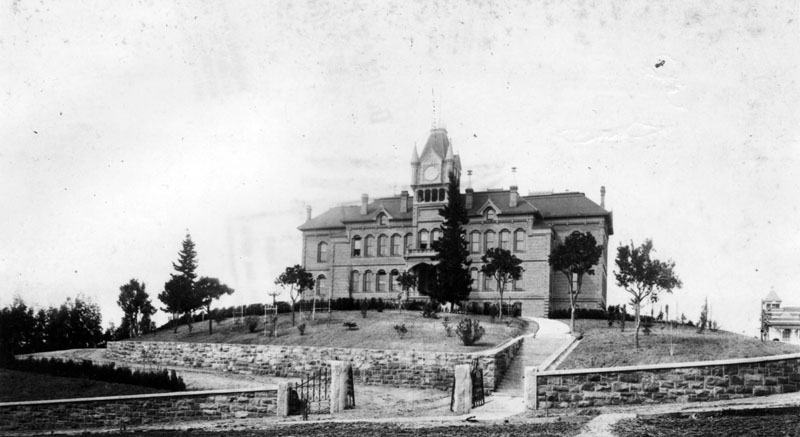 |
|
| (ca. 1882)* - Front view of the State Normal School, located at Grand and 5th Street on a hill that would later be occupied by the Los Angeles Central Library. |
Historical Notes In March 1881, after heavy lobbying by Los Angeles residents, the California State Legislature authorized the creation of a southern branch of the California State Normal School (which later became San Jose State University) in downtown Los Angeles to train teachers for the growing population of Southern California. The State Normal School at Los Angeles opened on August 29, 1882, on what is now the site of the Central Library of the Los Angeles Public Library system. |
 |
|
| (1882)#* – View showing the State Normal School on Fifth Street shortly after its construction. |
Historical Notes The new facility included an elementary school where teachers-in-training could practice their teaching technique on children. That elementary school is related to the present day version, UCLA Lab School. In 1887, the school became known as the Los Angeles State Normal School. |
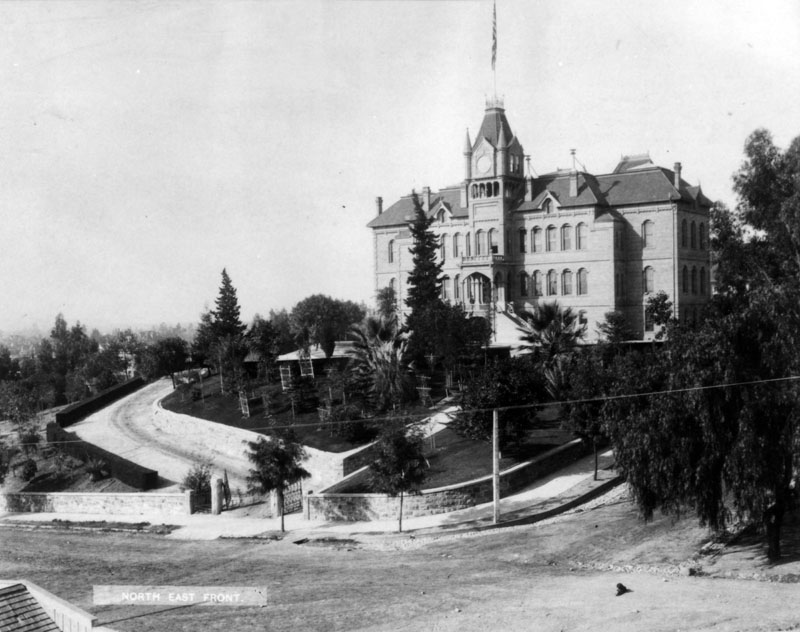 |
|
| (ca. 1893)* - Southwest corner view of the State Normal School, located at Grand and 5th Street. A long and winding driveway is located on the left side of the entrance, and a long flight of stairs (barely visible) is on the right; the school sits impressively on the last knoll of Bunker Hill, aptly dubbed "Normal Hill". |
Historical Notes After the demolition of this structure (1922), 5th Street was straightened and the remainder of the site was eventually occupied by the L.A. Public Library. |
.jpg) |
|
| (ca. 1905)^^ - The four-story Victorian-style Normal School building can be seen at center overlooking a beautiful courtyard. The building features steep gables, pointed towers and ceilings, a circular tower at left, and a square tower at right. A few other much smaller buildings can be seen at right. Legible signs include: "State Normal School". |
Historical Notes Through the years, the State Normal School was expanded and several new wings were added; the "new and improved" facility would eventually include an elementary school where the teachers-in-training could practice their teaching technique on real children.* |
 |
|
| (Early 1900s)* - Aerial view of the State Normal School, located at Grand Avenue and 5th Street. Because the school sat impressively on the last knoll of Bunker Hill, aptly dubbed "Normal Hill", there were two ways to get to the main entrance: either taking the long and winding driveway located on the left side, or a long flight of stairs on the right (partially covered by the trees), which was parallel to 5th Street. The beautiful brick building had numerous tall windows all around, several chimneys, gabled dormers, a tower with a balcony and ornate grill, a set of stairs on either side leading to the main doors, and beautiful landscaping all around. The large white building on the middle left is the Bible Institute, later to become the Church of the Open Door, that was located on Hope Street; the Key West Rooms and Apartments is visible on the lower left. |
 |
|
| (1904)* - Panoramic photo of teachers and student body of the California State Normal School, located at 5th Street and Grand Avenue in Los Angeles. |
Historical Notes By 1914 the little pueblo of Los Angeles had grown to a city of 350,000 and the school, whose enrollment far exceeded its capacity, moved to new quarters -- a Hollywood ranch off a dirt road which would later become Vermont Avenue.^^ |
UCLA is Born
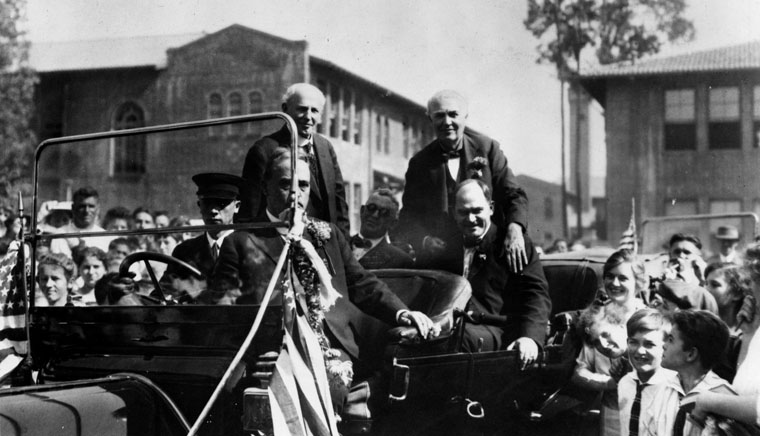 |
|
| (ca. 1915)* - Thomas Edison visits the Los Angeles State Normal School (the old Vermont Avenue campus, University of California). To Edison's left is the school's president, Jesse H. Millspaugh. |
Historical Notes In 1917, UC Regent Edward A. Dickson, the only regent representing the Southland at the time, and Ernest Carroll Moore, Director of the Normal School, began working together to lobby the State Legislature to enable the school to become the second University of California campus, after Berkeley. They met resistance from Berkeley alumni, Northern California members of the state legislature, and Benjamin Ide Wheeler, President of the University of California from 1899 to 1919, who were all vigorously opposed to the idea of a southern campus. However, David Prescott Barrows, the new President of the University of California, did not share Wheeler's objections and, in 1919, the Southern Californians efforts finally paid off.*^ |
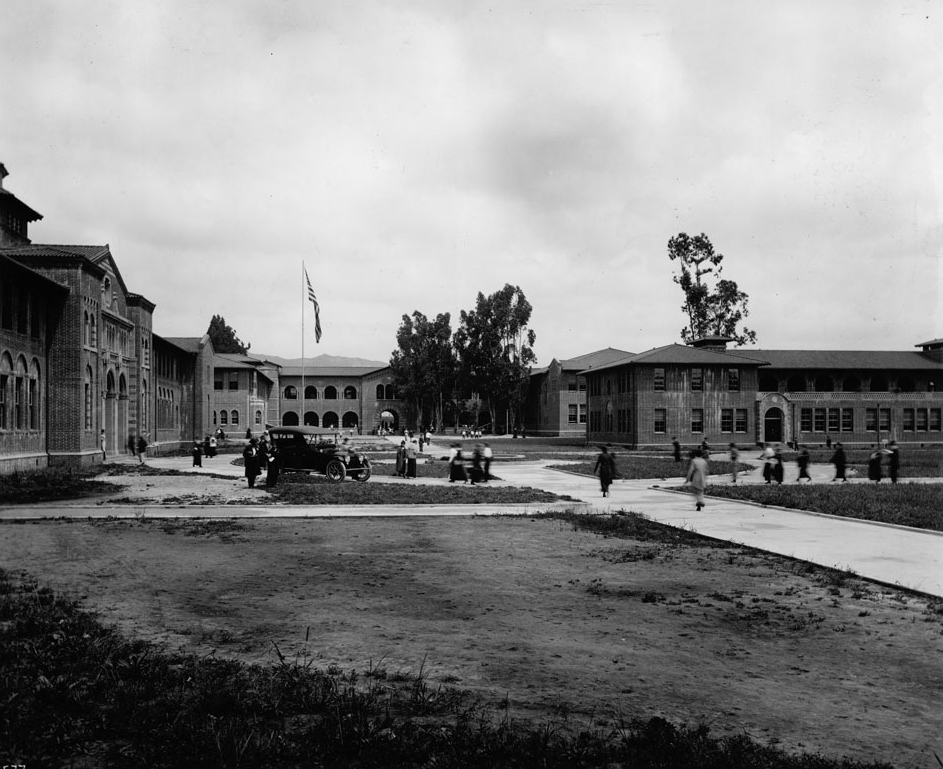 |
|
| (ca. 1919)^^ - Photograph of the campus of the University of California Los Angeles (UCLA) on north Vermont Avenue, later Los Angeles State College for a time, and Los Angeles City College. Surrounded by Romanesque brick architecture full of arches, an early automobile is parked in front of a flag pole which sports the American flag. Several people stand by it while others walk around on the campus walkways. |
Historical Notes On May 23, 1919, Governor William D. Stephens signed Assembly Bill 626 into law, which merged the Los Angeles Normal School with the University of California as the Southern Branch of the University of California. The same legislation added its general undergraduate program, the College of Letters and Science. The Southern Branch campus opened on September 15 of that year, offering two-year undergraduate programs to 250 Letters and Science students and 1,250 students in the Teachers College, under Moore's continued direction.*^ |
 |
|
| (ca. 1920)* - The ivy-covered Beaux-Arts style building with the flared polygonal dome (seen on the left) is Millspaugh Hall, the Administration building of the University of California, Southern Branch, located at 855 N. Vermont Ave. |
Historical Notes The cornerstone for Millspaugh Hall was laid on November 18, 1913; in September 1914, the school began its sessions in the new building. It was the center of student and administrative activity and occasionally an outdoor assembly area. The University of California, Southern Branch campus was laid out along a central axis, with the fine arts, domestic science, and library buildings facing the gymnasium, science building and teacher training school; the administration building (Millspaugh Hall) sat at the head of the group. The University of California, Southern Branch would eventually come to be known as the University of California, Los Angeles - or UCLA for short.* |
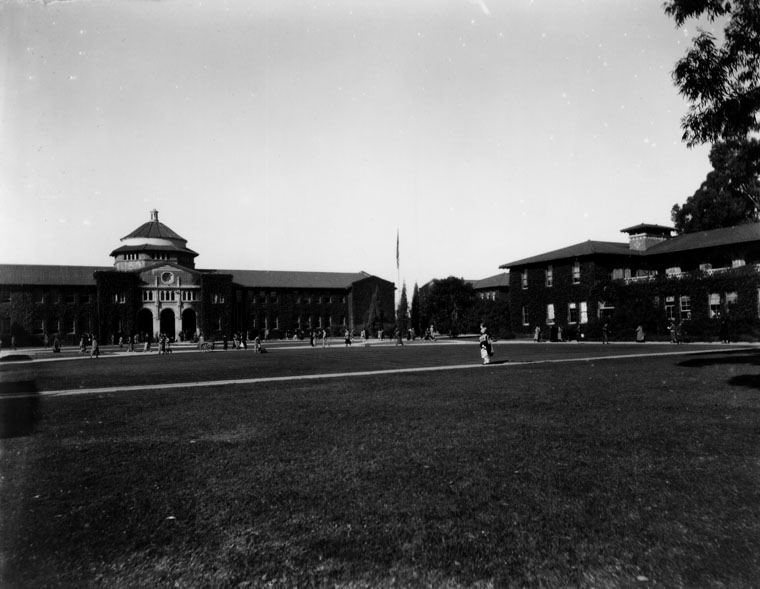 |
|
| (ca. 1922)* - Students on pathways in front of Millspaugh Hall at the old Vermont Avenue campus, Univeristy of California, Los Angeles, Southern Branch, later known as Los Angeles City College. Twelve of the buildings were designed by architects Allison and Allison and built in 1914. |
Historical Notes UCLA's first Commencement was in 1920 and was held in Millspaugh Hall of what was then the Los Angeles State Normal School on Vermont avenue. The institution conferred its first bachelor's degree in education in 1923, and its first bachelor of arts degree in 1925. The Class of 1928 was graduated in ceremonies held in the Hollywood Bowl, the site of UCLA Commencements for several years, even following the move from the Vermont Avenue campus to Westwood in 1929.^* |
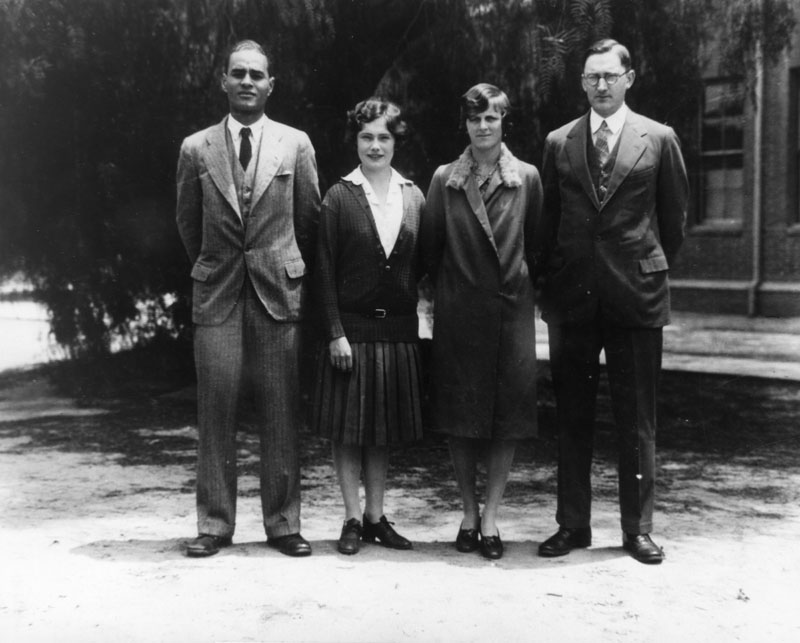 |
|
| (ca. 1927)* - Ralph Bunche, left, with a group at the Southern Branch of the University of California on Vermont Avenue. |
Historical Notes The valedictorian of his class at Jefferson High, Ralph Bunche was an all-around athlete who competed in football, baseball and track. He attended UCLA when the school campus was located on Vermont Avenue, playing basketball on an athletic scholarship. Later he helped to write the charter for the United Nations. Bunche won the Nobel Peace Prize in 1950 for his efforts in developing peace agreements in the Middle East.* |
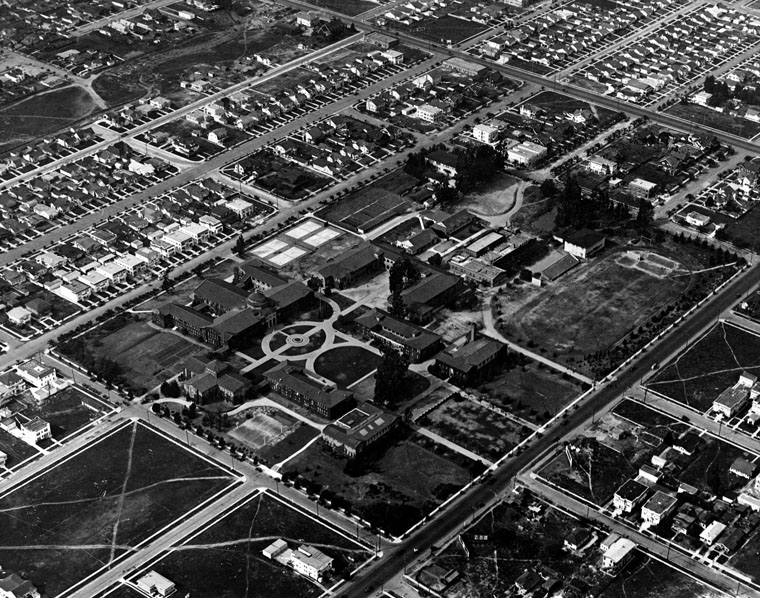 |
|
| (1922)* - Aerial view of the old Vermont Avenue campus of the University of California, Los Angeles, which later became Los Angeles City College. Vermont Avenue runs from the bottom of the photo to the right. |
Historical Notes The "Southern Branch" of the University of California was no longer merely a teacher's college but an institution that offered two years of instruction in Letters and Science. Third- and fourth-year courses were soon added, the first class of 300 students was graduated in 1925, and by 1927 the Southern Branch had earned its new name: University of California at Los Angeles (the "at" became a comma in 1958). As the student population of the University continued to increase, the need for a new site became obvious and the search was soon under way for a permanent home for UCLA. |
* * * * |
Development of Westwood
Historical Notes Westwood and UCLA were developed on the lands of the historic 'Wolfskill Ranch', a 3,000-acre parcel that was purchased by Arthur Letts, the successful founder of the Broadway, and Bullock's department stores, in 1919. Upon Arthur Lett's death, his son-in-law, Harold Janss, vice president of Janss Investment Company, inherited the land and started to develop the area in 1922.*^ |
.jpg) |
|
| (1922)* - Aerial view of Westwood and surrounding area looking north. Santa Monica Boulevard runs horizontally at bottom of photo while a tree-lined Wilshire Boulevard runs from left to right at center. Beverly Glen, not yet constructed here, will run from lower-left, under Santa Monica Boulevard bridge, up north to the Wolfskill ranch house (seen at center-left) on Wilshire Boulevard. |
Historical Notes The view above, from about the time of the Letts purchase, shows the land with the Wolfskill ranch house (center left), located on what is today the northwest corner of Wilshire Boulevard and Beverly Glen. |
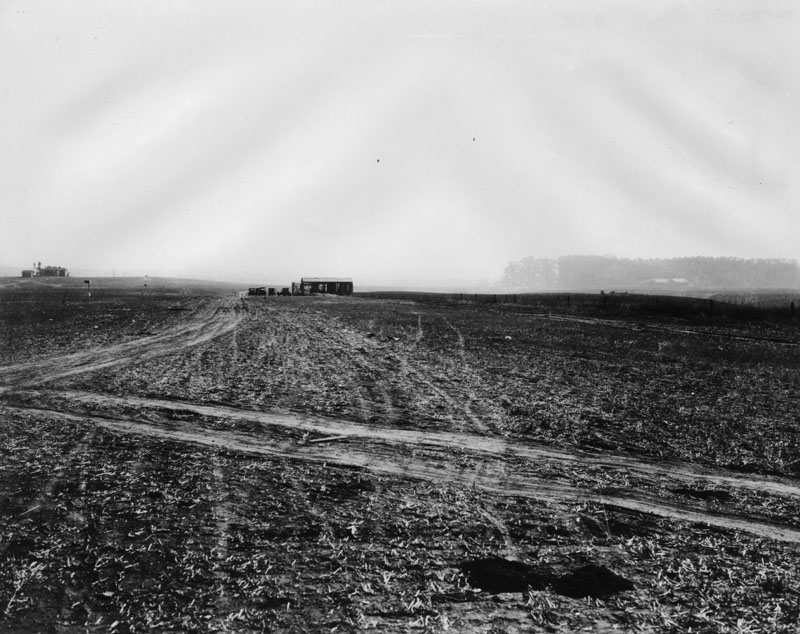 |
|
| (ca. 1924)* - View of part of the old Wolfskill Ranch, also known as the Rancho San Jose de Buenos Aires. The house, shown here on the extreme left, occupied the present corner of Wilshire Boulevard and Beverly Glen, and UCLA occupies part of the rancho. |
 |
|
| (1924)* - The old John Wolfskill home, also known as the Rancho San Jose de Buenos Aires. The house was located at the present corner of Wilshire Boulevard and Beverly Glen. |
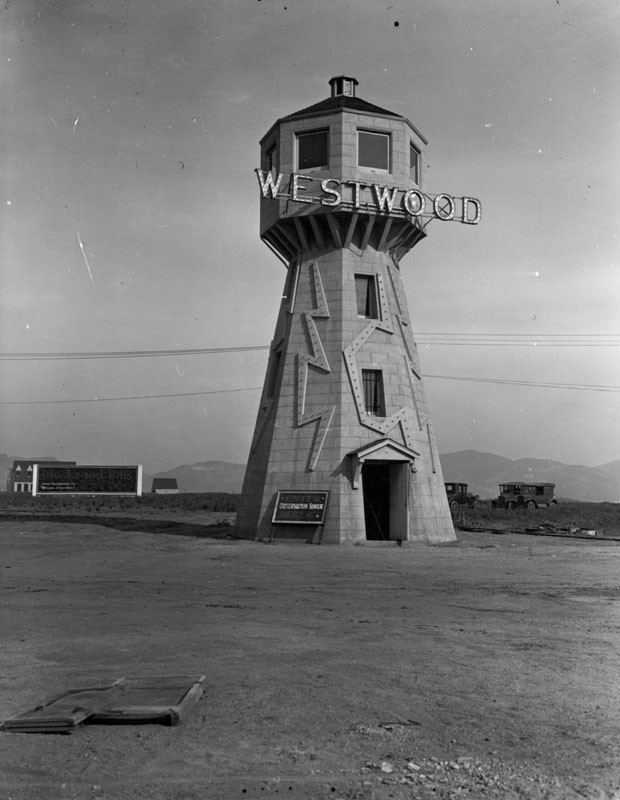 |
|
| (ca. 1924)* - View showing an observation tower in Westwood at Beverly Glen and Wilshire Boulevards. It has a sign, "Westwood" with lightbulbs, and little else surrounds it. |
Historical Notes Built by the Janss Investment Corporation in the 1920s, this oddly shaped tower was located on the northeast corner of Wilshire and Beverly Glen Boulevards. It stood at 420 feet above sea level, making it the highest point on Wilshire Boulevard at the time and was used primarily as a landmark advertisement. At night, the lightning bolts along the sides and the 'WESTWOOD' sign would light up and be seen for miles. Potential home owners were allowed to climb the tower to get a better view of the new community and identify the lot they would like to purchase.^# |
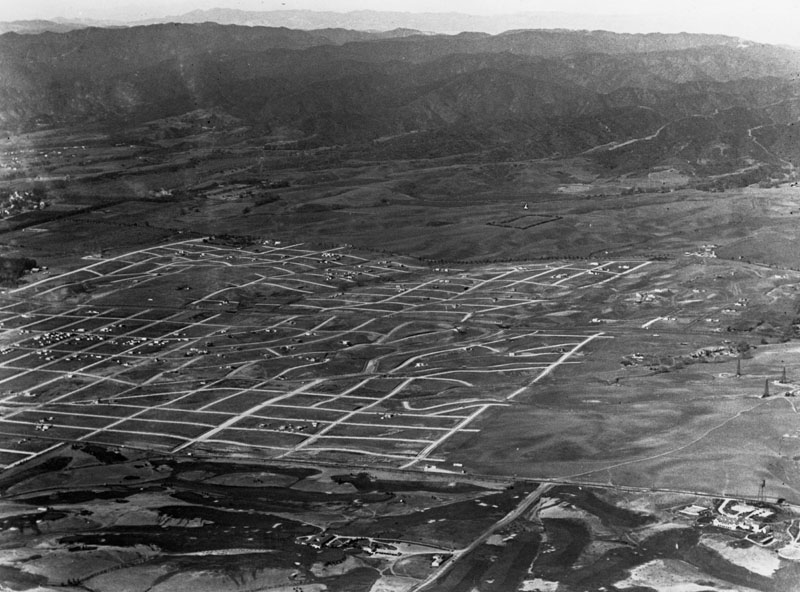 |
|
| (1924)* - View of the new development reaching from Wilshire on the north to Pico on the south and from Westwood Blvd on the west to Fox Hills Drive on the east, with a further small section running SW from Patricia and Pico. |
Historical Notes The large empty parcel, upper left, within the platted area is the Wolfskill ranch house, on the P.E. route, at the T-junction with Overland Ave, standing alone on twenty-five plus acres. The Harold Lloyd Motion Picture Company's Westwood studio ranch occupied this site a bit after this photo was taken. The northern portion was sold off to build the Saint Paul the Apostle RC church and school circa 1930. Lloyd's declining fortunes caused him to sell the rest to the LDS church in 1937. The church finally built the LDS Temple there in 1956.^# |
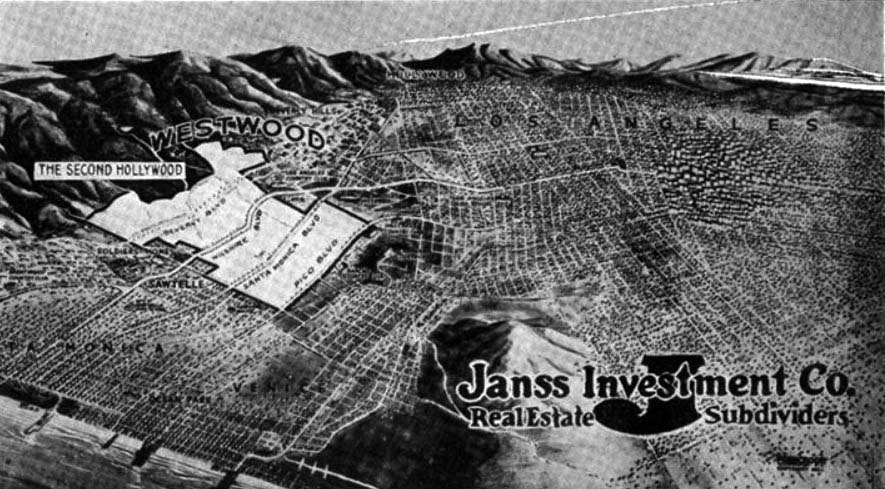 |
|
| (ca. 1925)^#^ – Photo of the Janss Real Estate map for its new westside subdivision. The Westwood development area was billed as “The Second Hollywood”. |
Historical Notes In 1925, in a deal to get the University of California, Los Angeles built, the Janss Investment Company sold 375 acres to the cities of Los Angeles, Santa Monica and Beverly Hills at the bargain price of $1.2 million — about a quarter of its value. The cities, whose voters had passed bond issues to pay for the site, turned around and donated it to the state. While the UCLA campus was being built, Janss Investment Company went to work developing the Westwood Village commercial area and surrounding residential neighborhoods.*^ |
1st Structure on the UCLA Campus (Arroyo Bridge)
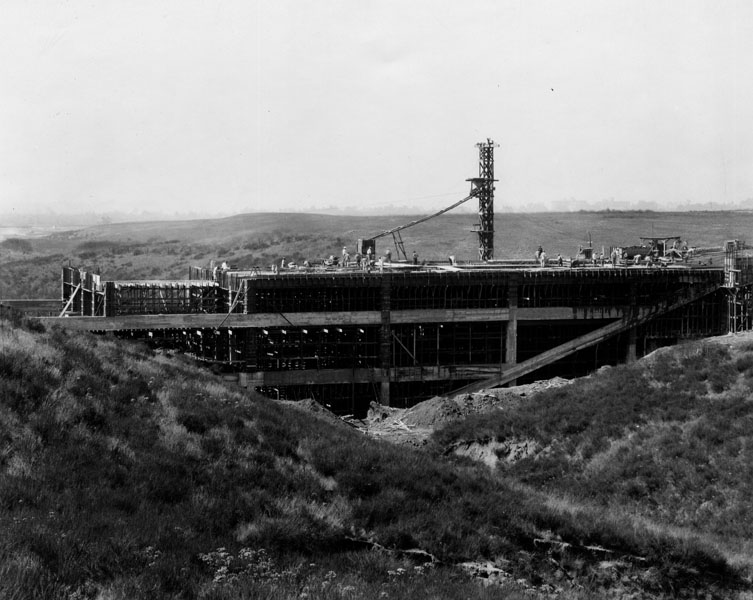 |
|
| (1927)* - Construction of the UCLA Bridge. This was the first structure built on the new Westwood campus |
Historical Notes In May 1927, ground was broken at UCLA’s new Westwood campus and the first priority was to construct a bridge to cross the deep arroyo. The bridge was necessary for transporting construction supplies over the ravine that divided the east and west parts of the site. |
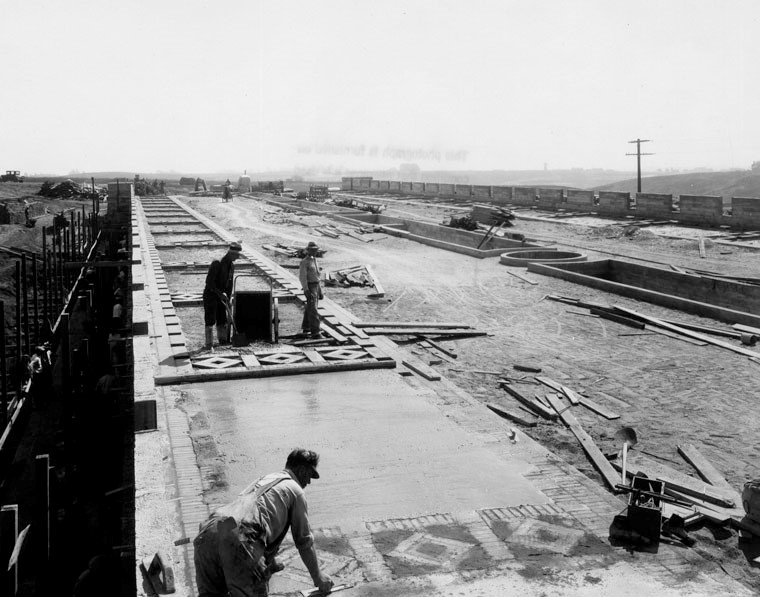 |
|
| (1927)* - Workers are seen laying sidewalk on the new Arroyo Bridge. |
Historical Notes The Arroyo Bridge was dedicated in a ceremony officiated by Gov. C. C. Young on Oct. 23, 1927, marking the completion of the first structure on campus.^*^ |
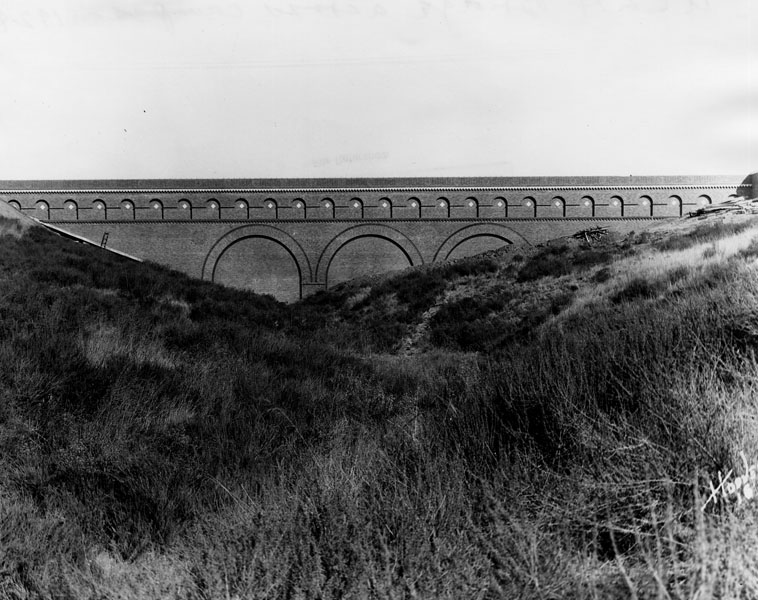 |
|
| (1927)* - Side view of the new UCLA Bridge (aka Arroyo Bridge). This was the axial link between the main quad and other buildings across an arroyo. |
Historical Notes Modeled after the Roman aqueducts by University of California supervising architect George W. Kelham, the bridge was necessary for transporting construction supplies over the chaparral-covered ravine and was originally intended to be UCLA's main entryway. Mules pulled materials including cement sacks, lumber and bricks over the Arroyo Bridge from the east entrance on Hilgard Avenue.^ |
 |
|
| (1927)^x^ - Gov. C.C. Young cuts the ceremonial ribbon at the dedication of the Arroyo Bridge, UCLA’s first structure at Westwood. Student Helen Fitch ’30 handed him the honorary shears. To the right, holding his hat, stands UCLA student body President Tom Cunningham ’28. UC Regent Edward A. Dickson observes from the far right. |
Historical Notes Hailed as the "avenue to the future," the $100,000 Arroyo Bridge was dedicated at a ceremony officiated by Associated Students President Thomas J. Cunningham and attended by California Gov. C.C. Young on October 22, 1927, officially marking the completion of the first structure on campus. "In opening this bridge, we are opening the portals for a new era in the history of the university," Cunningham said.^ |
.jpg) |
|
| (1929)* - View looking west showing the full extent of the Arroyo Bridge with the twin towers of Royce Hall seen in the distance. |
Historical Notes The reinforced concrete walls of the bridge contained three huge arches, and Kelham's Romanesque design featured intricate rosette and diamond patterns of carved limestone and inlaid red brick, with decorative parapets and a series of smaller arches running along the upper portion of the structure. It stood approximately 300 feet long, 75 feet wide and 50 feet above the arroyo.^ |
.jpg) |
|
| (1929)* - Students cross the Arroyo Bridge on their way to and from classes and the library. |
Historical Notes Over the years, the bridge has become a storied part of UCLA's history. During the Great Depression, it provided shelter for impoverished students. In wartime, when the Japanese were targeting the California coast via submarine, enough food was reportedly stored beneath it to feed 50,000 people — in case of attack.^ |
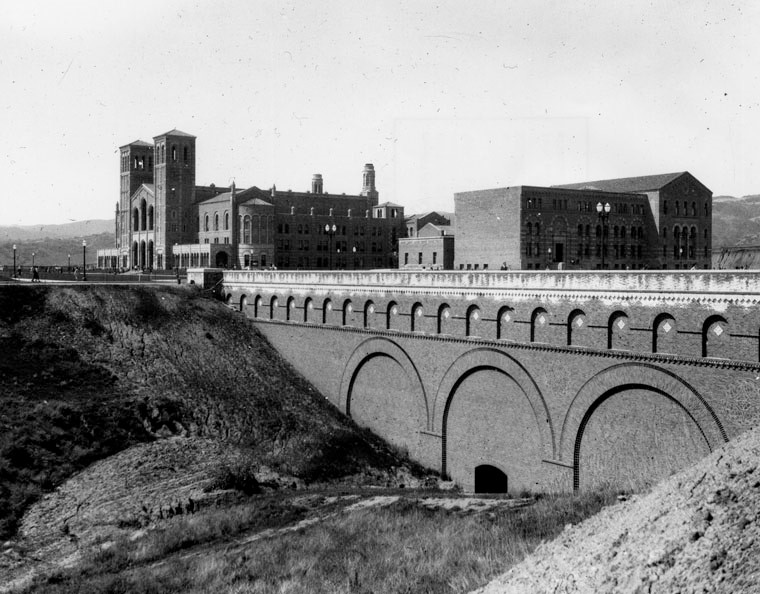 |
|
| (1929)* - Looking northwest toward the Arroyo Bridge which connects Hilgard Avenue to the main campus quadrangle at U.C.L.A. The newly constructed Royce Hall and Haines Hall are seen in the background. |
Historical Notes In the summer of 1947, the gully was filled to increase the amount of useable property on the campus. Today, the bridge’s arches remain hidden underground at Dickson Plaza.^*^ |
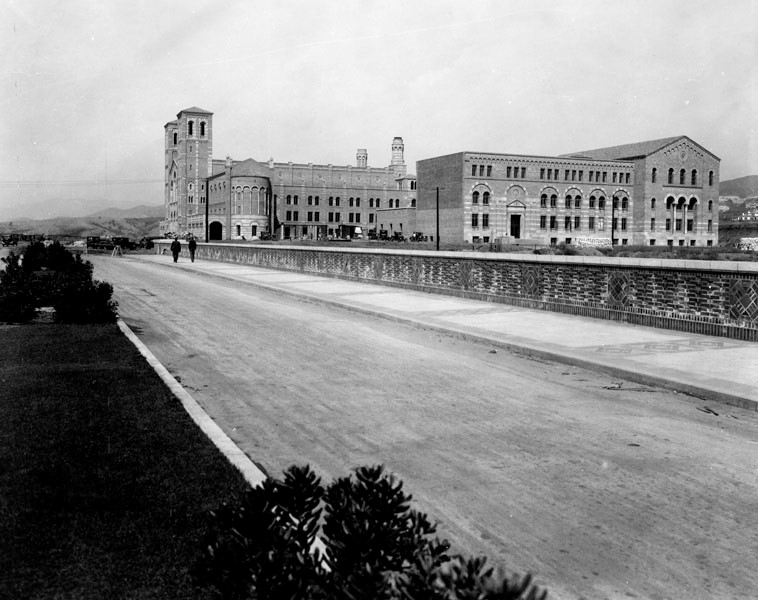 |
|
| (1929)* - Street level view showing two men walking across the Arroyo Bridge with the center median at left. Seen in the background are Royce Hall and Haines Hall. |
Historical Notes Today, the bridge's arches remain hidden underground at Dickson Court, largely ignored by the many crossing it daily. A sign cautions a weight restriction, and it continues to be inspected to meet safety and earthquake standards.^ |
Construction of the 1st Buildings on the UCLA Campus
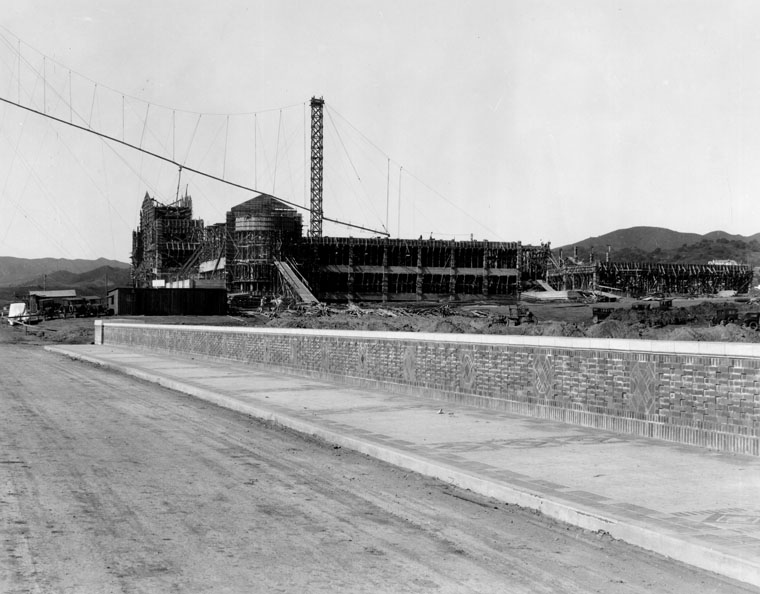 |
|
| (ca. 1928)* - View looking northwest as seen from the Arroyo Bridge showing the construction of Royce Hall. Note the type of cranes used during the 1920s and 1930s. |
Historical Notes Ground was broken on the new campus in Westwood on September 27, 1927. The original four buildings were the College Library, Royce Hall, the Physics-Biology Building, and the Chemistry Building (presently Powell Library, Royce Hall, the Humanities Building, and Haines Hall, respectively), arrayed around a quadrangular courtyard on the 400 acre campus. George W. Kelham of San Francisco was the supervising architect, assisted by David Allison of the Los Angeles firm Allison & Allison. Allison, who was also the designer of the Vermont Avenue campus, envisioned the Romanesque style of the Westwood campus.*^ |
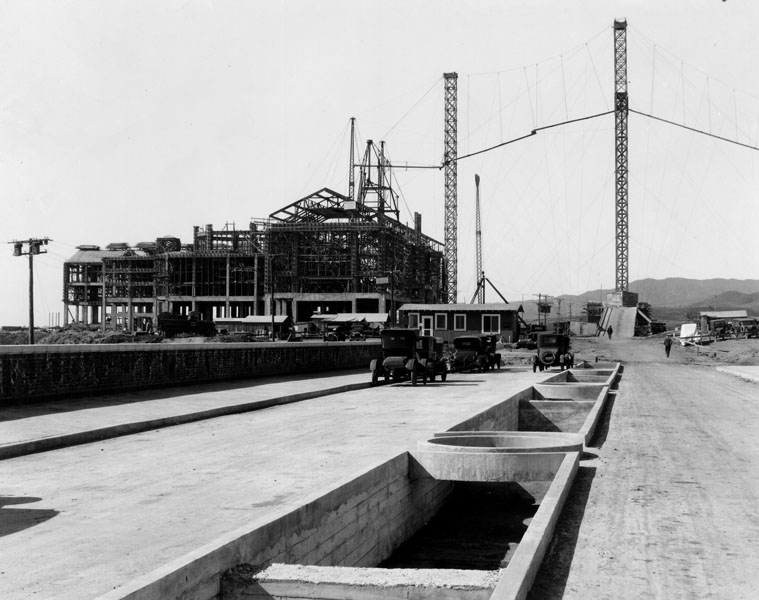 |
|
| (ca. 1928)* - View showing the construction of the library, now the Lawrence Clark Powell Library (originally called College Library), from a still yet to be completed Arroyo Bridge. |
Historical Notes Built between 1927 and 1929, the Powell Library was constructed in Italian Romanesque Revival style and designed by architect George W. Kelham.* |
 |
|
| (1928)* - View looking northeast showing the construction of the first four buildings on UCLA's new campus. |
Historical Notes Because the rolling terrain of the campus suggested northern Italy, a Romanesque or Italian Renaissance style of architecture was adopted, featuring red brick, cast stone trim, and tile roofs. Many of the early buildings were modeled from churches and universities in Bologna, Milan, and Verona.** |
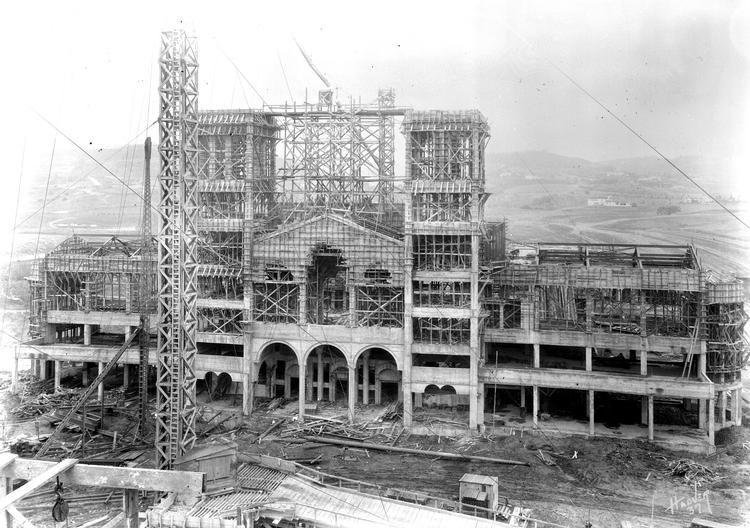 |
|
| (1928)*# - View showing Italian Renaissance style Royce Hall under construction with cranes and scaffolding. |
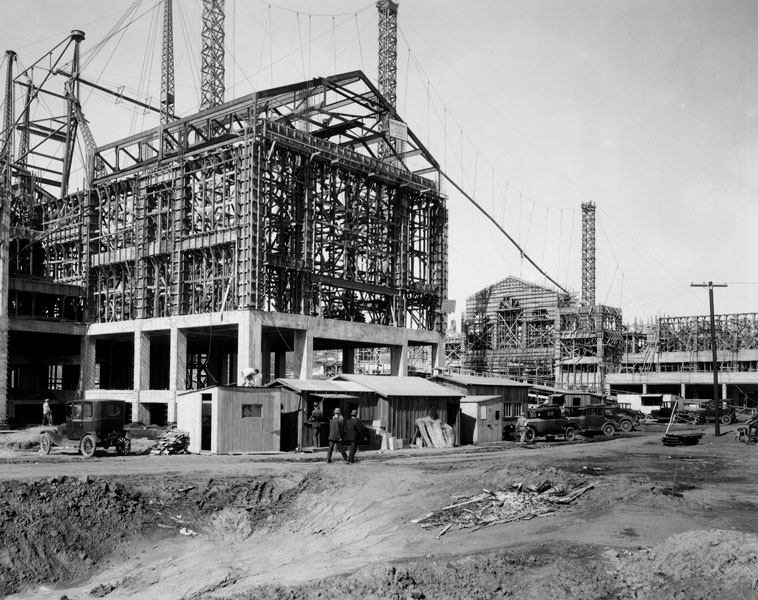 |
|
| (ca. 1928)* - Two men wearing suits walk past the construction site of the College Library (presently Powell Library). On the right can be seen Royce Hall, which is still under construction. |
 |
|
| (ca. 1928)* - View looking from the southwest from the propagation fields showing the UCLA campus starting to take form. |
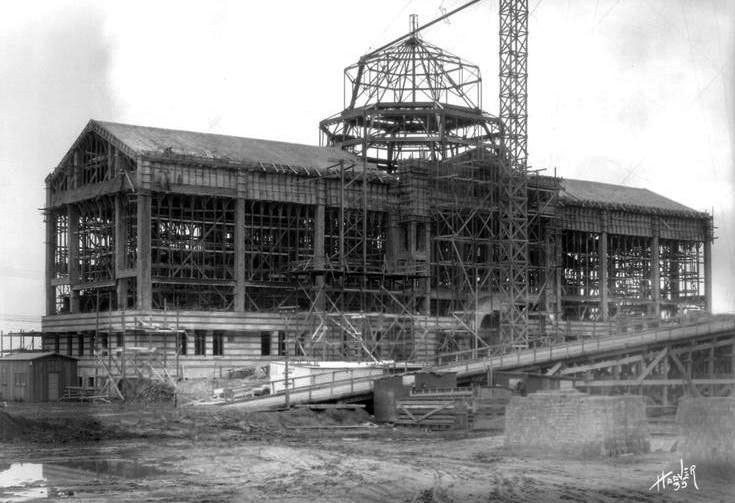 |
|
| (1928)*# - View showing the early stages of construction of Powell Library, showing the steel beems of its central tower. The building is surrounded by and filled-in with scaffolding. |
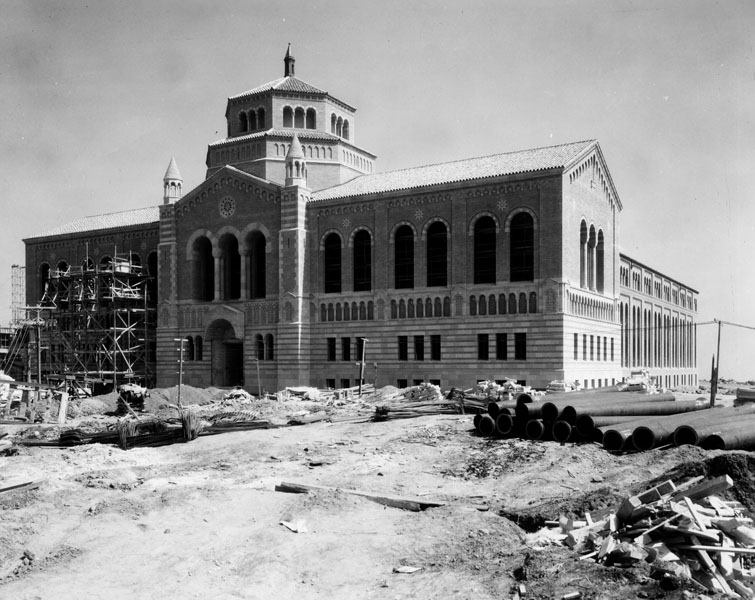 |
|
| (1928)* - The Lawrence Clark Powell Library (originally College Library) nearing completion. |
Historical Notes Powell Library (originally called College Library) is named for Lawrence Clark Powell, the University Librarian at UCLA from 1944 to 1961 and Dean of the Graduate School of Library Service from 1960 to 1966.*^ |
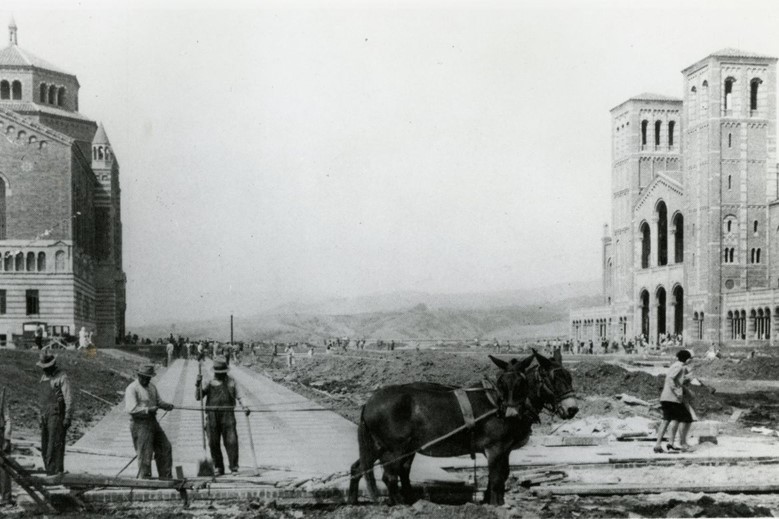 |
|
| (1928)*- Harnessing mule power to build the UCLA Campus. |
Then and Now
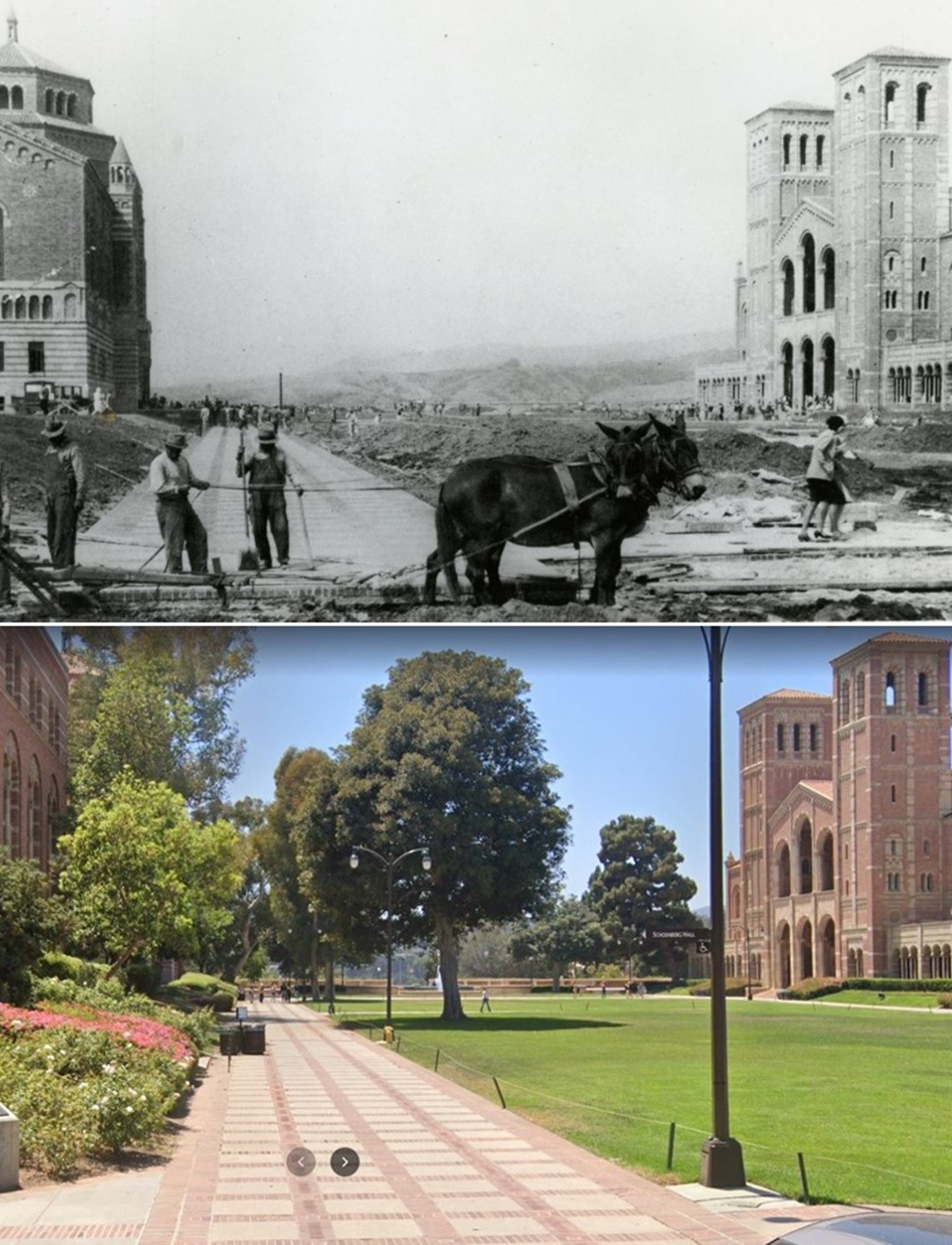 |
|
| (1928 vs. 2021)* - UCLA Campus Then and Now, Photo comparison by Jack Feldman. |
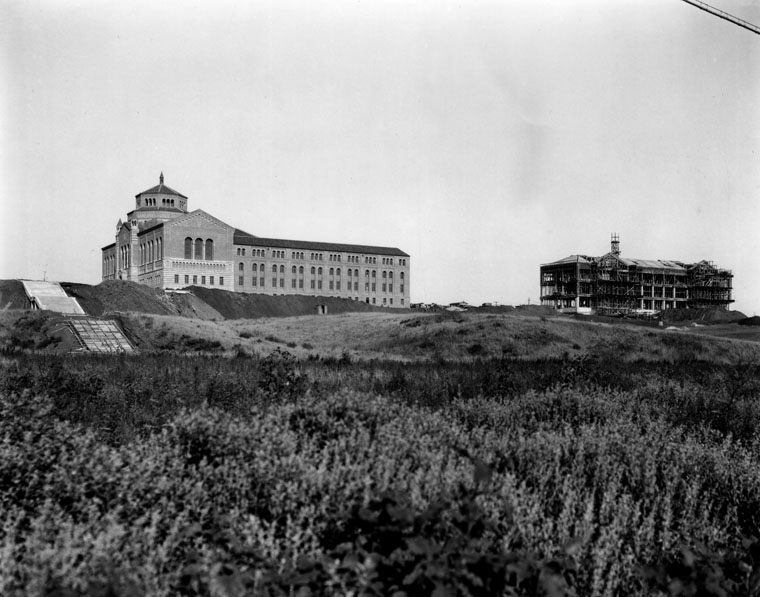 |
|
| (ca. 1928)* - View of the new UCLA Westwood campus. On the left is Powell Library. On the right is Moore Hall, still under construction (completed in 1930). Both buildings were constructed in a northern Italian Romanesque Revival style, designed by architect George W. Kelham. |
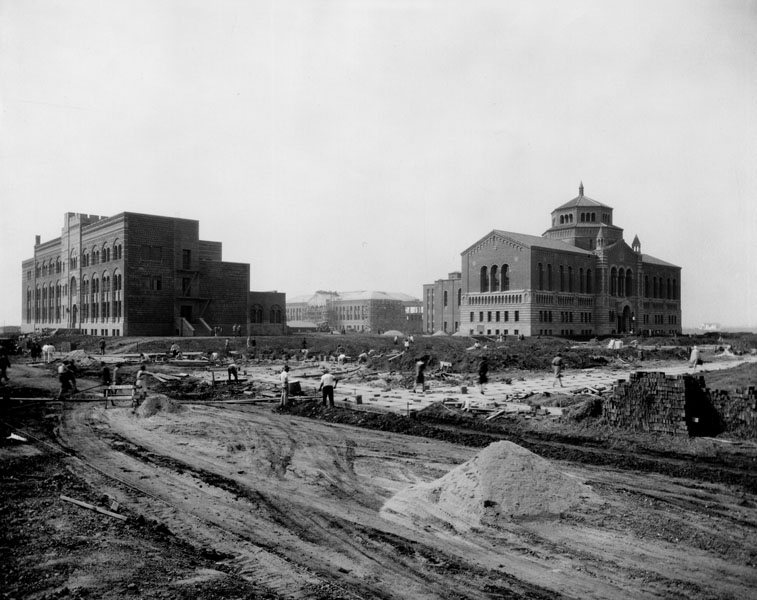 |
|
| (ca. 1928)* - This view shows the Physics Building on the left, Moore Hall in the rear center, and Powell Library on the right. The Physics Building, now Kinsey Hall, was built in 1928-29 and designed by Allison and Allison, Architects. |
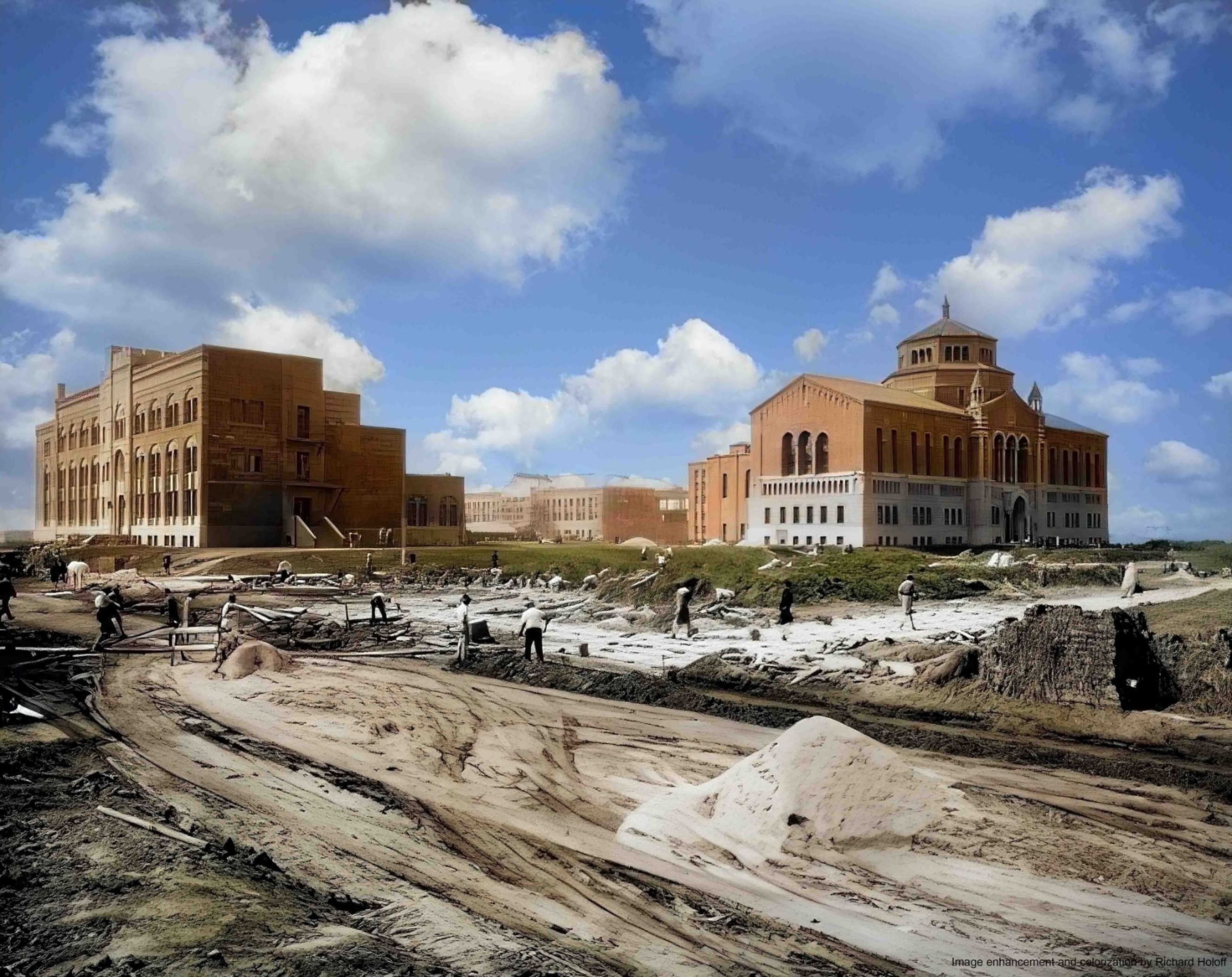 |
|
| (ca. 1928)* - This view shows the Physics Building on the left, Moore Hall in the rear center, and Powell Library on the right. The Physics Building, now Kinsey Hall, was built in 1928-29 and designed by Allison and Allison, Architects. Image enhancement and colorization by Richard Holoff. |
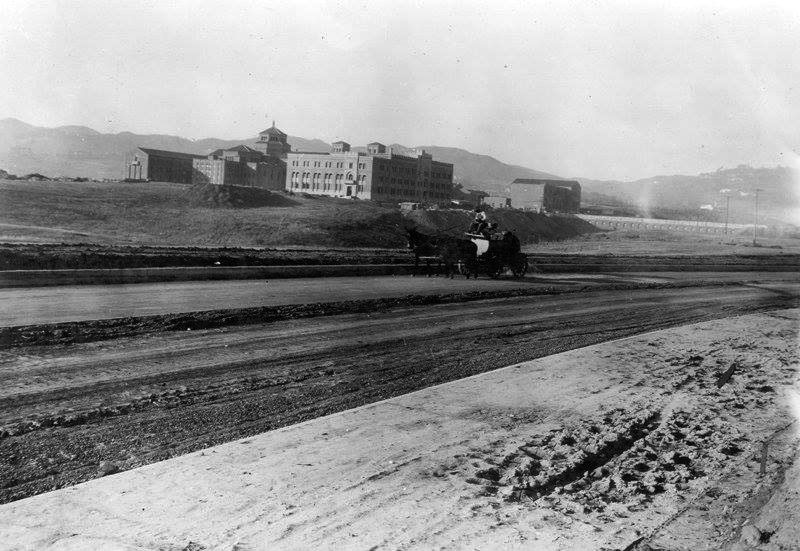 |
|
| (1928)^x^ – View looking northwest showing a mule-drawn water wagon on a dirt road (now Hilgard Ave) with the new UCLA campus in the distance. The bridge connecting Hilgard Ave to the main campus quadrangle is seen at center-right. |
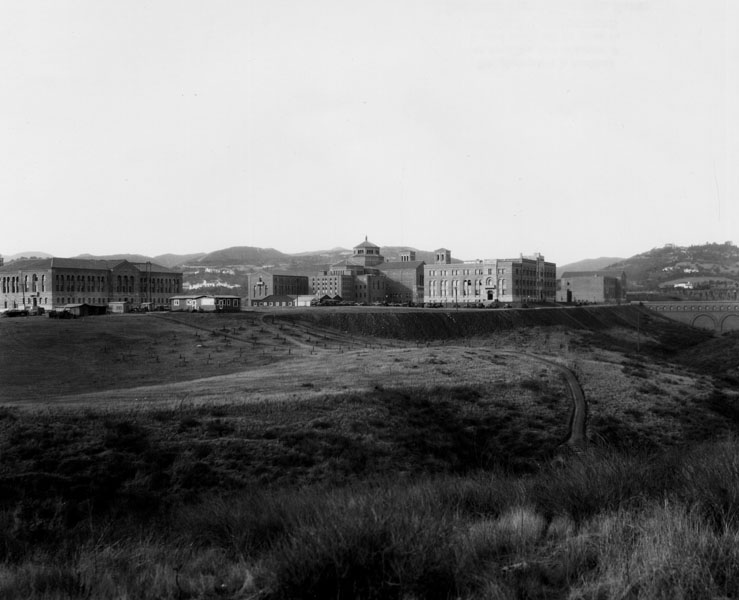 |
|
| (ca. 1928)* - Overall view of the Westwood campus buildings. On the left is Moore Hall, the Education Building, which was built in 1930. On the right is Powell Library, built in 1927-29. To the far right can be seen the bridge to Hilgard Avenue. |
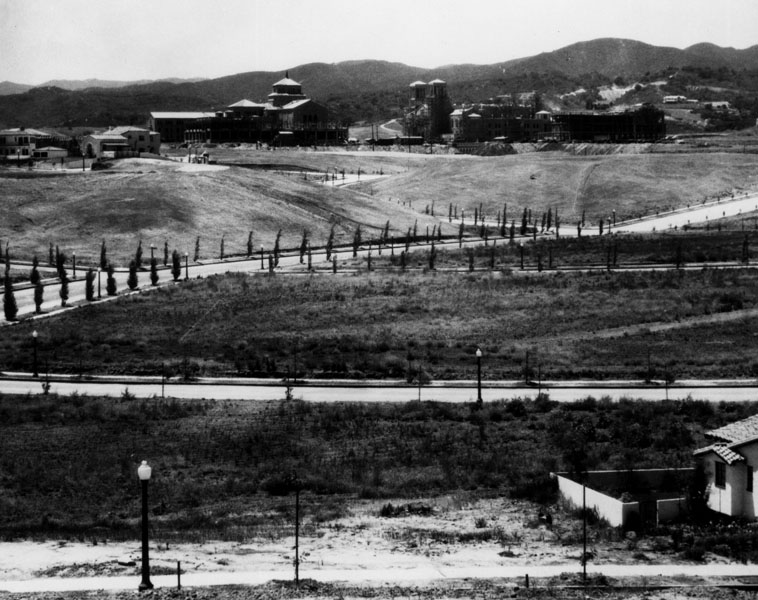 |
|
| (1928)* - View of the UCLA Westwood campus under construction, as seen from a residential area to the southeast. |
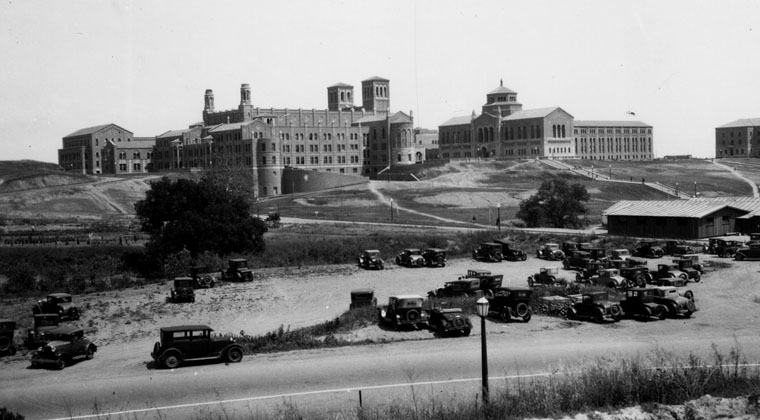 |
|
| (ca. 1929)* - Panoramic view looking southeast showing the UCLA campus. The building on the left is the backside of Royce Hall which was built in 1928-29. Building on the right is Powell Library, built in 1927-28. |
 |
|
| (ca. 1929)* - Aerial view of UCLA's Westwood campus while the campus was under construction in 1929, looking from Beverly Boulevard. Buildings pictured are the original four buildings: Royce Hall, built in 1928-29 and designed by Allison and Allison, Architects; College Library (presently the Lawrence Clark Powell Library) built in 1927-29, and the Chemistry Building (presently Haines Hall) built in 1928, both designed by architect George W. Kelham; and the Physics-Biology Building (presently the Humanities Building). These four buildings, arrayed around a quadrangular courtyard on the 400-acre campus, were constructed in a northern Italian Romanesque Revival style. On the right of the buildings is the bridge, designed by architect George W. Kelham, which crosses the gully to Hilgard Avenue. The Holmby Hills/Westwood area only had a few houses at this time. |
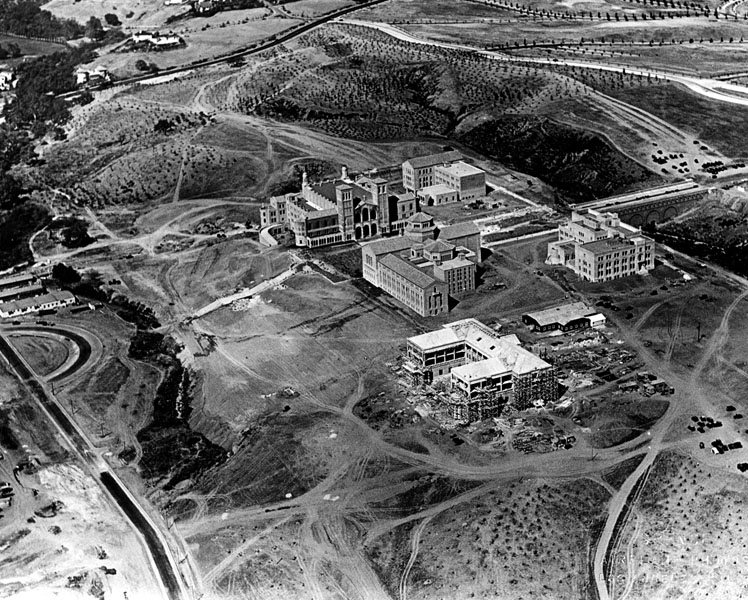 |
|
| (1929)* - Aerial view of UCLA's campus during construction, as seen from the southwest. View shows Royce Hall, left rear, the Physics building, center right, Haines Hall, right rear, Powell Library, center left, and Moore Hall (under construction), in foreground. Note the foliage northeast of the compass (upper-right). This was the nursery that grew most of the trees later used on compus. |
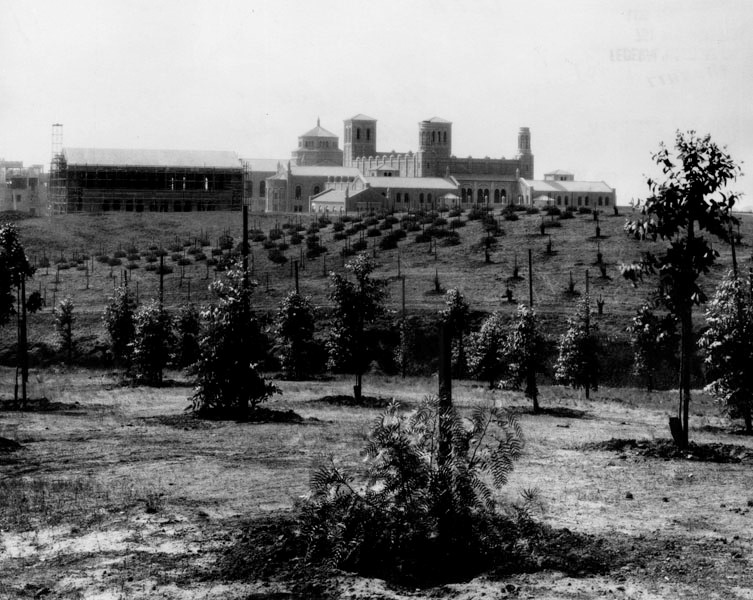 |
|
| (1929)* - View of the U.C.L.A. Westwood campus, as seen from the North Campus tree nursey. Nursery was growing the foliage which now decorates the area. In the background is Haines Hall, under construction on the left. |
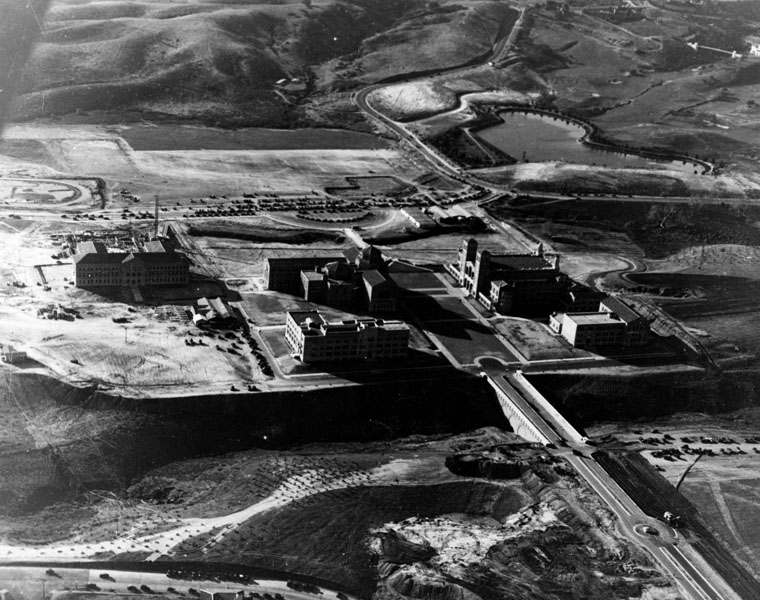 |
|
| (1929)* - An aerial view of the new UCLA Westwood campus, looking west, as construction was completed in 1929. Buildings from left to right: Moore Hall, then called the Education Building, left; Physics Building, foreground center; Powell Library, back center; Royce Hall, back right; and Haines Hall, far right. The main campus quadrangle appears at the center. In the foreground is the bridge which connected the campus to Hilgard Avenue. The gully which the bridge crossed was filled-in after World War II. |
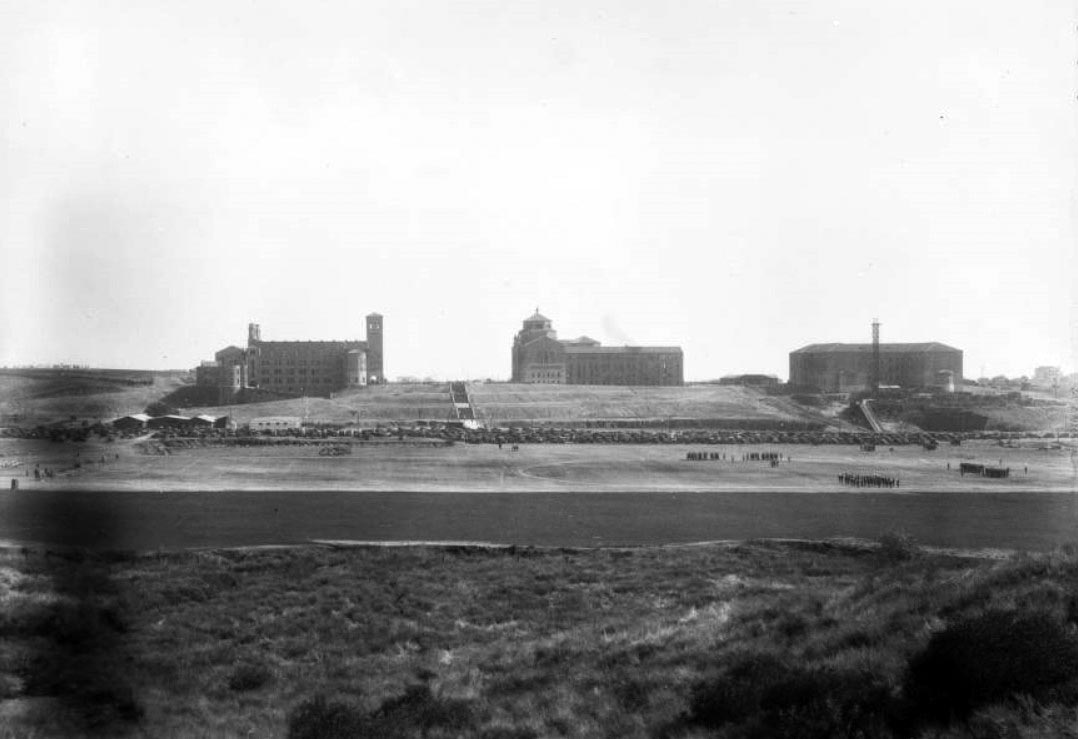 |
|
| (1929)#* – View looking east of the newly built campus of the University of California, Los Angeles (UCLA), showing the four original buildings at left, completed in 1929: Royce Hall, Powell Library, Kinsey Hall (now the Humanities Building), and Haines Hall. Another building is under construction at right. People and automobiles are also in the view. |
Janss Steps
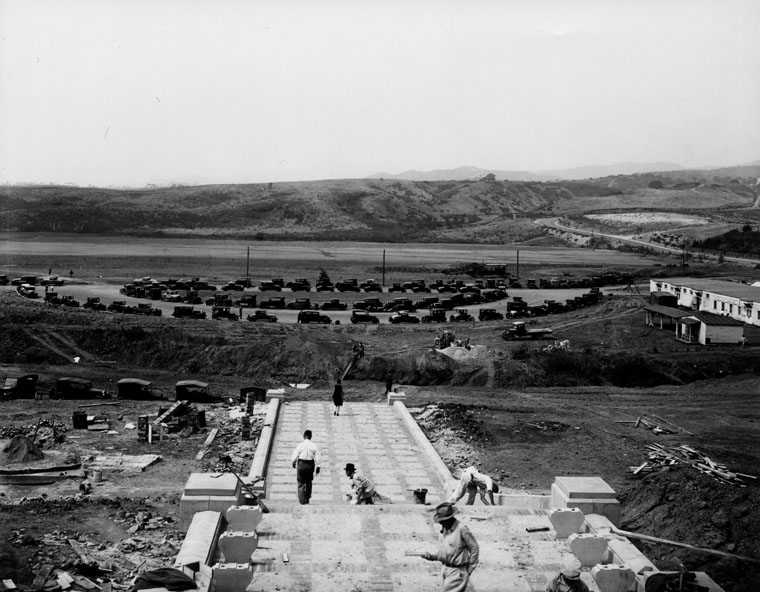 |
|
| (ca. 1928)* - View of the new UCLA Westwood campus looking west from the top of Janss Steps. Workers are seen constructing the steps. |
Historical Notes The UCLA campus's "Janss Steps" is named for two brothers, Harold and Edwin Janss of the Janss Investment Company who developed Westwood and also made it possible for UCLA to be built. The steps were donated to UCLA by the Janss brothers. |
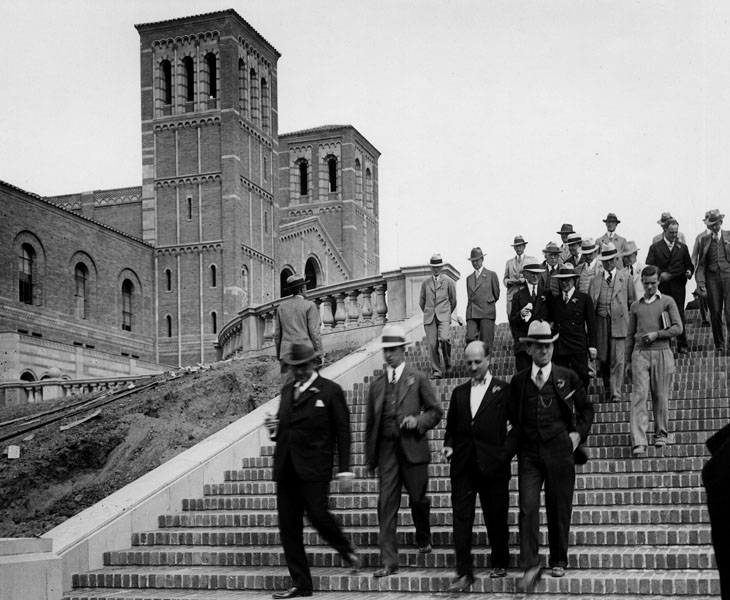 |
|
| (1929)* - Opening Day at the new UCLA campus in Westwood. A group of men are seem walking down the newly constructed Janss Steps with Royce Hall seen in the background. |
Historical Notes The Janss Steps were were constructed in 1928-29 and designed by architect George W. Kelham. |
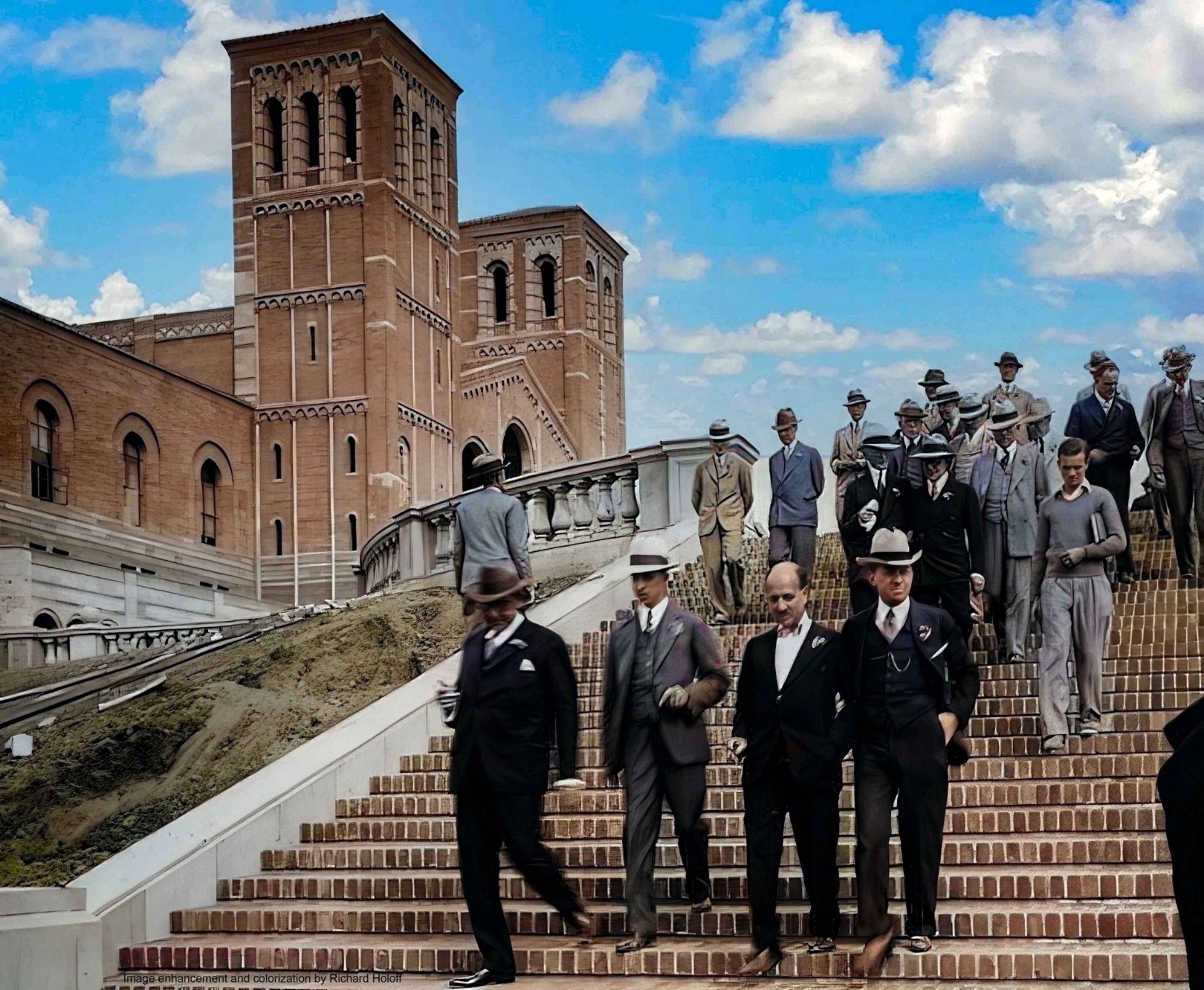 |
|
| (1929)* - Opening Day at the new UCLA campus in Westwood. A group of men are shown walking down Janss Steps, constructed in 1928-29 and designed by architect George W. Kelham. A partial view of Royce Hall is seen in the background. Image enhancement and colorization by Richard Holoff. |
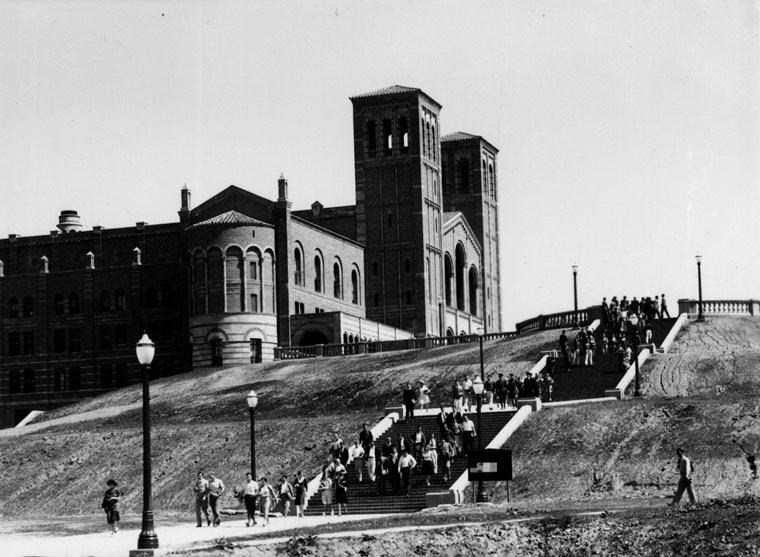 |
|
| (ca. 1929)* - View is looking northeast up Janss Steps, as the UCLA Westwood campus opens in 1929. The twin towers of Royce Hall appear in the background. Groups of people are walking down the steps. |
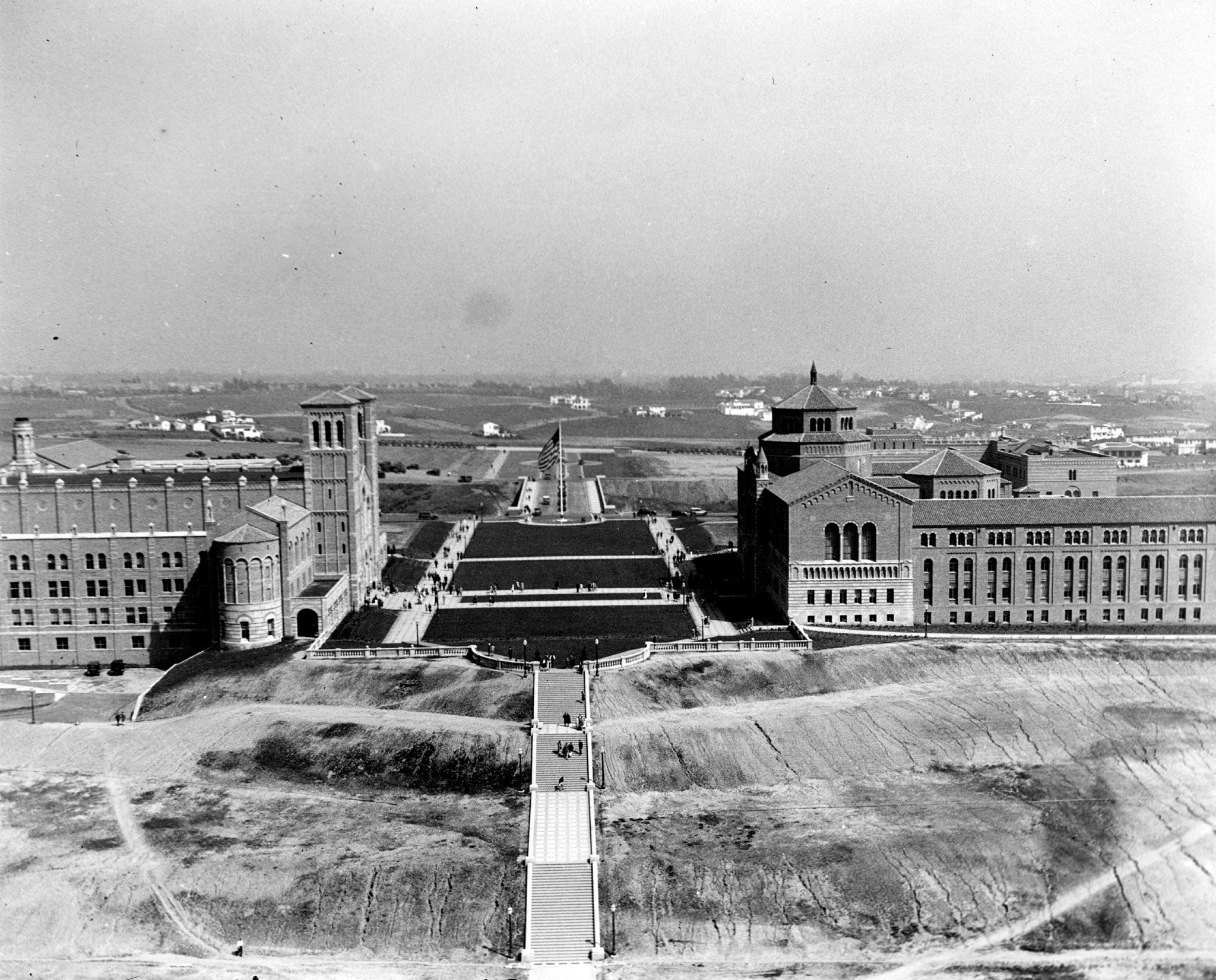 |
|
| (1930)*# - UCLA as viewed from the Goodyear blimp with the Janss Steps seen in the foreground. Landscaping would come in later. |
Then and Now
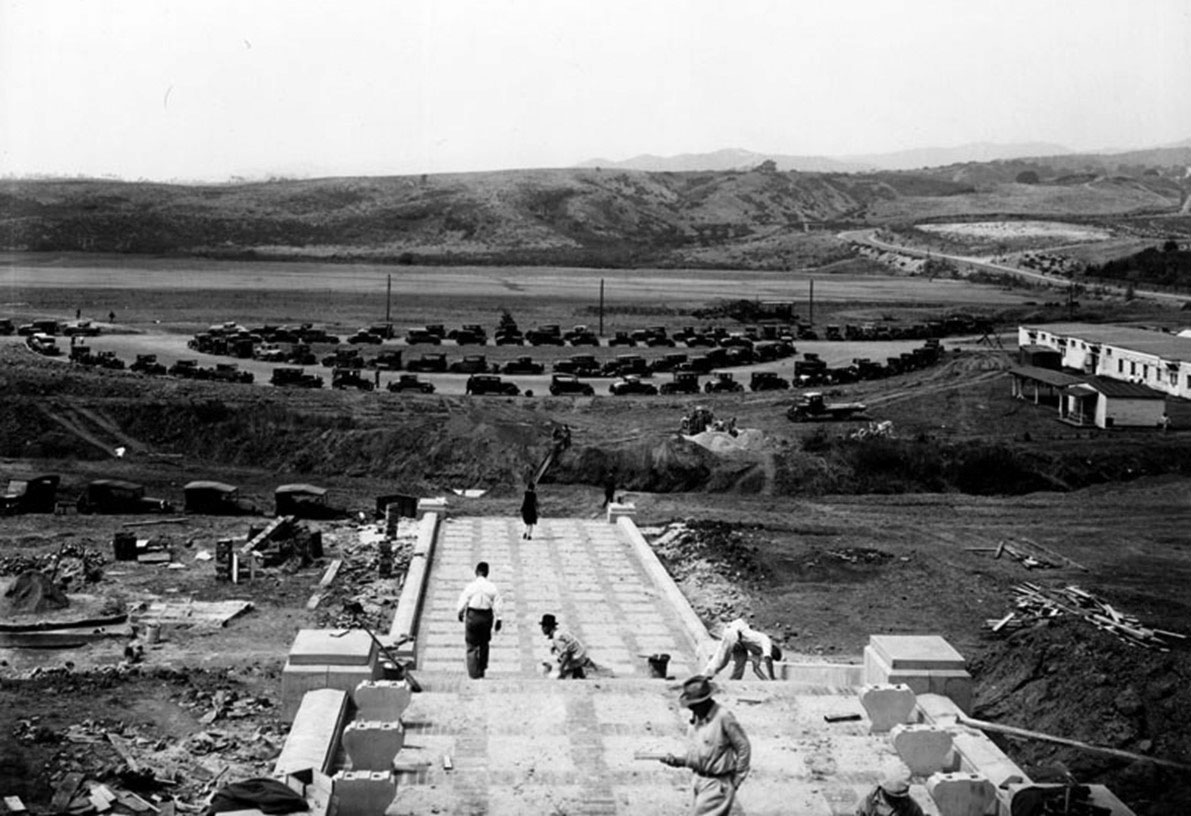 |
|
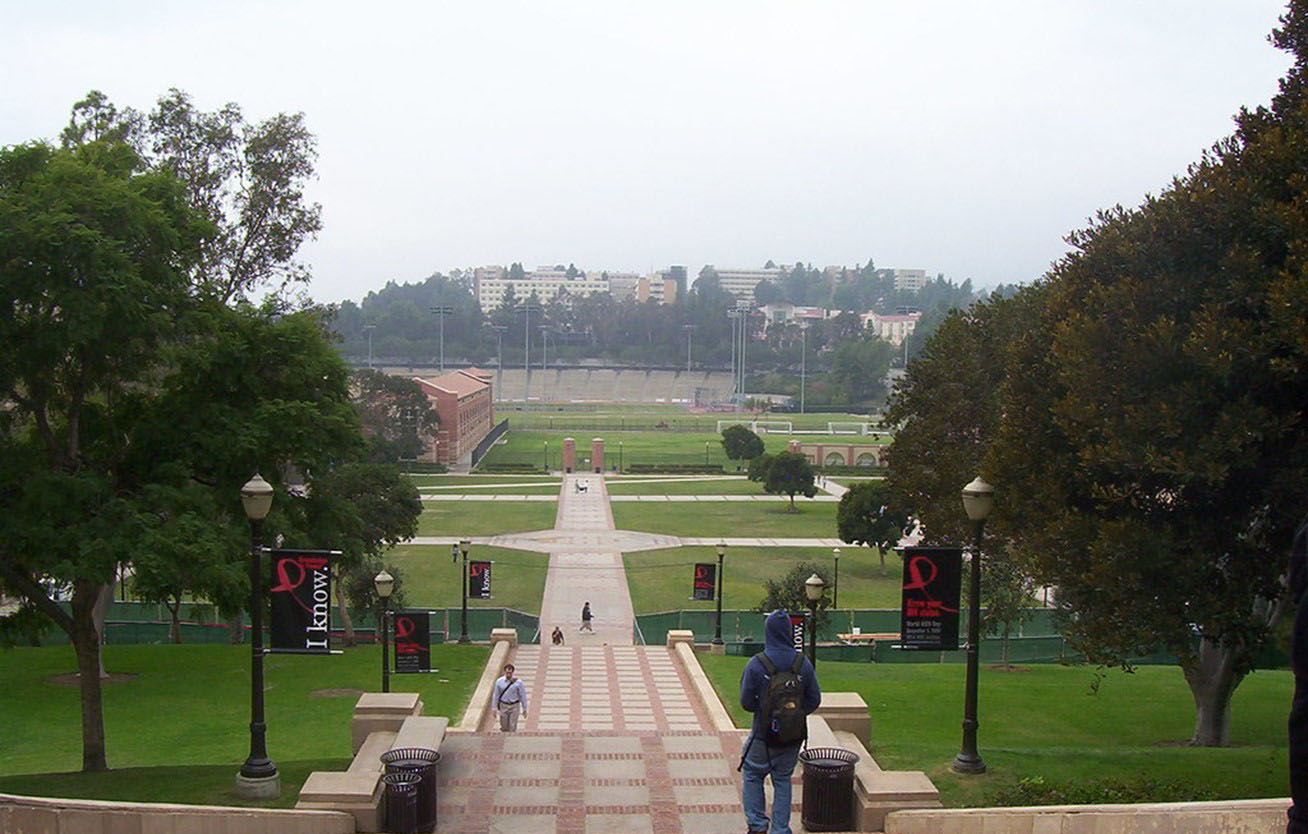 |
|
| Then and Now (1928 vs. 2007) - Janns Steps at UCLA - View looking West.^# |
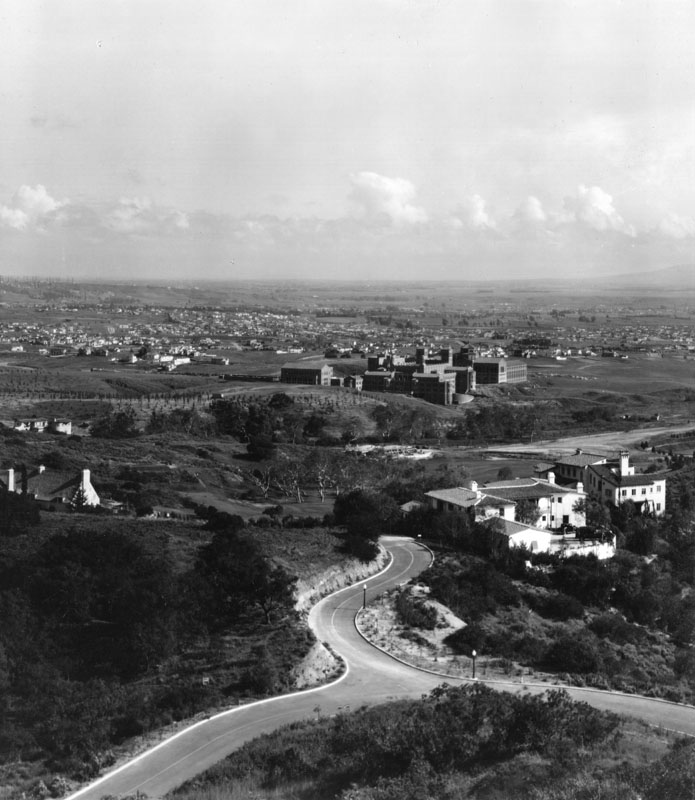 |
|
| (1929)* - Panoramic view of UCLA from Bel-Air in 1929, including Holmby Hills and Westwood. |
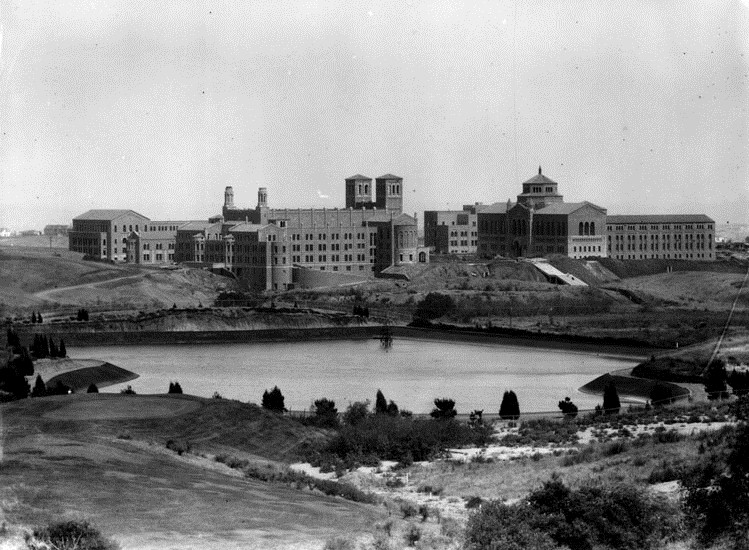 |
|
| (1929)* - View of the UCLA Westwood campus, at the time of its opening in 1929. View is looking southeast from the golf course of the Bel-Air Country Club. The body of water shown is the Sawtelle Pressure Break Reservoir. Click HERE to see more in Early LA Water Reservoirs. |
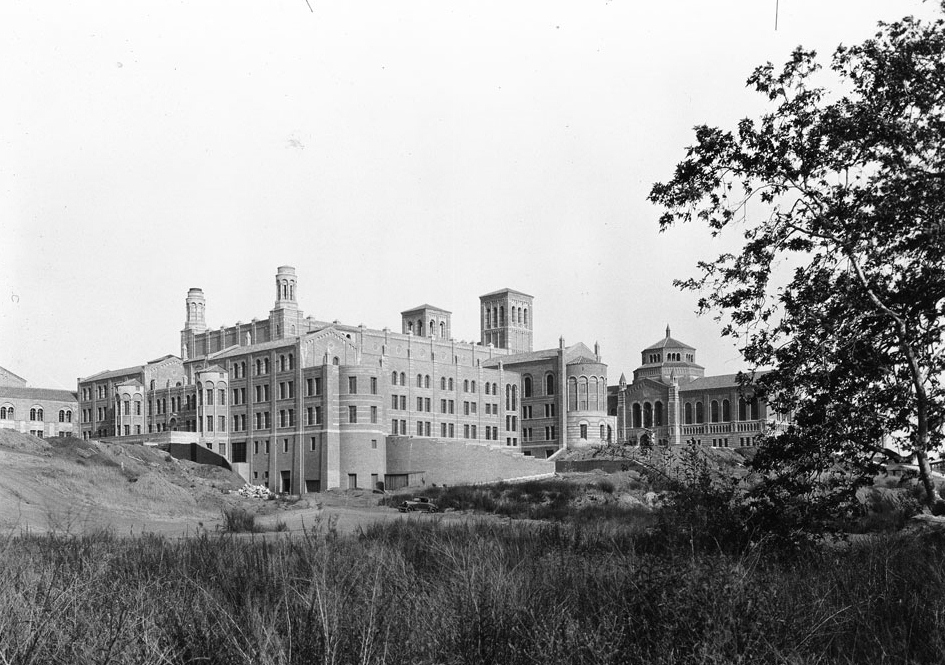 |
|
| (1929)^^ - View is looking from the northwest toward Royce Hall and Powell Library. |
 |
|
| (1929)* – Closer postcard view showing the side and back of Royce Hall, and parts of the other original buildings, completed in 1929. |
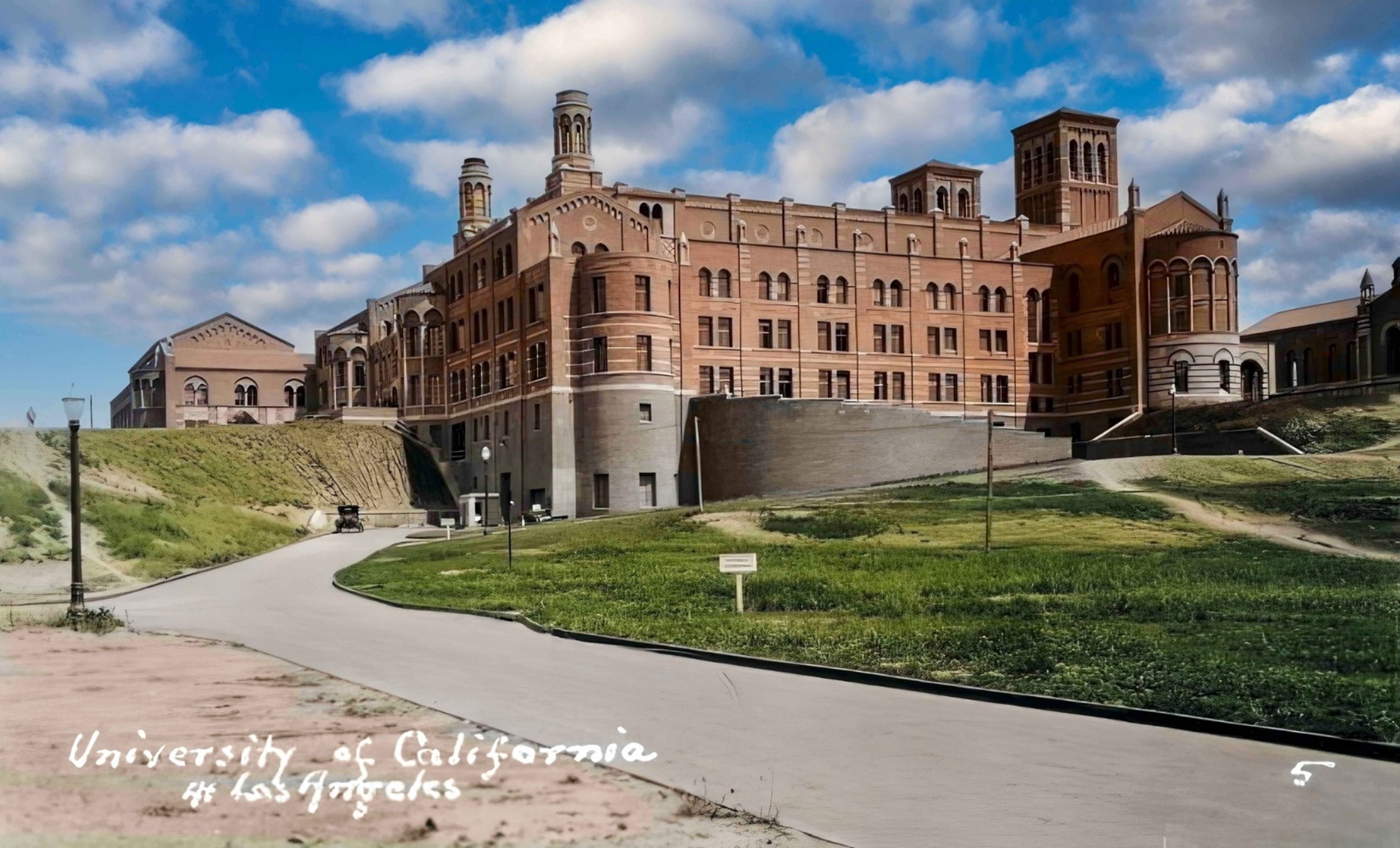 |
|
| (1929)* – Closer postcard view showing the side and back of Royce Hall, and parts of the other original buildings. Image enhancement & colorization by Richard Holoff. |
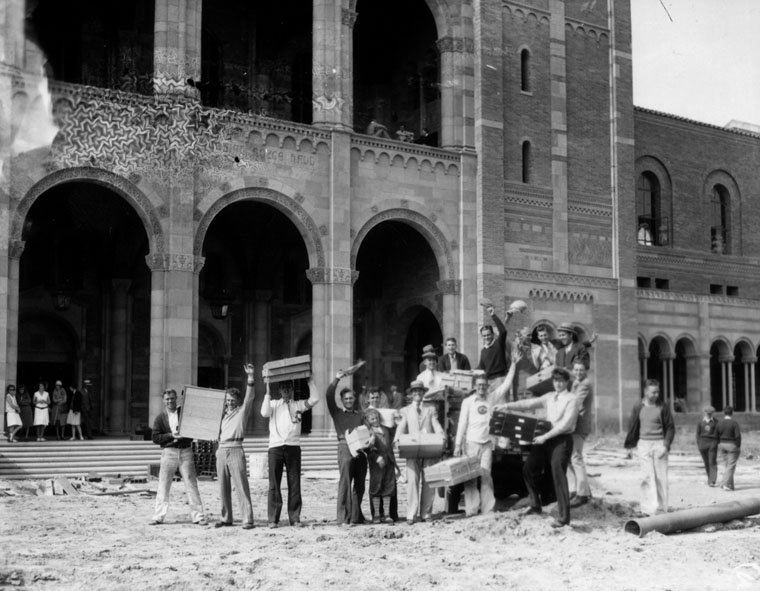 |
|
| (1929)* - Moving Day, from UCLA's Vermont Avenue campus to the new Westwood site, on May 31, 1929. A group of workers and student helpers are shown standing outside of Royce Hall. |
Opening Day
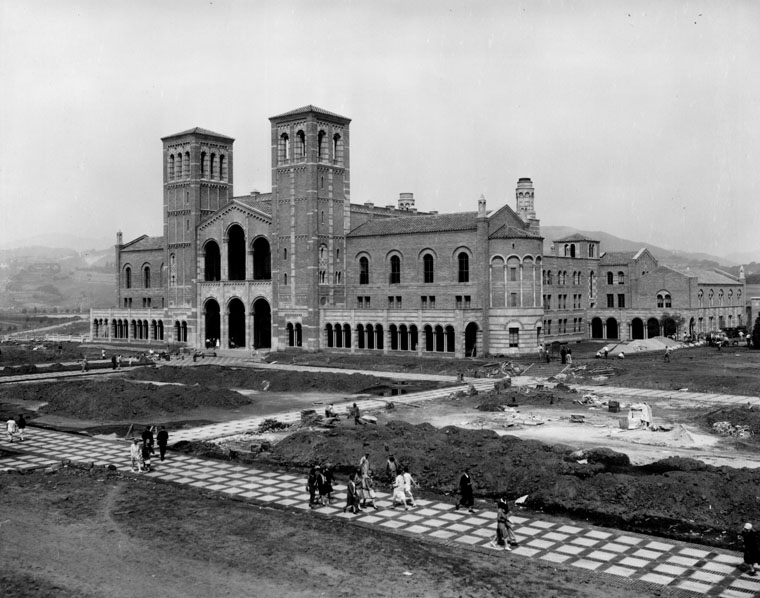 |
|
| (1929)* - Opening Day on the new UCLA Westwood campus, September 20, 1929. Construction activity continued while classes began. The area shown is the original campus quadrangle. View above shows students walking along the pathway. Royce Hall is just barely complete. |
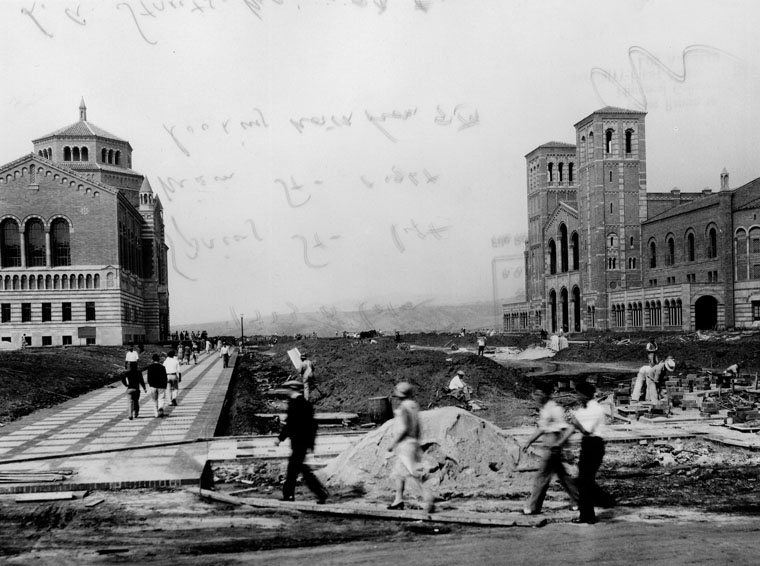 |
|
| (1929)* - Opening Day at the new UCLA Westwood campus, September 20, 1929. Students are registering for classes amid hectic construction activity. The view is looking west across the main campus quadrangle, with Powell Library on the left, and Royce Hall on the right. |
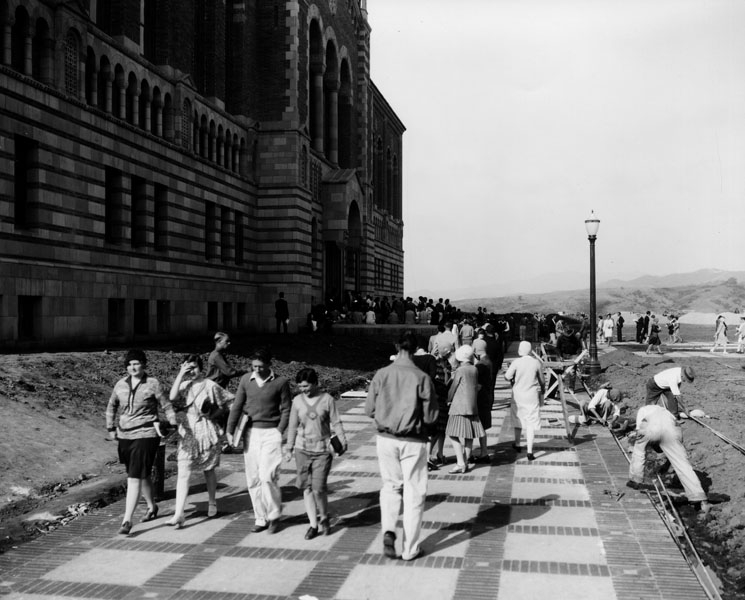 |
|
| (1929)* - View looking west showing both students and construction workers in front of the Powell Library on Opening Day. |
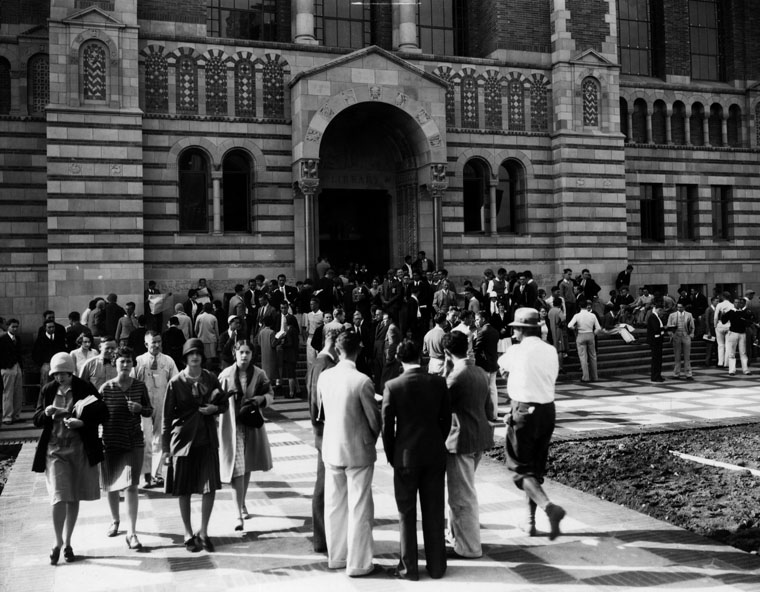 |
|
| (1929)* - Opening Day at the new UCLA campus. Students are dressed in the latest styles. |
Royce Hall
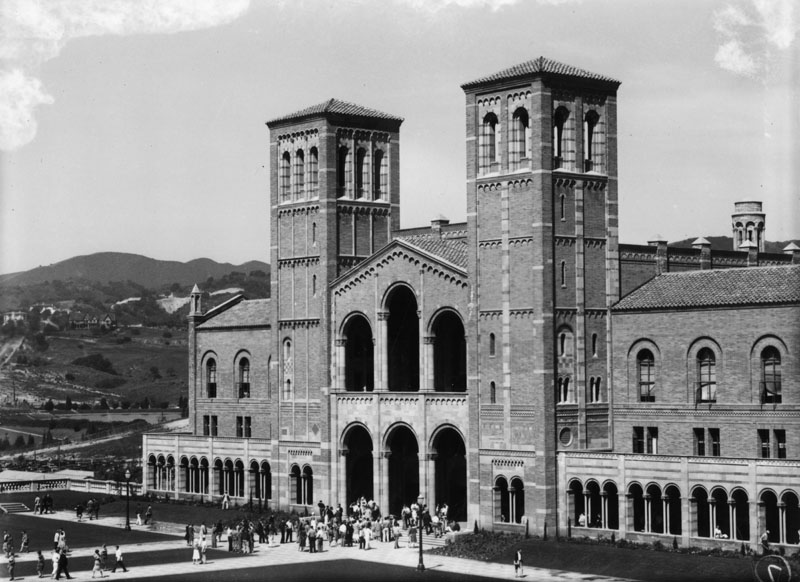 |
|
| (1929)* - Royce Hall, at the time that the UCLA Westwood campus opened in 1929. View shows the twin towers on either side of the entrance to Royce Hall. A group gathers on the steps, outside the building. |
Historical Notes Royce Hall was built in 1928-29 and designed by Allison and Allison, Architects. It was constructed in a northern Italian Romanesque Revival style, inspired by Sant' Ambrogio in Milan (12th century). It is one of the four original buildings on UCLA's Westwood campus and has come to be the defining image of the university. |
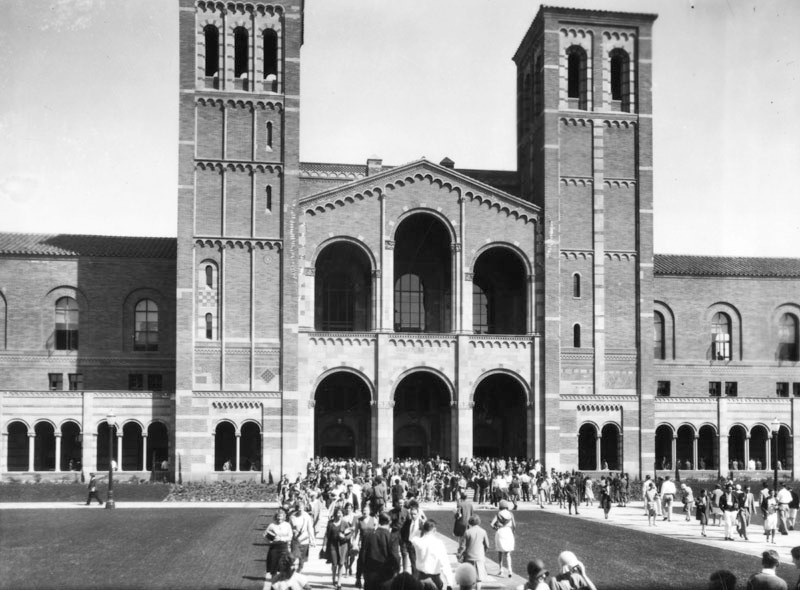 |
|
| (1929)* – Students are seen walking between Royce Hall and the Powell Library |
Historical Notes The brick and tile building is in the Lombard Romanesque style, and once functioned as the main classroom facility of the university. Today, Royce Hall’s twin-towered front remains the best known UCLA landmark. Royce Hall was named after Josiah Royce, a California-born philosopher who received his bachelor's degree from UC Berkeley in 1875.*^ |
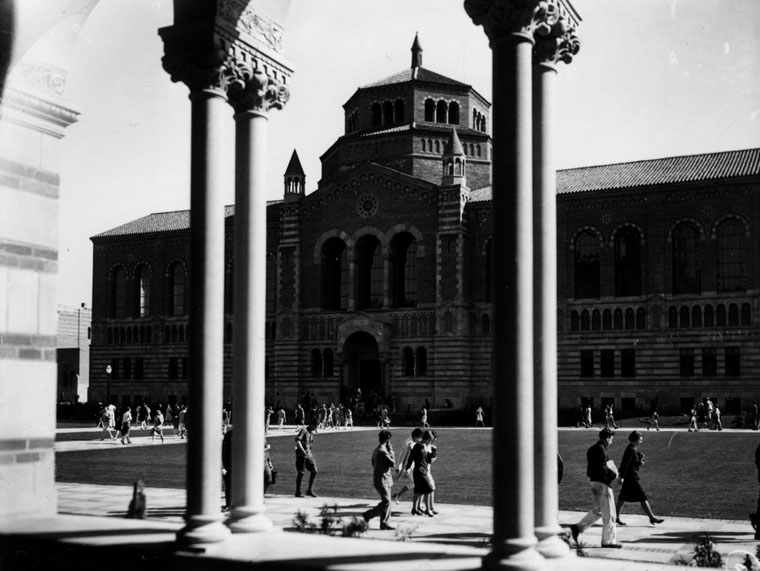 |
|
| (1929)*- Exterior view of Powell Library as seen through the arches of Royce Hall. |
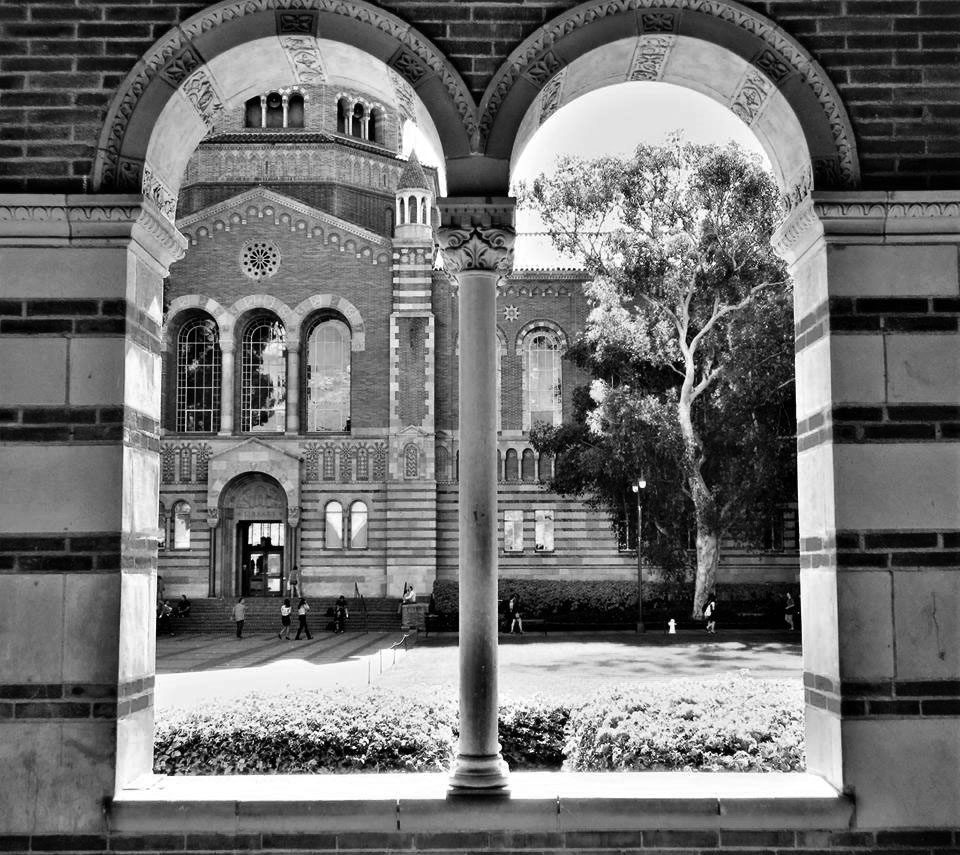 |
|
| (2018)^.^ - Contemporary view showing Powell Library as seen through the Royce Hall arches. Photo by Howard Gray |
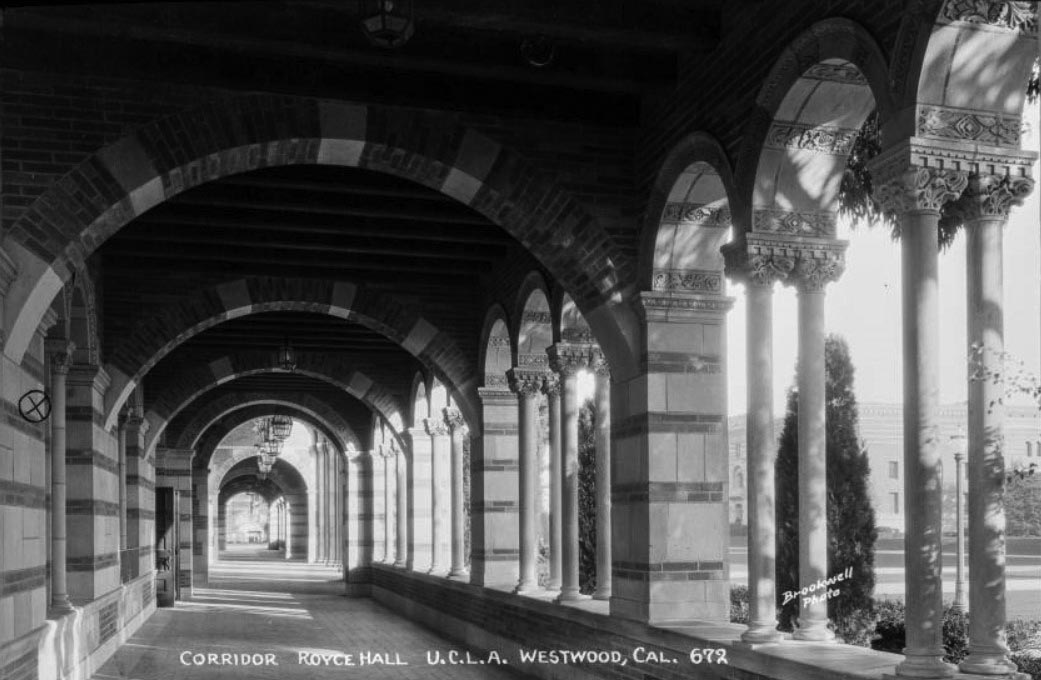 |
|
| (1930s)#* – Postcard view showing the corridor of Royce Hall on the campus of the University of California, Los Angeles (UCLA). |
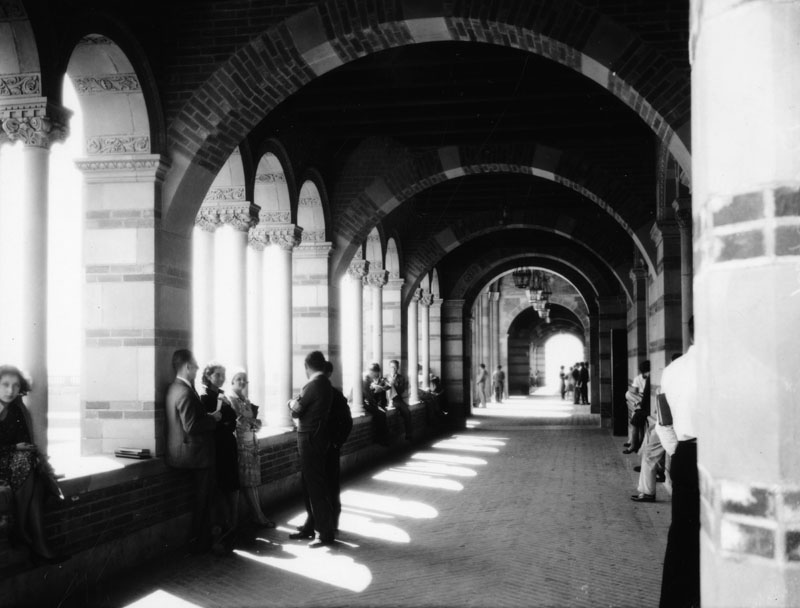 |
|
| (1929)* - Looking down the outside hallway of Royce Hall, small groups of students are seen standing, while others are seated on ledges beneath the arches. |
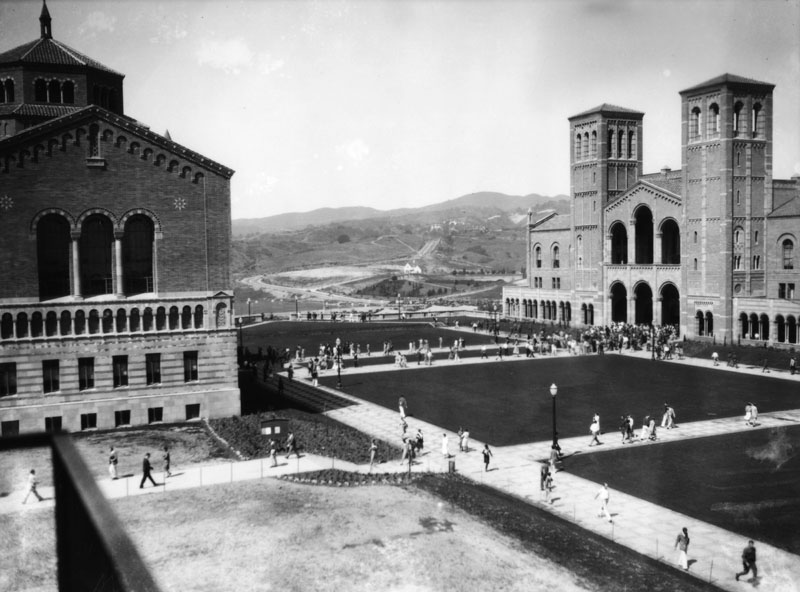 |
|
| (1929)* - Overall view looking across the quadrangle towards the twin towers of Royce Hall with Powell Library to the left. |
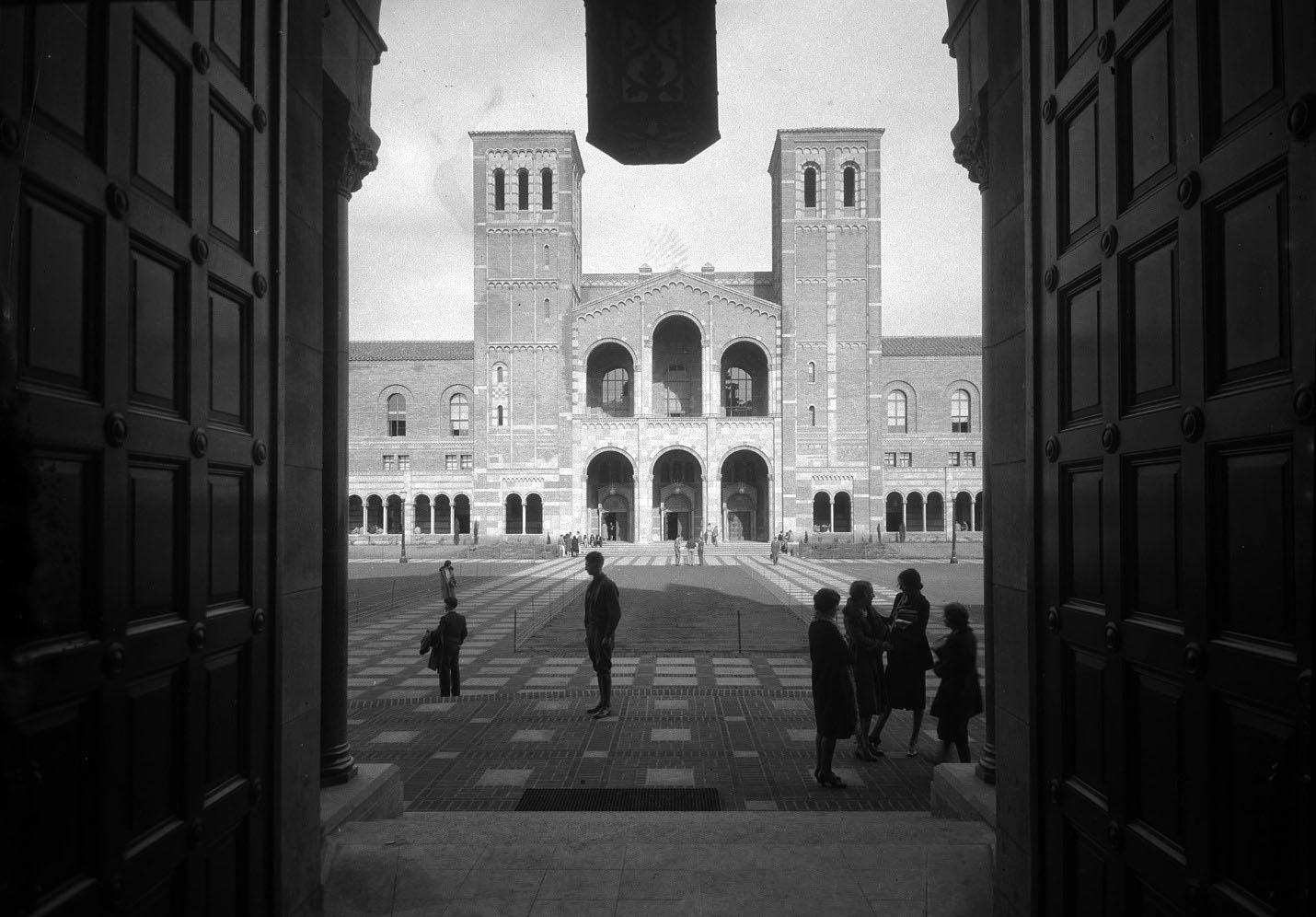 |
|
| (1930)^.^ – View looking out the front doors of Powell Library towards Royce Hall. Photo by Adelbert Bartlett |
Powell Library
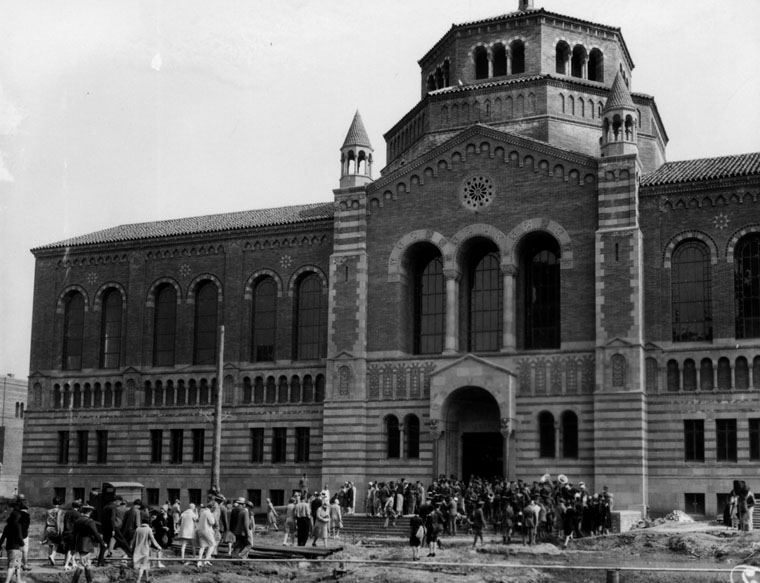 |
|
| (1929)* - Exterior view of Powell Library at the UCLA Westwood campus. Students are seen walking to and from the library, amid the construction activity. |
Historical Notes Powell Library (originally called College Library) is named for Lawrence Clark Powell, the University Librarian at UCLA from 1944 to 1961 and Dean of the Graduate School of Library Service from 1960 to 1966. Like the building facing it across the quad, Royce Hall, the building's exterior is modeled after Milan's Basilica of Sant'Ambrogio.*^ |
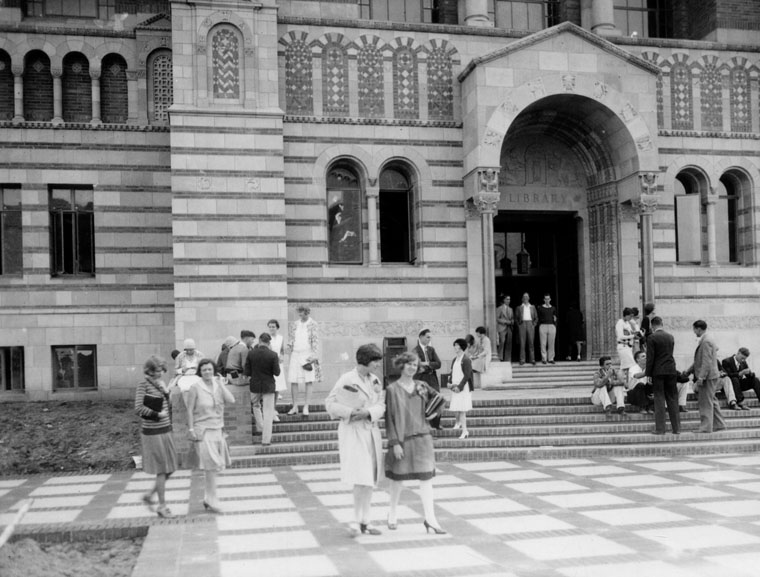 |
|
| (1929)* - Close-up view showing the front of Powell Library. Three young men are seen standing inside the main entrance of the building. Other students are shown on the left side and sitting on the steps in front of the library. |
Historical Notes The entrance of the library is adorned with several mosaics, one of which depicts two men holding a book bearing the phrase, from Cicero's Pro Archia Poeta, "Haec studia adulescentiam alunt, senectutem oblectant". This loosely translates as "Studying in youth sustains delight into old age", an appropriate dictum for the vast collection for undergraduate students.*^ |
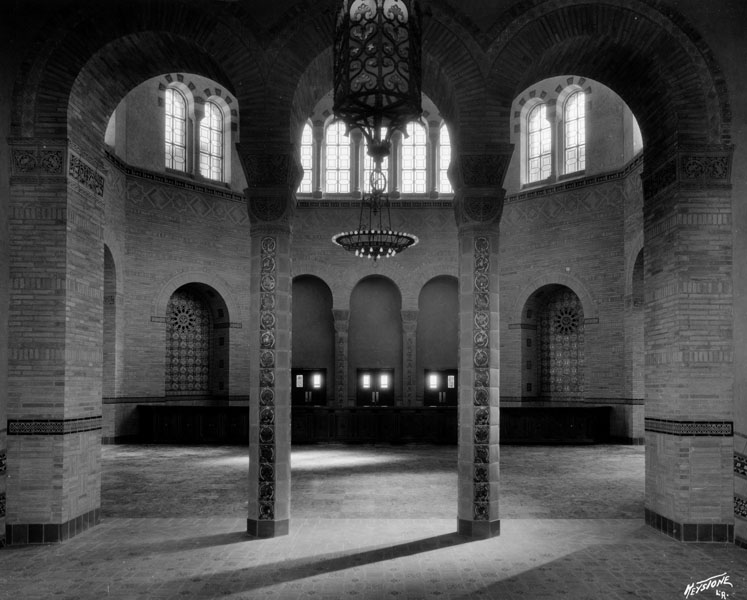 |
|
| (1930)* - Interior view of the rotunda at Powell Library, at UCLA Building was built 1927-29 in a Italian (Lombard) Romanesque Revival style. |
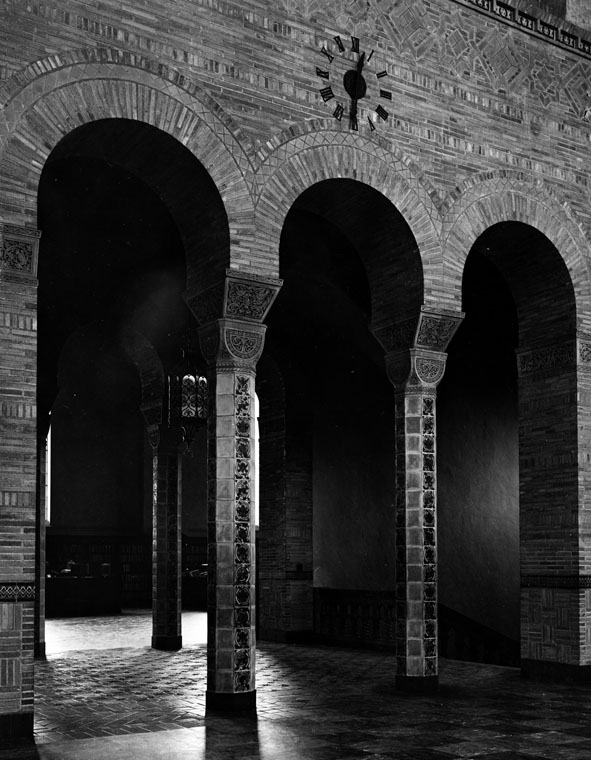 |
|
| (ca. 1930)* - Interior view of Powell Library showing the intricate designs on the pillars and arches of the stair court and rotunda. |
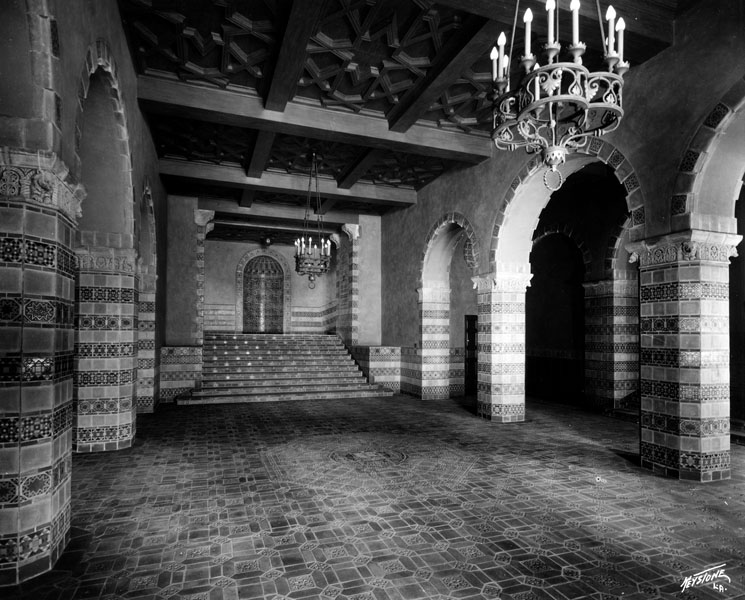 |
|
| (1930)* - Interior view of the Library Building at the new UCLA campus showing detailed tile and brick work. The building was later named the Lawrence Clark Powell Library. |
Historical Notes The great amount of skilled hand work needed for the detailed tile and brick work of the Lombard style of architecture made it impossible to continue in the same architectural tradition when costs rose after World War II. The above view shows the interior of the main lobby and stairs to the reading room at the Powell Library.* |
.jpg) |
|
| (1930)* - Interior view showing the main study hall at the new UCLA library. |
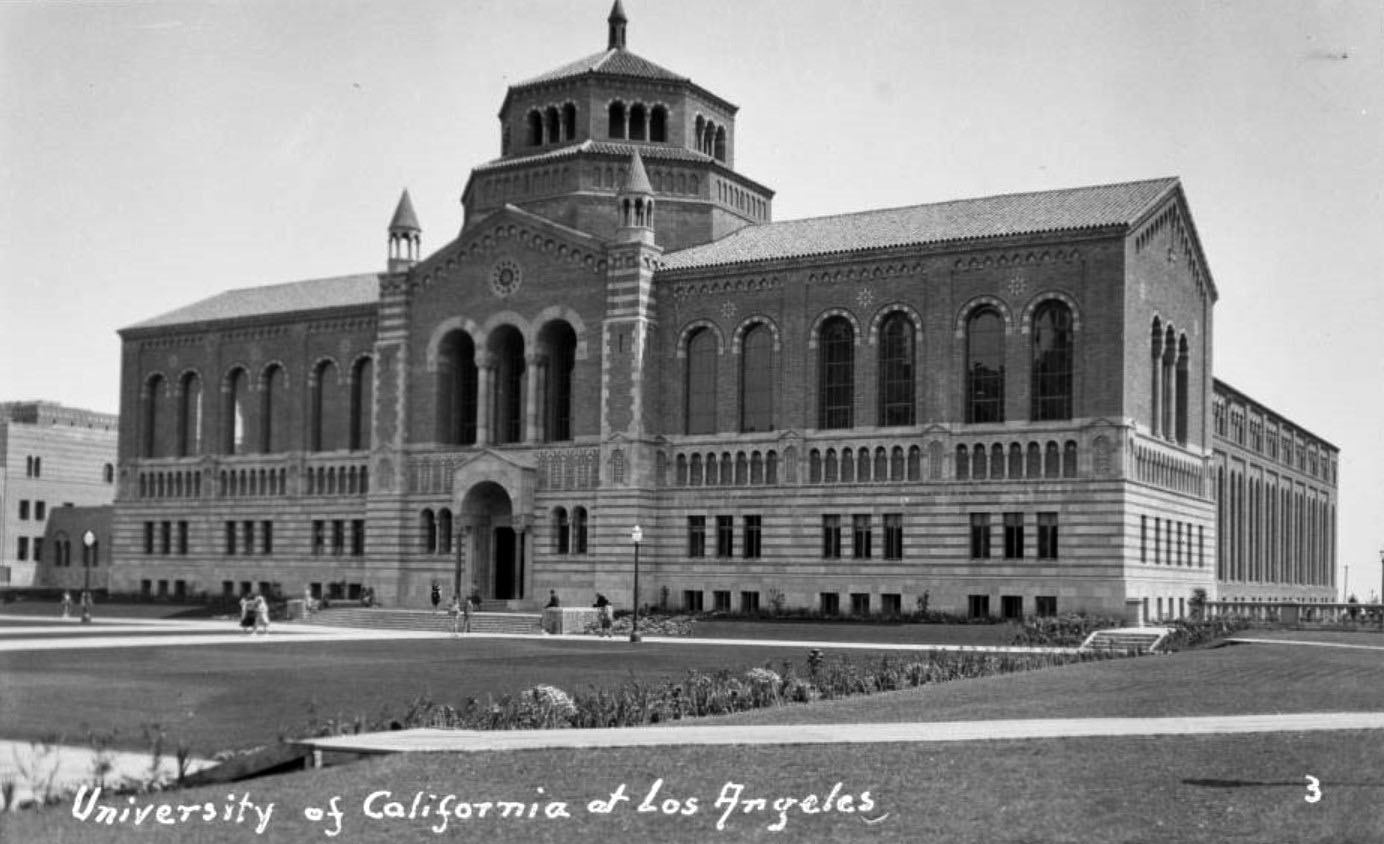 |
|
| (ca. 1930)#* – Postcard view showing people, walkways, and lawn of the quad in front of Powell Library on the campus of the University of California, Los Angeles (UCLA). |
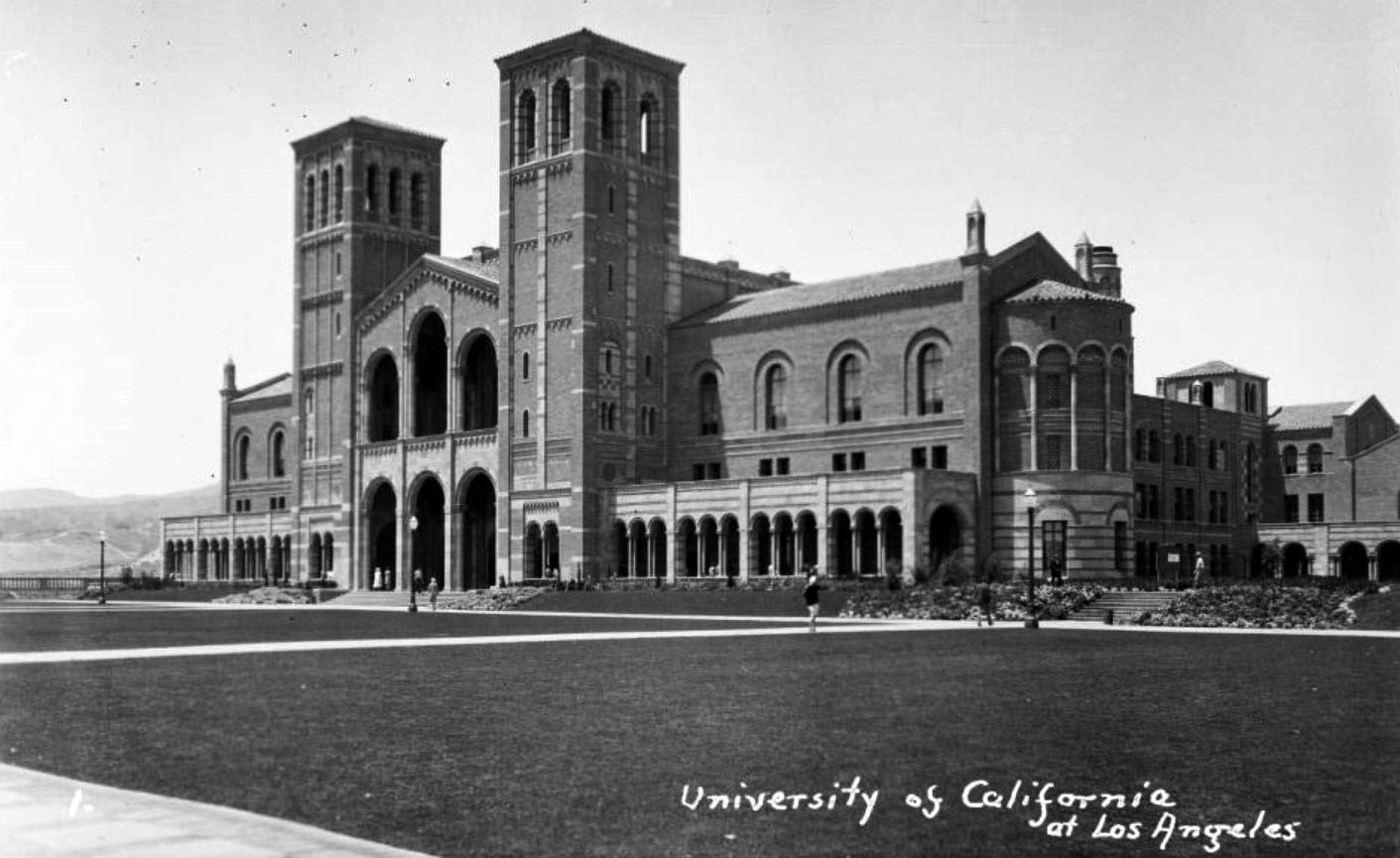 |
|
| (ca. 1930)#* – Postcard view showing the front of Royce Hall and lawn of the quad on the campus of the University of California, Los Angeles (UCLA). |
Historical Notes Royce Hall’s first performing arts season was 1937. The first subscription series included the great contralto Marian Anderson, the Budapest String Quartet and the Los Angeles Philharmonic. Also appearing at Royce Hall that year were Jimmy Dorsey’s Band and the Los Angeles Philharmonic conducted by famed conductor Otto Klemperer. A year later in 1937, Duke Ellington’s Orchestra and avant-garde composer Arnold Schoenberg made appearances. Luminaries who have appeared on its stage include musicians George Gershwin, Leonard Bernstein, and Ella Fitzgerald, and speakers Albert Einstein and John F. Kennedy.*^ |
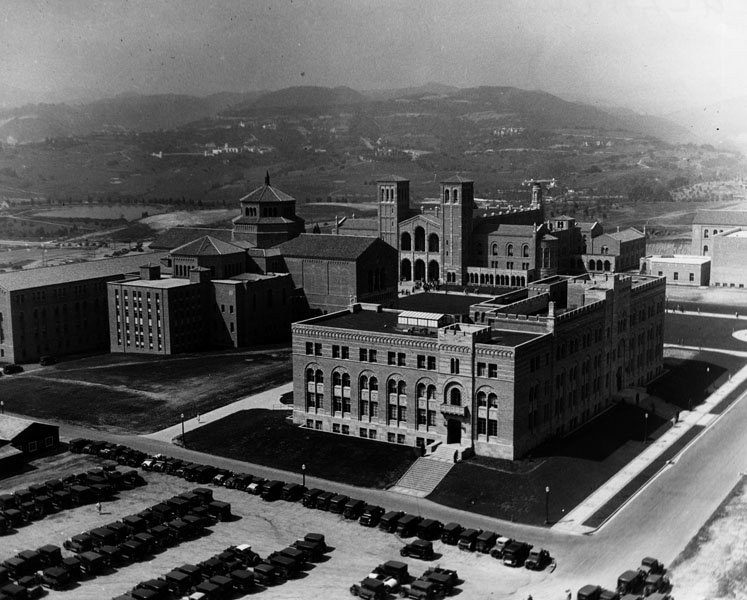 |
|
| (1930)* - Aerial view looking north at the UCLA campus, as seen from the Goodyear Blimp. Buildings from left to right: Powell Library, Royce Hall and the Physics building. |
Historical Notes During the 1930s several other buildings were added to the cluster around the main quadrangle--the Education Building, Kerckhoff Hall, the Men's Gymnasium, the Women's Gymnasium, Mira Hershey Hall, and the Administration Building.** |
 |
|
| (ca. 1930)* - View of several campus buildings at UCLA, as seen from across the ravine (in foreground) now Dickson Court. Buildings from left to right are: Physics Building, Powell Library, and Haines Hall. |
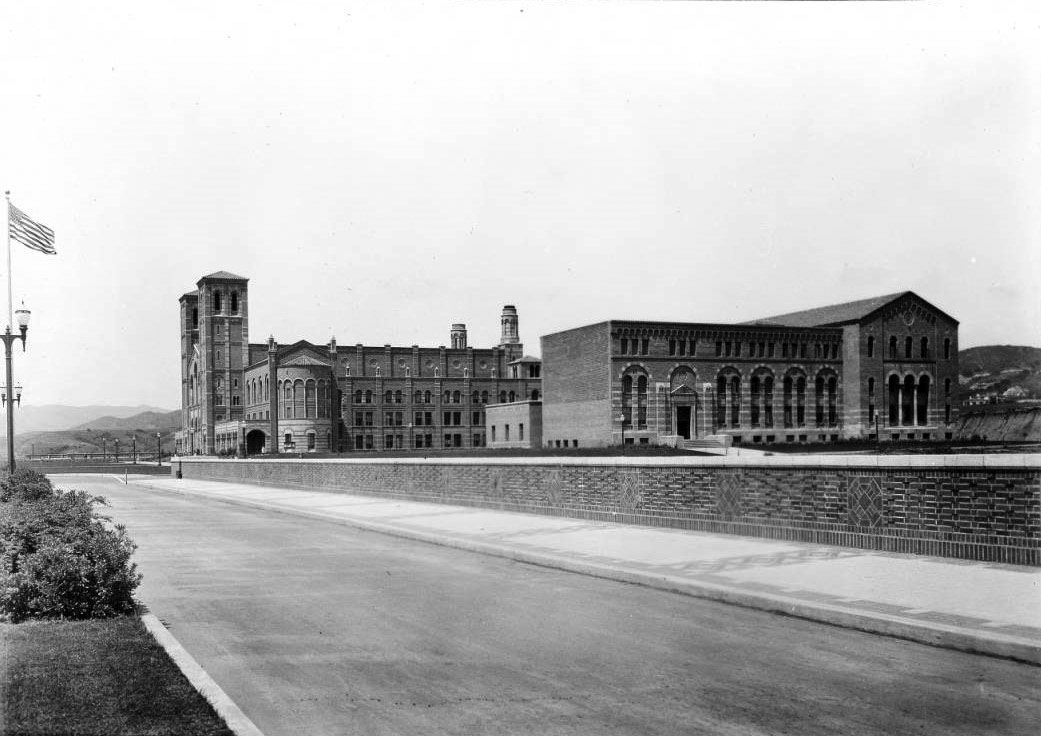 |
|
| (1930)^^ - View of Royce Hall and Haines Hall at the University of California, Los Angeles, April 24, 1930, as seen from the Arroyo Bridge. To the left is the bridge's center median. |
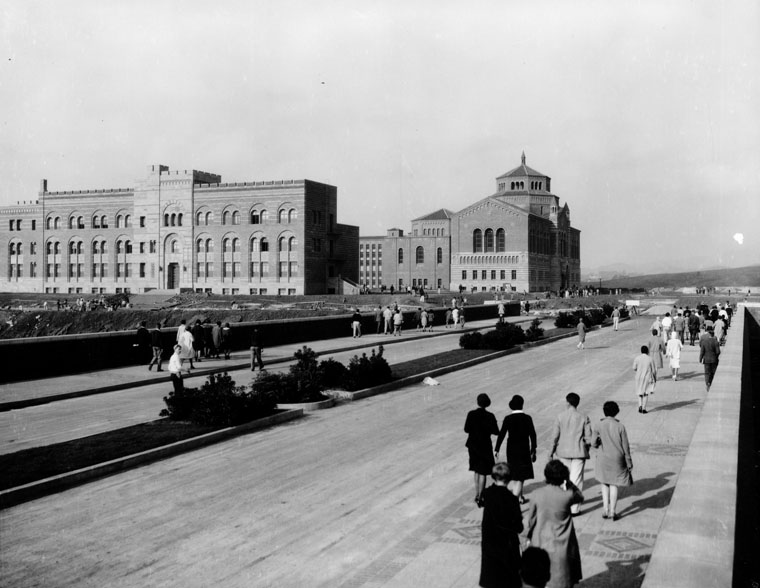 |
|
| (ca. 1930)* - View shows UCLA students crossing the Arroyo Bridge from Hilgard Avenue to the campus. The gully which the bridge crossed, was filled in after World War II. |
UCLA is Formally Dedicated (March 27 and 28, 1930)
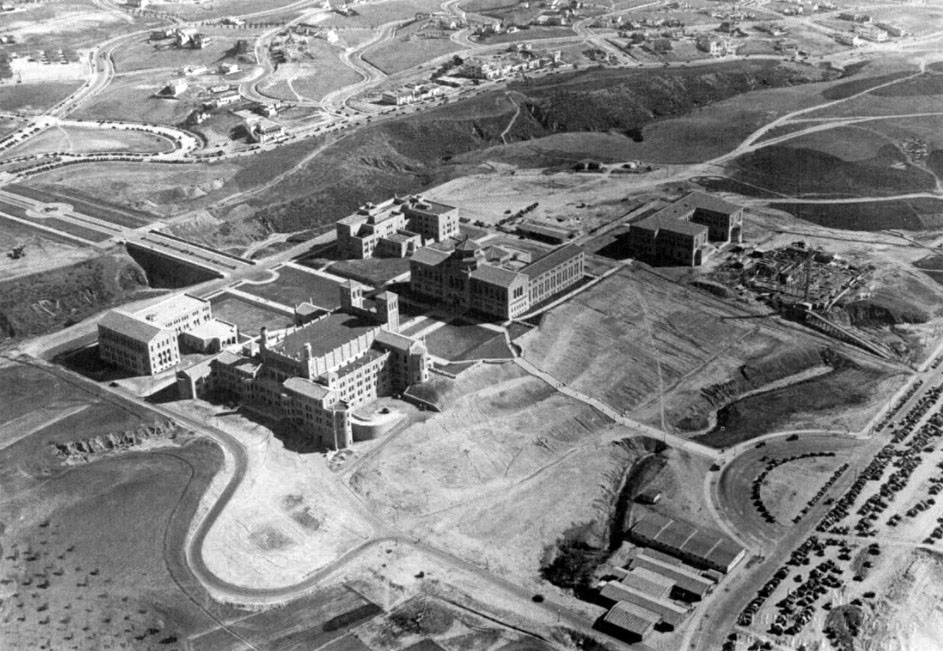 |
|
| (1930)^v^ – Aerial view looking southeast showing the UCLA campus. Visible at far left is the Arroyo Bridge. Kerkhoff Hall is seen under construction at far right next to the education building. |
Historical Notes On March 27 and 28, 1930, the formal dedication of the University of California at Los Angeles took place. Speakers at the ceremonies included Dr. Arthur Thompson of the University of Aberdeen and Dr. Ernest Carroll Moore, director of UCLA. Delegates representing 168 colleges and universities from around the world were present. |
 |
|
| (1930)* - Aerial view of UCLA looking west, as seen from the Goodyear blimp. View was taken after the construction of the original quadrangle was completed on the Westwood campus. The view is from directly over the Arroyo Bridge, over which students passed from Hilgard Avenue to the campus. |
| (1930)*# - Aerial view looking southeast showing the full extent of Janss Steps before the hillside was landscaped. |
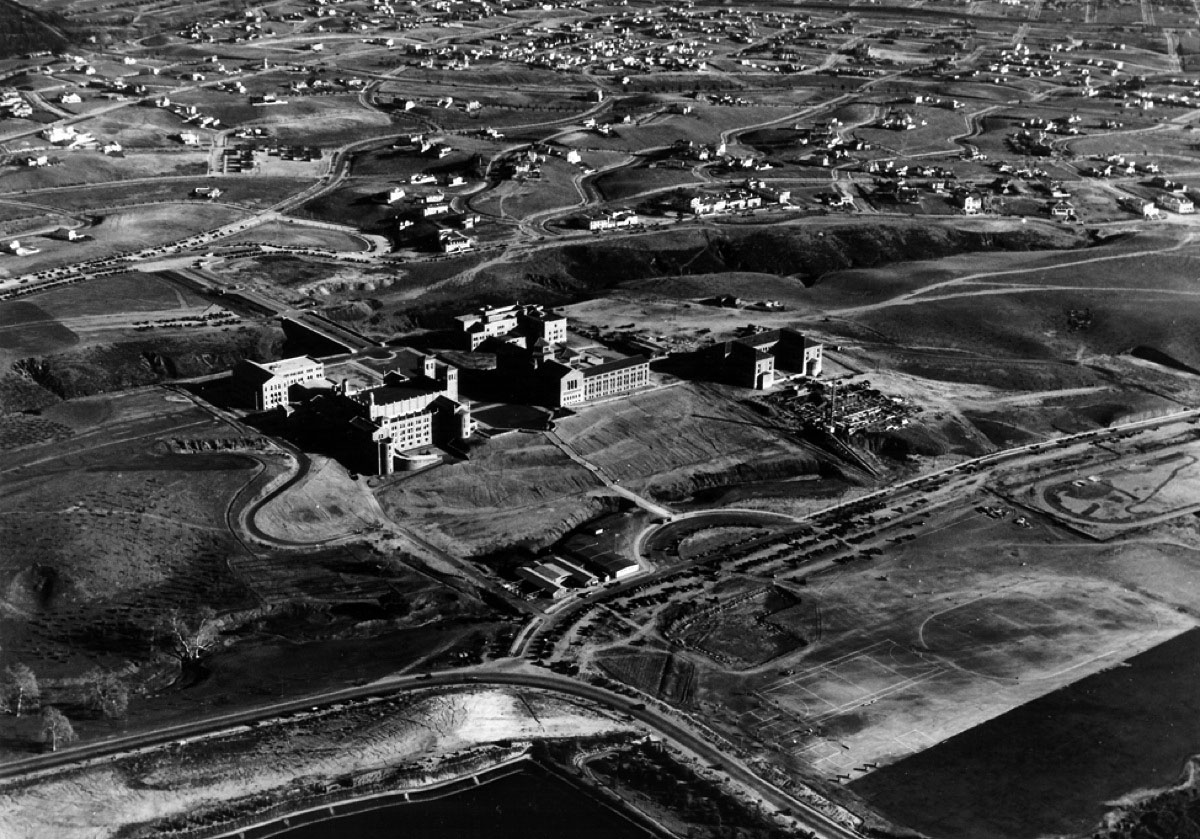 |
|
| (1930)*#- Aerial view of UCLA showing the full range of residential development to the southeast of campus. There is a clear view of the bridge and gully, later filled in, between the campus and the community. |
 |
|
| (1930)* - A panoramic view of the UCLA Westwood campus, shortly after it opened. View is looking from the golf course of the Bel-Air Country Club. The body of water shown is the Sawtelle Pressure Break Resevoir. The twin towers of Royce Hall may be seen in the middle of this photo. Click HERE to see more Early Views of LA Water Reservoirs. |
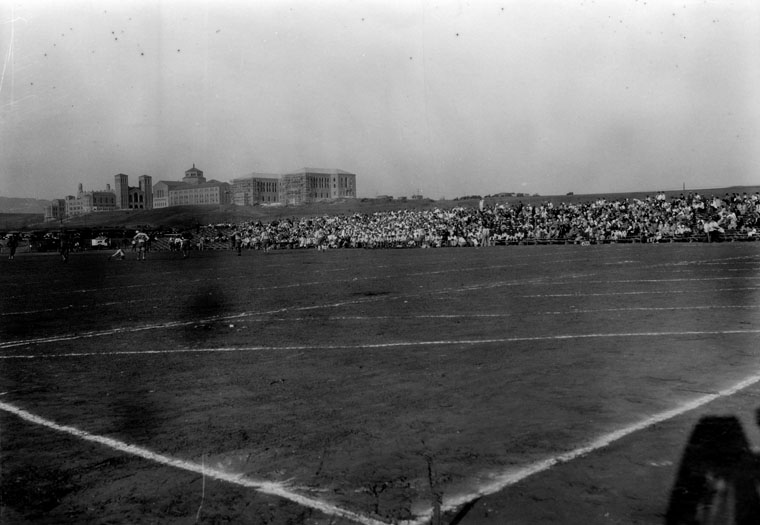 |
|
| (ca. 1930)* - View looking across UCLA's playing field, where a football game is in progress. In the far background is UCLA's Royce Hall, the backs of Powell Library and the Physics building, the earliest campus buildings. |
* * * * * |
Kerckhoff Hall
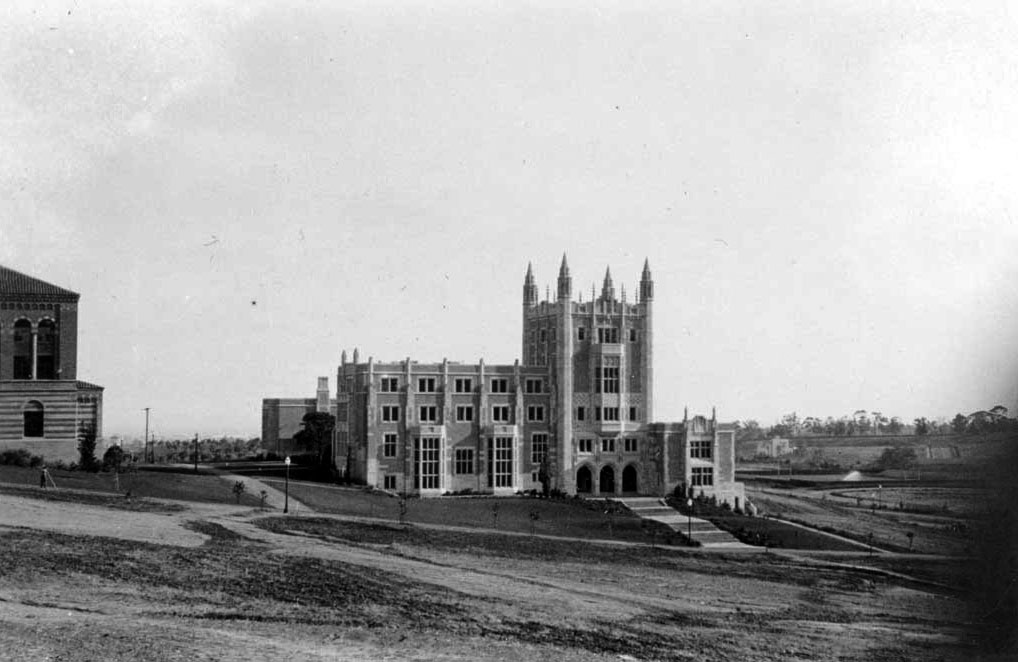 |
|
| (1931)* - View showing the front of the newly constructed Kerckhoff Hall with Moore Hall to the left. |
Historical Notes Designed by architects Allison & Allison, Kerckhoff Hall was completed in 1931. The hall is named for William G. Kerckhoff, a successful lumber and energy magnate, who died prior to the building's completion. Mr Kerckhoff's widow spent $815,000 to build and completely furnish Kerckhoff Hall. |
 |
|
| (ca. 1931)^^ - View of Kerckhoff Hall (Student Union Building) on the southeast side of the University of California Los Angeles campus, The multi-faceted brick building is three stories tall at its zenith. Towards the back of the building, a small tower is visible, while the lower levels of the building are adorned with tall, bay windows. |
Historical Notes The Kerckhoffs visited the Westwood campus under construction in early 1929 and were told by the provost of the need for a student union. On his deathbed a month later, Kerckhoff told his wife that he wanted to build such a building.* |
 |
|
| (1931)** - View showing the dedication ceremony of the new Kerchoff Hall Building as seen from a vantage point in the Education Building (Moore Hall). |
Historical Notes William Kerckhoff moved to Los Angeles from Indiana in 1878-1879 and worked for the Jackson Lumber Company. In 1887, he built the first ocean-going vessel to use oil for fuel. In the 1890s, he founded the San Gabriel Power Company, a hydroelectric power company. By the turn of the century, together with A.C. Balch, he owned half the stock of Henry E. Huntington Pacific Light & Power Company used to provide electricity to Pacific Electric, and he served as its President. In 1902, they purchased the San Joaquin Electric Company. They also founded Southern California Gas Corporation in 1910, and built a 120-mile pipeline from the San Joaquin Valley to Los Angeles. In 1900, Kerckhoff together with Burton E. Green, Charles A. Canfield, Max Whittier, Frank H. Buck, Henry E. Huntington, William F. Herrin, W.S. Porter and Frank H. Balch, known as the Amalgated Oil Company, purchased Rancho Rodeo de las Aguas from Henry Hammel and Andrew H. Denker and renamed it Morocco Junction. After drilling for oil and only finding water, they reorganized their business into the Rodeo Land and Water Company to develop a new residential town later known as Beverly Hills, California. As President of the South Coast Land Company, kerckhoff also helped found the city of Del Mar, California.*^ |
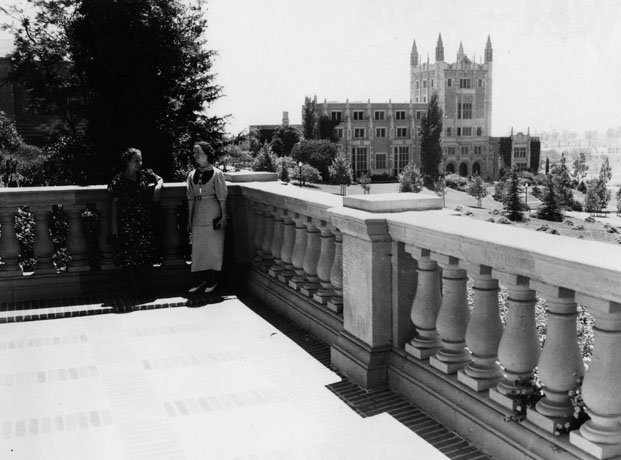 |
|
| (1937)* - View of Kerckhoff Hall (formerly Commissary Hall), as seen from the rotunda at the west end of the quadrangle, where two women are seen talking. |
Historical Notes Today, Kerckhoff Hall is one of the main student union buildings of UCLA. Among its offerings are: study lounges, an art gallery, a coffeehouse, meeting rooms, a salon and the student government offices.* |
 |
|
| (2020)^.^ - Kerckhoff Hall as it appears today. Photo by Howard Gray |
Historical Notes For many Bruins, the iconic Gothic spires of Kerckhoff Hall, rising majestically high above campus, are second only to Royce Hall as a symbol of UCLA. |
* * * * * |
 |
|
| (1931)*# - Photographed from the Physics-Biology Building (Kinsey Hall, subsequently the Humanities Building), the Goodyear Blimp flies over Royce Hall. The airship--named the "Volunteer"--was used by Thelner Hoover for aerial photography of campus. Here the airship joins the festivities of the annual freshman "Green Day" in the Spring of 1931. The Library (Powell Library) is in the foreground and the Provost's Residence (University Residence) is in the distant background. Click HERE to see more in Aviation in Early Los Angeles. |
 |
|
| (1932)^^* - Snow on the grounds of UCLA's Royce Hall on January 15, 1932. |
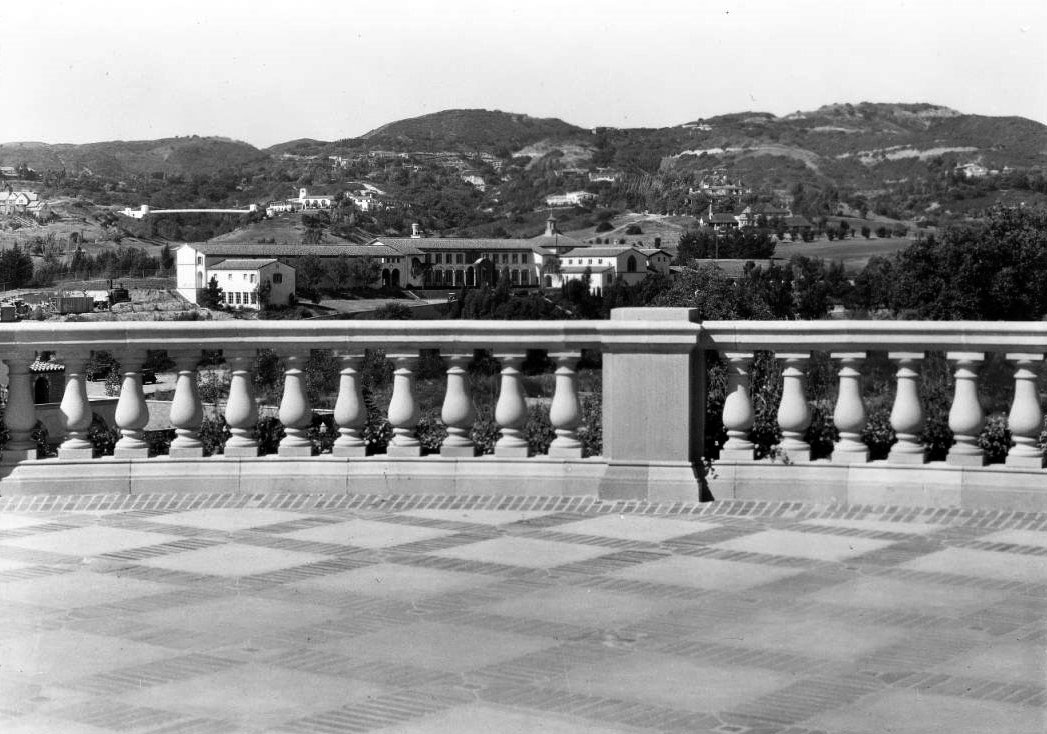 |
|
| (ca. 1935)^^ - View of Marymount High School, seen across Sunset Boulevard from a balcony on UCLA's Royce Hall. A tiled balcony lines the foreground, and over it, one can see a stretch of buildings across an arboreal area. Several smaller house-like structures dot the hill-lined distance. |
Historical Notes Marymount was established in 1923 by the Religious of the Sacred Heart of Mary. Mother Joseph Butler of the Religious of the Sacred Heart of Mary founded the school in 1923. Marymount students and teams are known as the "Sailors." *^ |
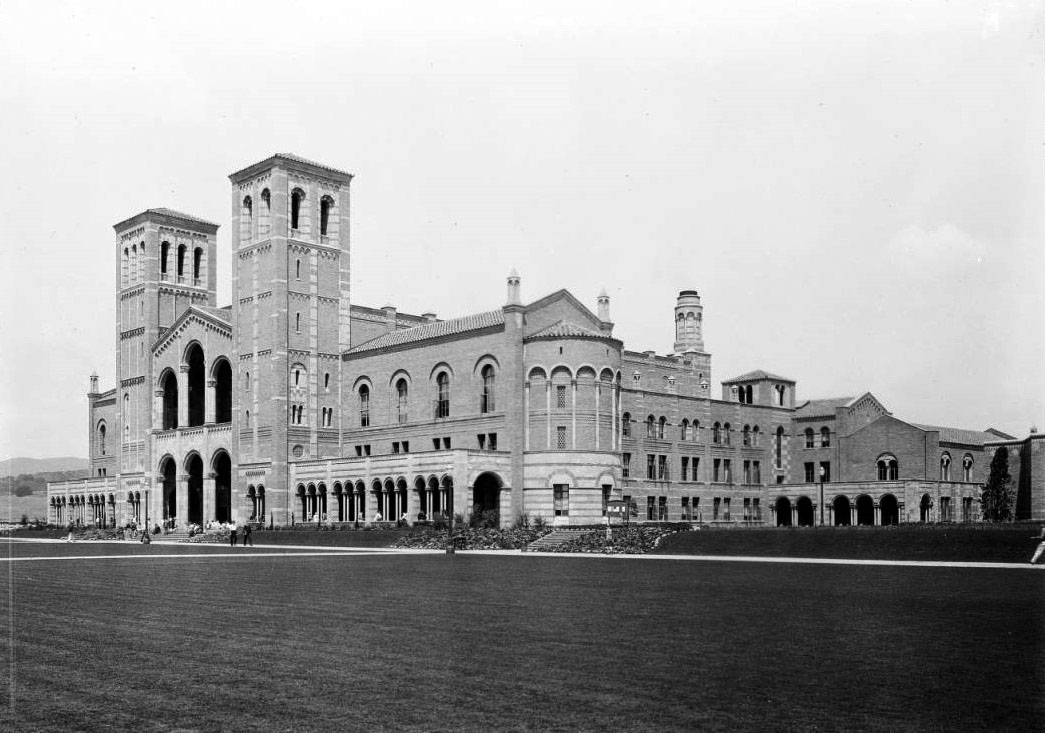 |
|
| (1938)^^ - Profile view showing the full extent of Royce Hall. The photo allows one to view the entire side of the building, and a rounded columned structure emerges at center, while rows of both squared and arched windows line a three-story structure that works its way into more structures in the back. Several rounded turrets stand atop roofs in this area. A large manicured lawn stretches in front of the building, and a sky with a sprinkling of clouds hangs overhead. |
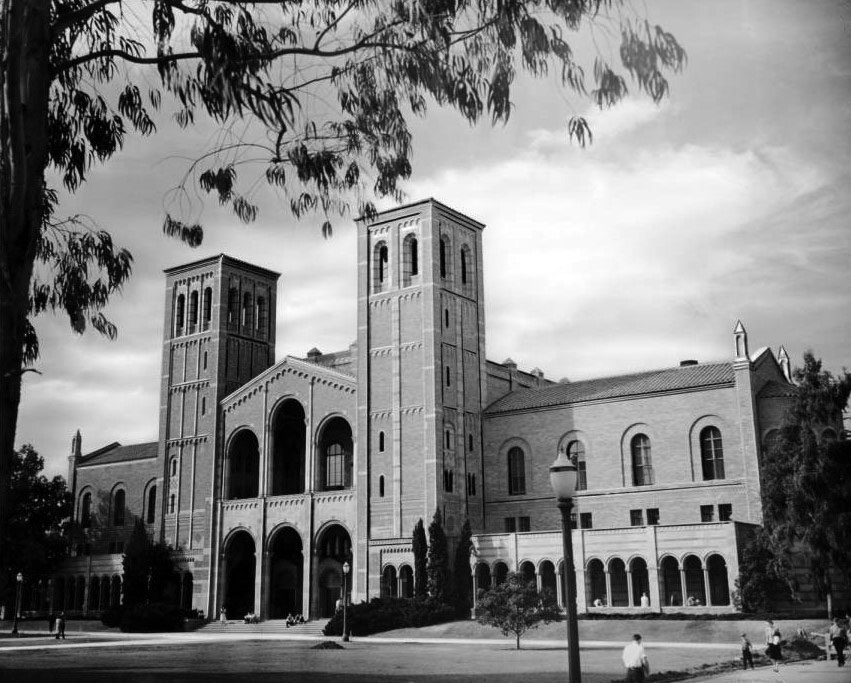 |
|
| (ca. 1950)^^ - View of the beautiful Royce Hall at UCLA. The large brick building is pictured with bell tower to either side of the its large arched entranceway. Several students can be seen sitting on the front steps, while at right more can be seen walking down a path. |
UCLA Parking
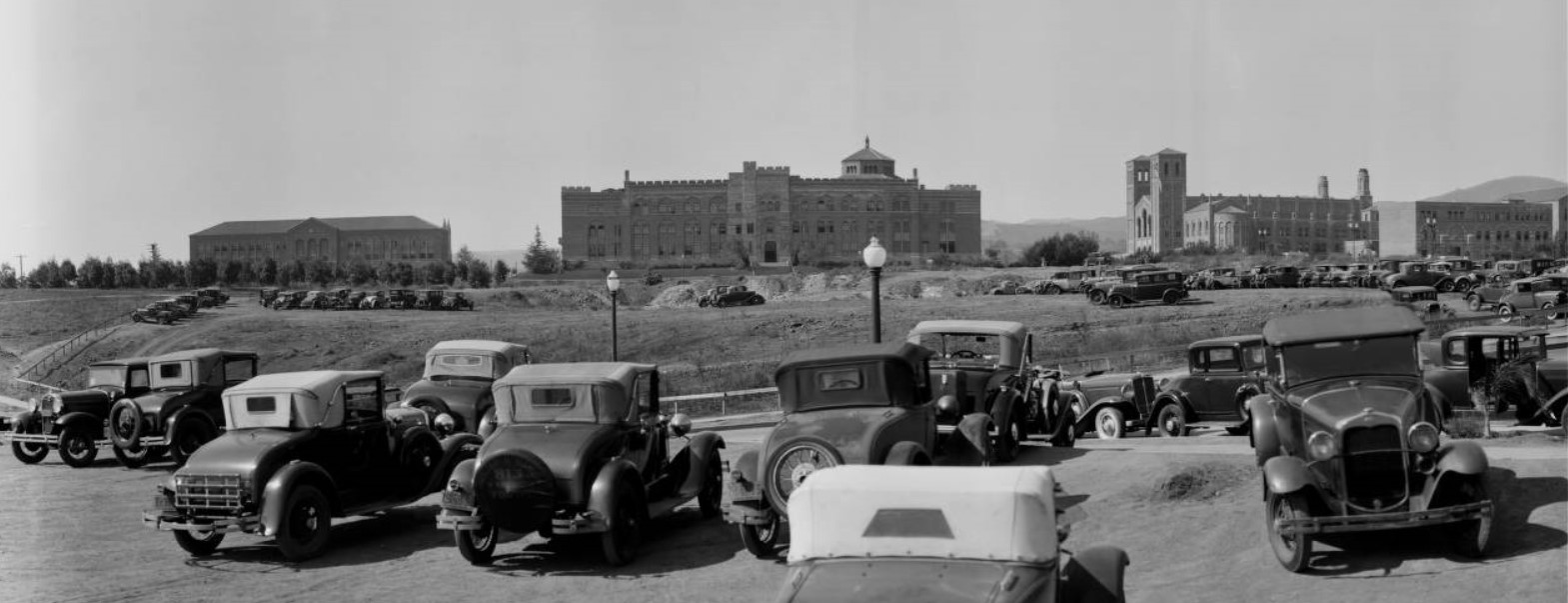 |
|
| (1932)* - A panoramic view of the campus of UCLA facing west. College Library (now Powell Library) is in the center, with the Education Building (now Moore Hall) on its left and Royce Hall on its right. The photograph was taken from a parking lot. There are other lots filled with parked automobiles between the camera and the campus buildings. Source: Huntington Library |
Historical Notes In the early years, parking on the UCLA campus was not a significant concern. After World War II, UCLA experienced significant growth, and this growth led to increased demand for parking facilities. This expansion coincided with the post-war boom in car ownership in the United States. To address the growing parking demand, UCLA constructed its first parking structures in the 1950s and 1960s. These multi-level parking garages helped alleviate some of the parking congestion on campus. |
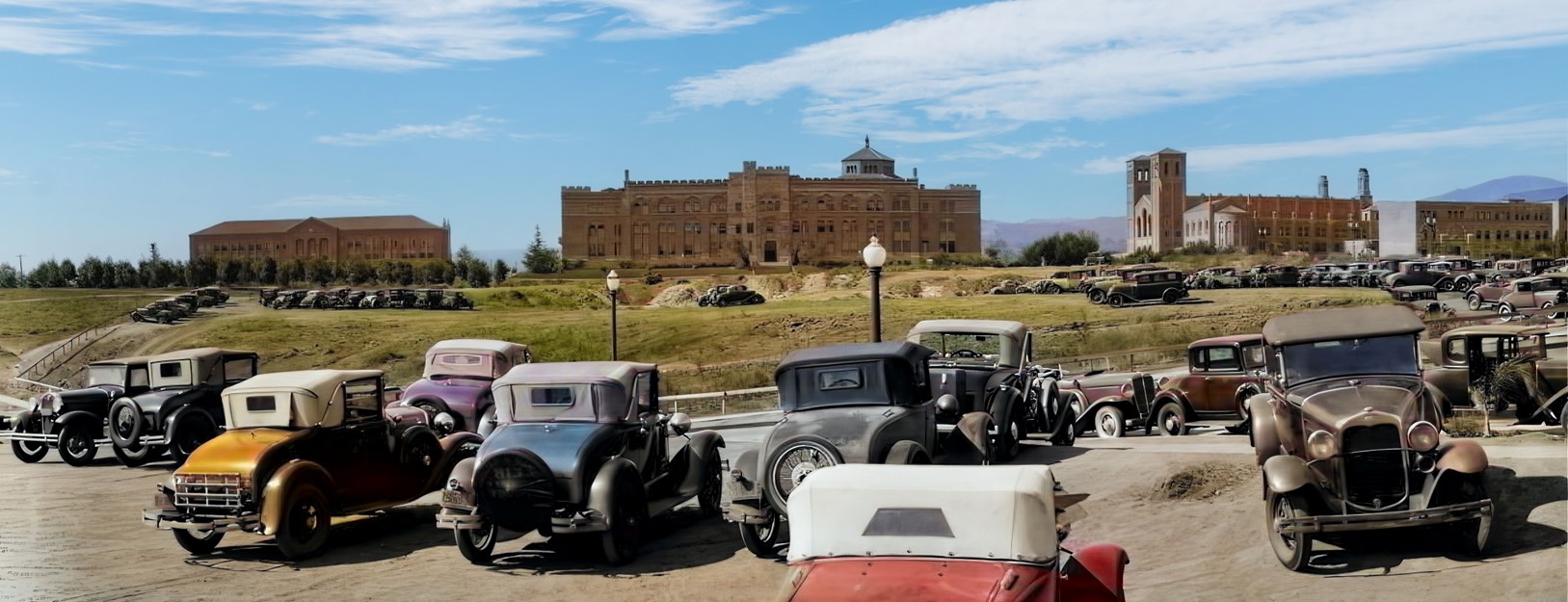 |
|
| (1932) - Panoramic view of the UCLA campus facing west showing parking lots in the foreground. AI image enhancement and colorization by Richard Holoff |
* * * * * |
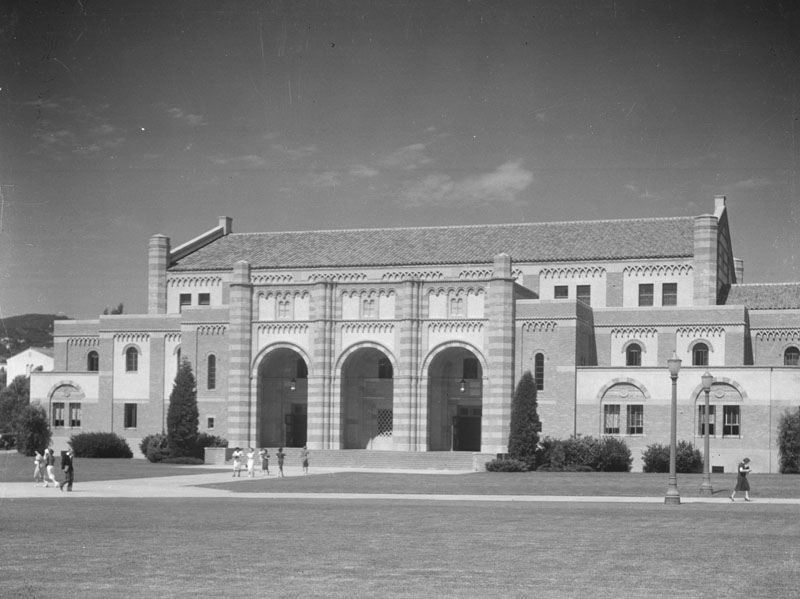 |
|
| (1932)* - Exterior view of the Women's Gym on the UCLA Westwood campus (currently Kaufman Hall). Built in 1932. |
Historical Notes Named for philanthropist Glorya Kaufman, Kaufman Hall was originally UCLA's women's gym. She is the widow of Donald Bruce Kaufman, who co-founded KB Home with Eli Broad in 1957. The building was eventually remodeled and renovated in 2005 to become the house of UCLA Department of World Arts and Cultures as well as dance. Aside from the WAC department, Kaufman Hall also is host to the Kaufman Garden Courtyard, the Kaufman Garden Theater, the Kaufman Hall Dance Theater, and the North pool. Glorya (Pinkis) Kaufman was born in Detroit, Michigan during the Great Depression. Her father worked as a production manager for Automotive News and her mother volunteered for Jewish charities. Her parents could not afford dancing lessons for her. In 2009, she donated $20 million to the Los Angeles Music Center to establish the Glorya Kaufman Presents Dance series. She has also donated millions to the Alvin Ailey American Dance Theater and the Juilliard School in New York City. In 2011, she donated several millions to the University of Southern California for the establishment of the Glorya Kaufman School of Dance and the construction of the Glorya Kaufman International Dance Center.*^ |
 |
|
| (CA. 1935)* - Exterior view of the Physics-Biology building on the UCLA Westwood campus. |
Historical Notes On August 8, 1933, just 14 years after the Los Angeles campus became a part of the University; the Regents authorized graduate training for the M.A. degree and specified a graduate enrollment of 125 students. In the first year, 170 qualified students applied and were enrolled. Graduate enrollment has been climbing ever since. On May 22, 1936, the Regents extended their authorization to include the Ph.D. degree. At June Commencement two years later, the first Ph.D. degree was awarded to Kenneth P. Bailey, a student in the Department of History. One year earlier, a Ph.D. degree had been conferred at Berkeley on Norman Watson, a student in the Department of Physics who had done much of his graduate research at Los Angeles.** |
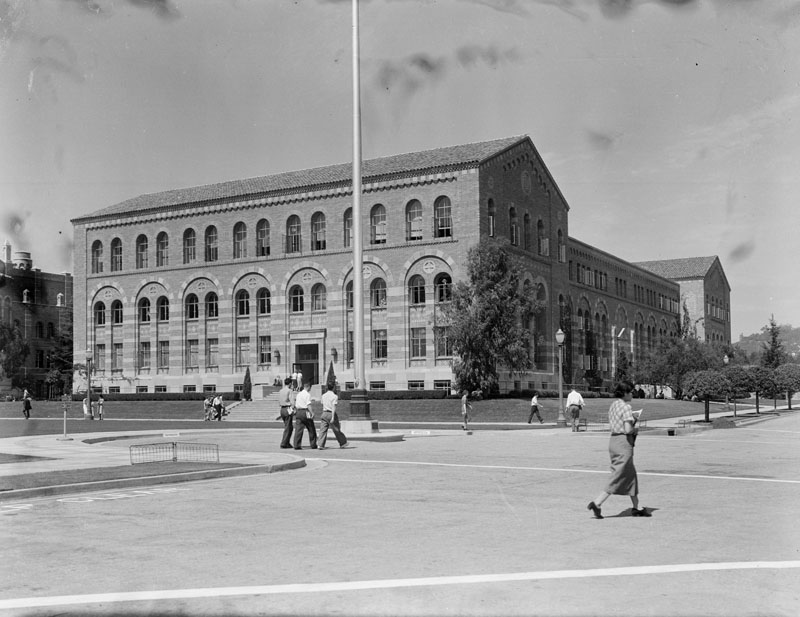 |
|
| (ca. 1935)* - Exterior view of the Chemistry building on the UCLA Westwood campus. |
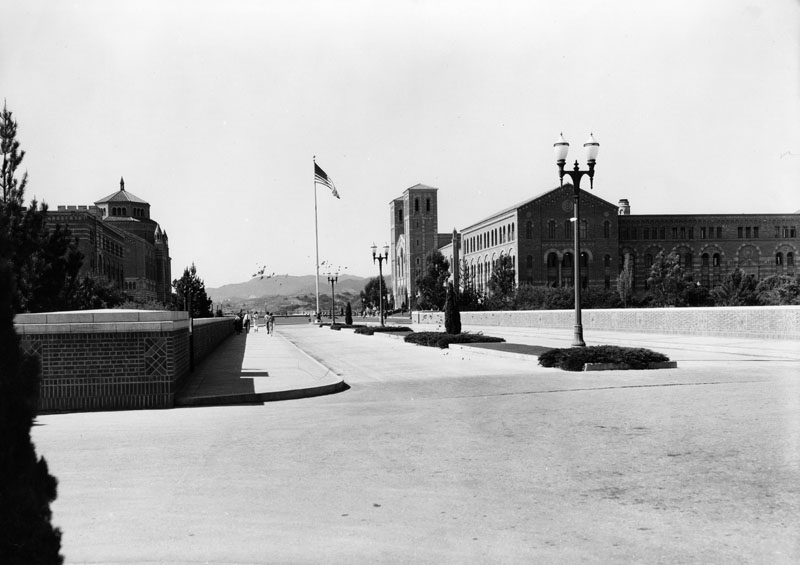 |
|
| (ca. 1935)* - View of two of UCLA's buildings as seen from the bridge. First building in the foreground is Haines Hall. It was built in 1928 and designed by George W. Kelham. The twin towers of Royce Hall are also seen in the background. |
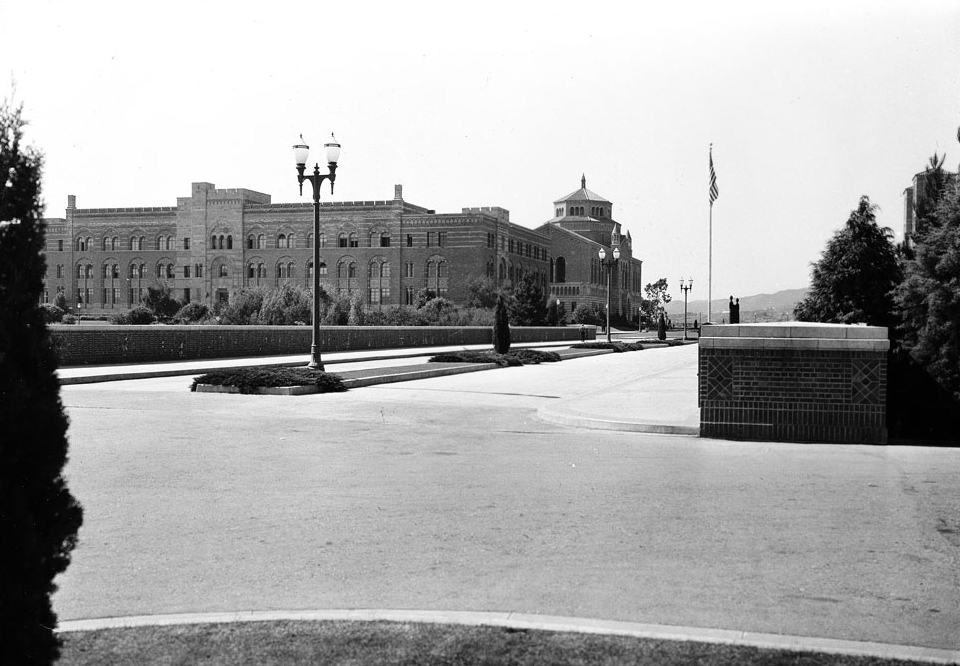 |
|
| (ca. 1935)^^ - Another view of Powell Library from the Arroyo Bridge. |
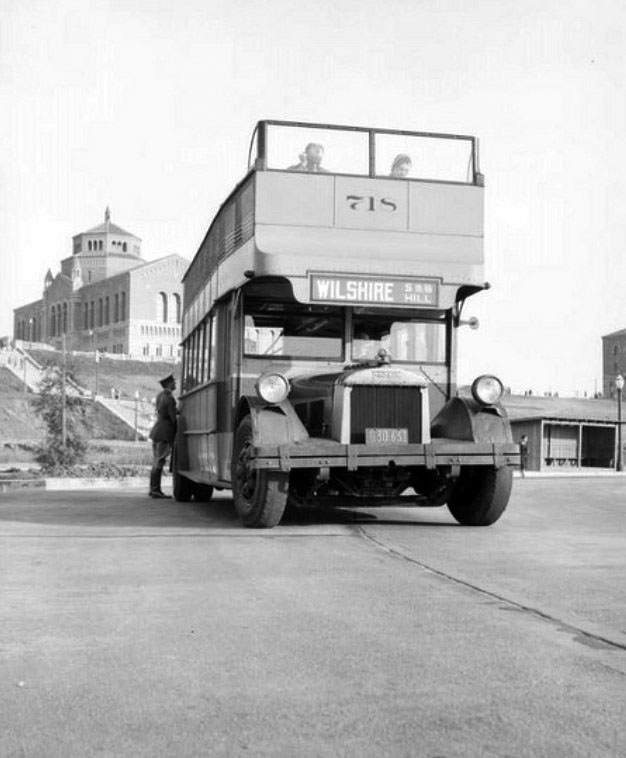 |
|
| (1931)^ – View showing the UCLA stop on the Wilshire bus route, essentially at the foot of Janss Steps with Powell Library in the background. The bus is parked on what would soon become a vast athletic field which would, in turn, give itself over to Pauley Pavilion (out-of-frame to the right). |
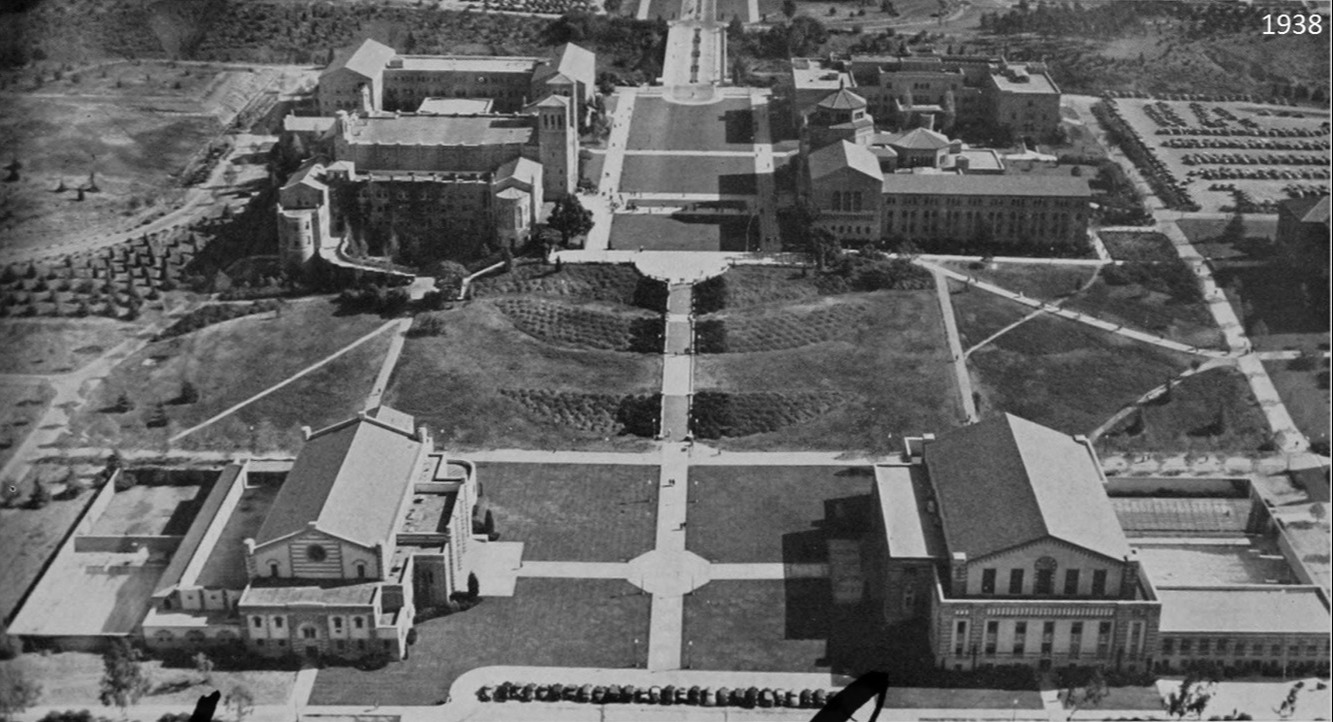 |
|
| (1938)* –Aerial view showing most of the UCLA campus. |
 |
|
| (1930s)^^ - Photograph of a wide view of the University of California at Los Angeles. The buildings of the campus lie beyond two vast fields. The field in the foreground is rocky and overgrown, while the field nearest the buildings is manicured and used for sports. Sunset Boulevard is seen on the left. |
 |
|
| (ca. 1938)^^ - View of the University of California Los Angeles campus from the baseball field, ca.1938. A baseball diamond is visible in the foreground at center, and bleachers can be seen on both the first and third base lines. In the background are several large brick buildings. These include, from left to right: Women's Gym, Royce Hall, Men's Gym, Powell Library, Kerckhoff Hall, and Moore Hall behind. A parking lot can be seen between the diamond and the buildings and is full of cars, indicating that UCLA was a commuter campus from early in its history. |
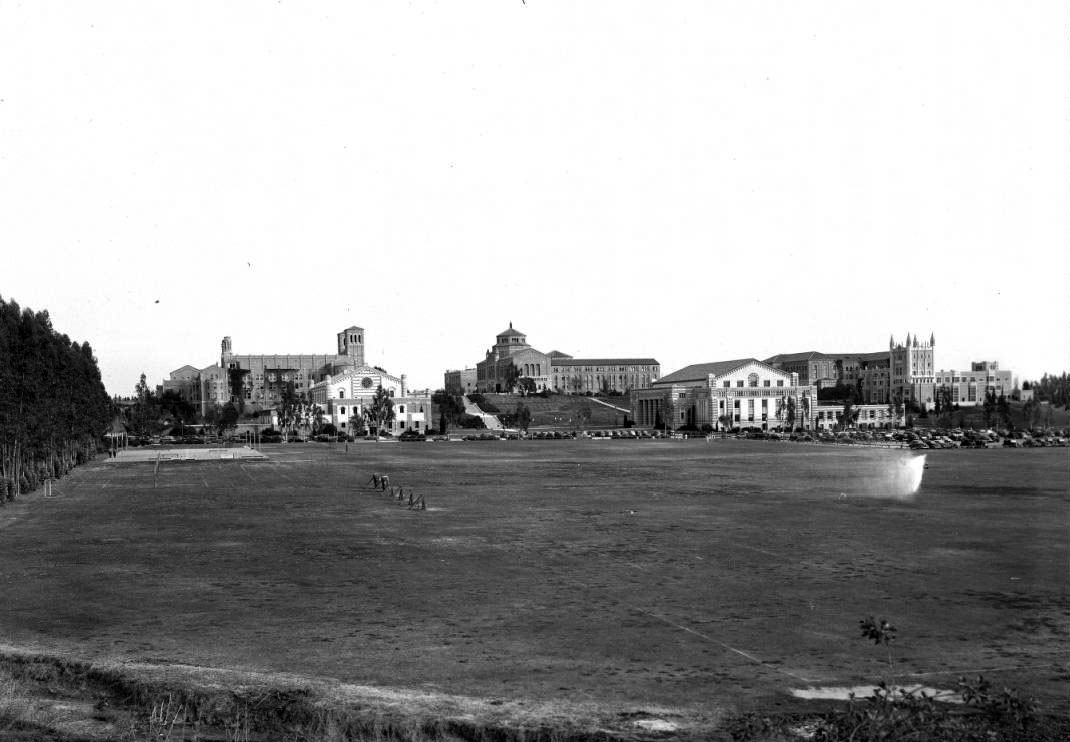 |
|
| (ca. 1930s)^^ - View of the buildings on the UCLA from across an open field. In the foreground, a wide field is pictured with football blocking equipment at left and what appears to be a sprinkler at right. Behind this, a cluster of Roman Revival-style and gothic buildings comprises the University of California, Los Angeles campus. At left, a stand of trees makes a border to the field. |
 |
|
| (1937)* - View of UCLA's campus buildings from left to right: Men's gymnasium, Royce Hall, Janss Steps; and Powell Library. |
 |
|
| (1939)* - Exterior view of the Men's Gym on the UCLA Westwood campus on May 3, 1939. |
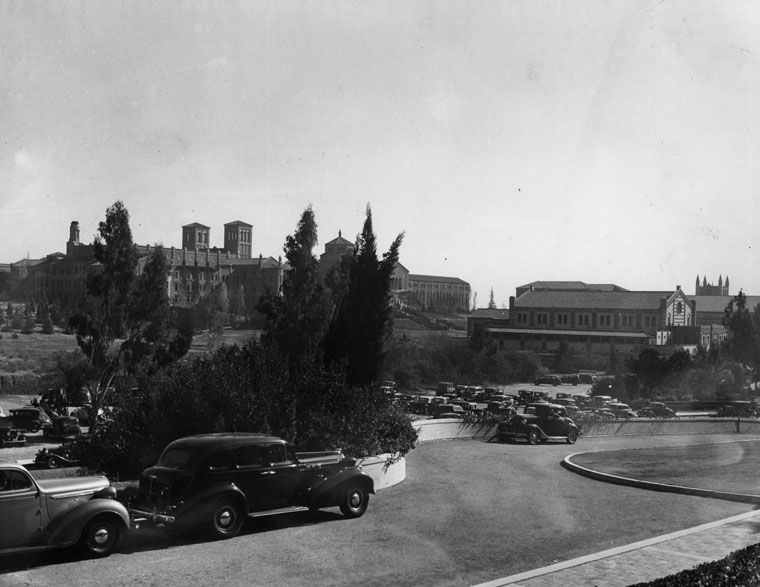 |
|
| (1939)* - View of UCLA's campus buildings, as seen from the northwest. |
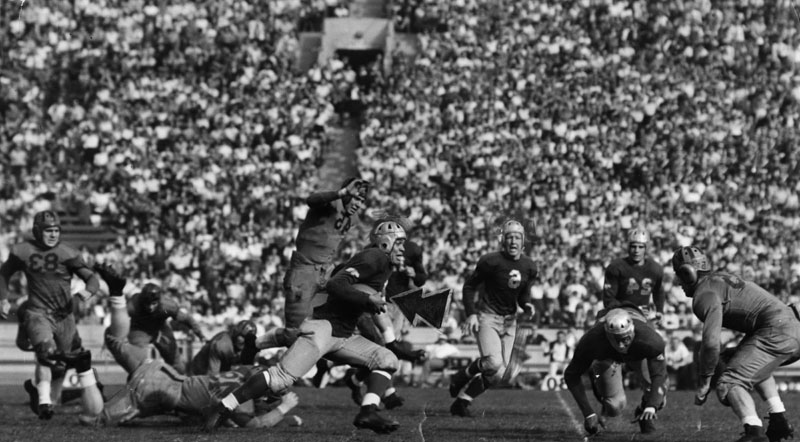 |
|
| (1939)* - The University of California at Los Angeles after trailing California at Berkeley through the first quarter, finally came into its own at the Memorial Coliseum. In this photo, Kenny Washington, brilliant Bruin halfback, is away to a smashing gain as his teammate, Strode, effectively blocks out the California secondary defense. The Washington to Strode combination is a famous one. Photo dated: November 4, 1939. |
Historical Notes Kenny Washington led the nation in total offense and became the first consensus All-American in the history of the school's football program in 1939. He rushed for 1,914 yards in his college career, a school record for 34 years. He was one of four African American players on the 1939 UCLA Bruins football team, the others being Woody Strode, Jackie Robinson and Ray Bartlett. Washington, Strode, and Robinson starred on the 1939 UCLA Bruins football team, in which they made up three of the four backfield players. This was a rarity to have so many African Americans when only a few dozen at all played on college football teams. They played eventual conference and national champion USC to a 0-0 tie with the 1940 Rose Bowl on the line. It was the first UCLA-USC rivalry football game with national implications.*^ |
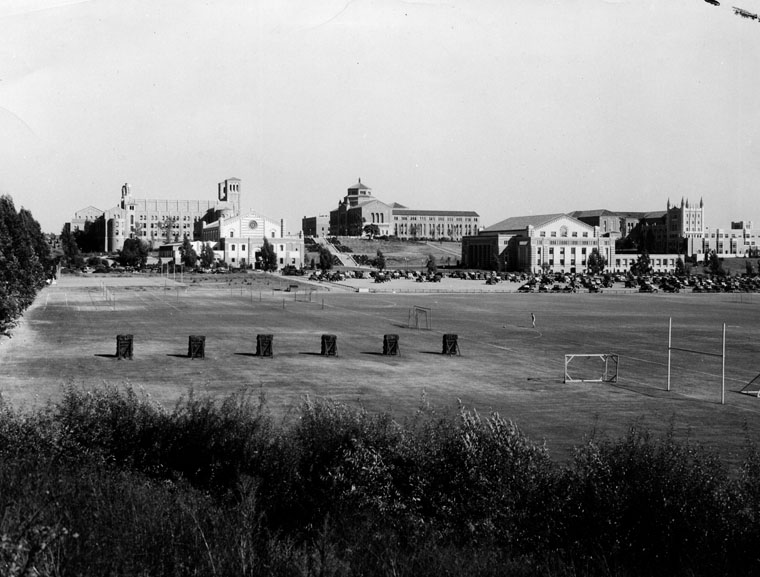 |
|
| (ca. 1940)* - View of UCLA's campus buildings, as seen from the west, across the playing fields. From left to right: Royce Hall, built in 1928-29, and the Women's gymnasium, built in 1932. |
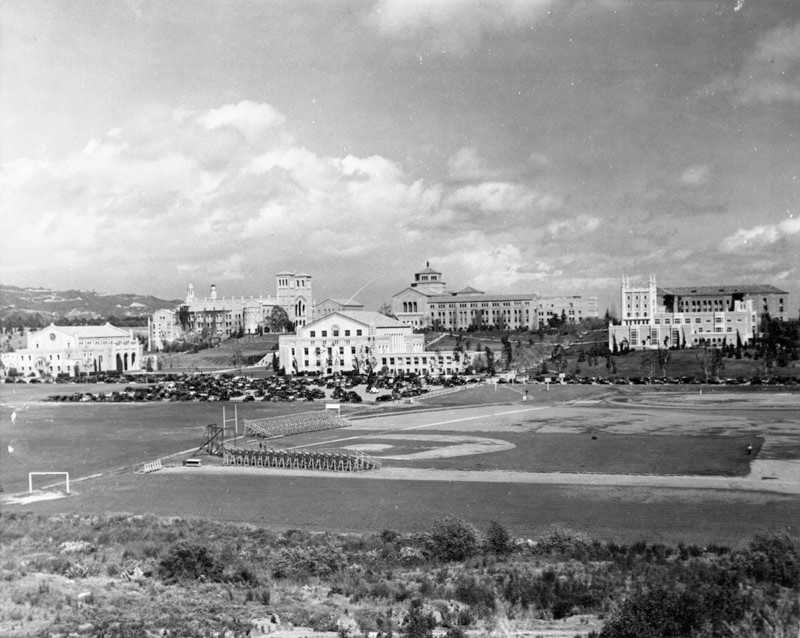 |
|
| (ca. 1940)* - View of UCLA's campus buildings, as seen from the west. |
 |
|
| (1940s)#* – Postcard view looking southeast showing the campus of UCLA with the Powell Library in the distance at center, the backside of Royce Hall at left and the Women's and Men's gym in the foreground at right. Homes can be seen in the hills, and what appear to be oil derricks in the far distance. |
.jpg) |
|
| (ca. 1953)^^ – Aerial view looking west showing the University of California Los Angeles campus with the Sawtelle Reservoir seen at center-right. The two large quads in the foreground at right are situated where a gully once existed with a bridge over it connecting the campus to Hilgard Avenue. |
Before and After
 |
|
.jpg) |
|
| (1929)* vs (ca 1953)^^ - Aerial view looking west of the UCLA campus before and after the gully was filled-in. |
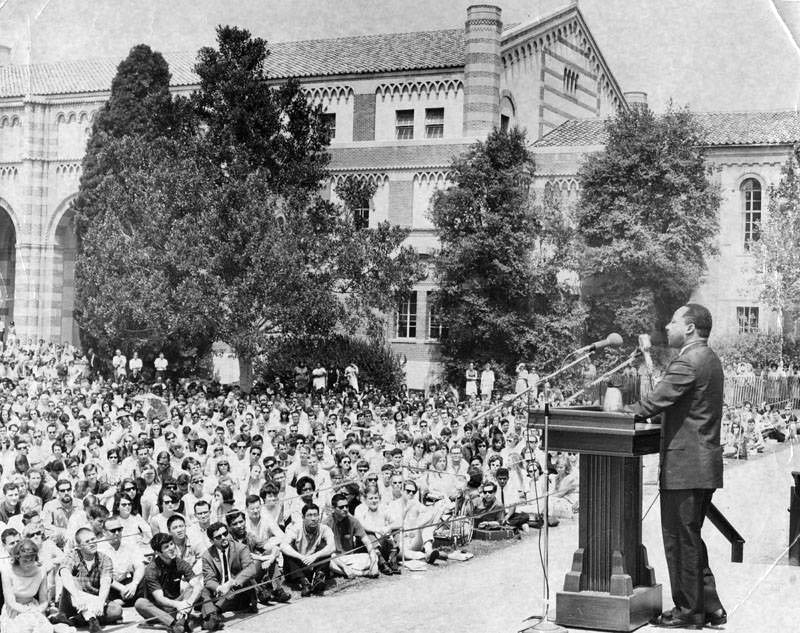 |
|
| (1965)* - Martin Luther King, Jr. speaks to a crowd of 4,500 on the campus of the University of California, Los Angeles in April 1965. |
Historical Notes In this 1965 speech at UCLA, Martin Luther King called for students to join a "Domestic Freedom Corps" to work in 120 counties of the Deep South to help increase the number of registered African American voters.* On October 14, 1964, King received the Nobel Peace Prize for combating racial inequality through nonviolence. In 1965, he and the SCLC helped to organize the Selma to Montgomery marches and the following year, he took the movement north to Chicago to work on segregated housing. In the final years of his life, King expanded his focus to include poverty and speak against the Vietnam War, alienating many of his liberal allies with a 1967 speech titled "Beyond Vietnam". In 1968, King was planning a national occupation of Washington, D.C., to be called the Poor People's Campaign, when he was assassinated on April 4 in Memphis, Tennessee. King was posthumously awarded the Presidential Medal of Freedom and the Congressional Gold Medal. Martin Luther King, Jr. Day was established as a holiday in numerous cities and states beginning in 1971, and as a U.S. federal holiday in 1986.*^ |
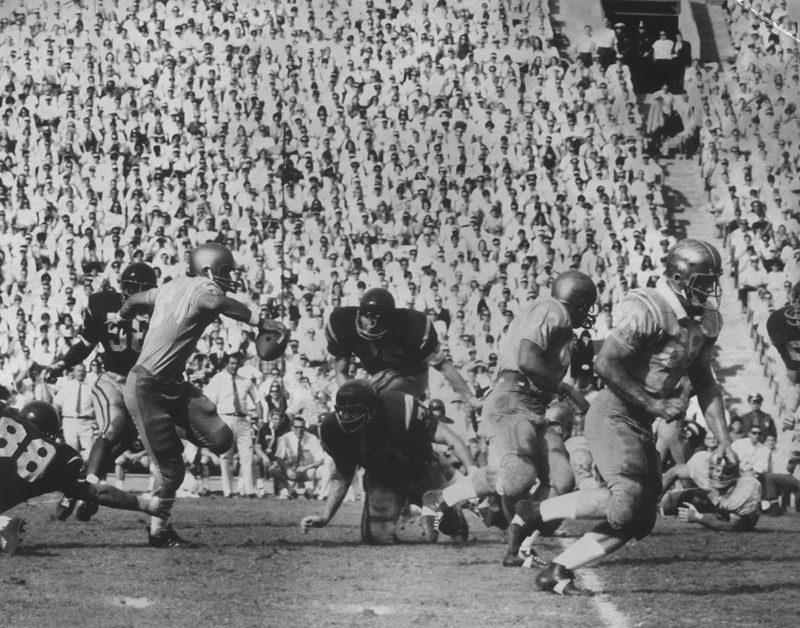 |
|
| (1967)* - When USC met UCLA in 1967, the game wasn't just for cross-town bragging rights. UCLA was undefeated and ranked No. 1 in the nation. Ranked No. 4, USC had one loss. Early in the fourth quarter, UCLA's Gary Beban threw a 20-yard touchdown pass to give the Bruins a 20-14 lead. But on a third-and-eight play late in the fourth quarter, O.J. Simpson broke loose on a 65-yard touchdown run for USC's come-from-behind 21-20 win. Beban did win a consolation prize: he beat out Simpson for the Heisman Trophy. |
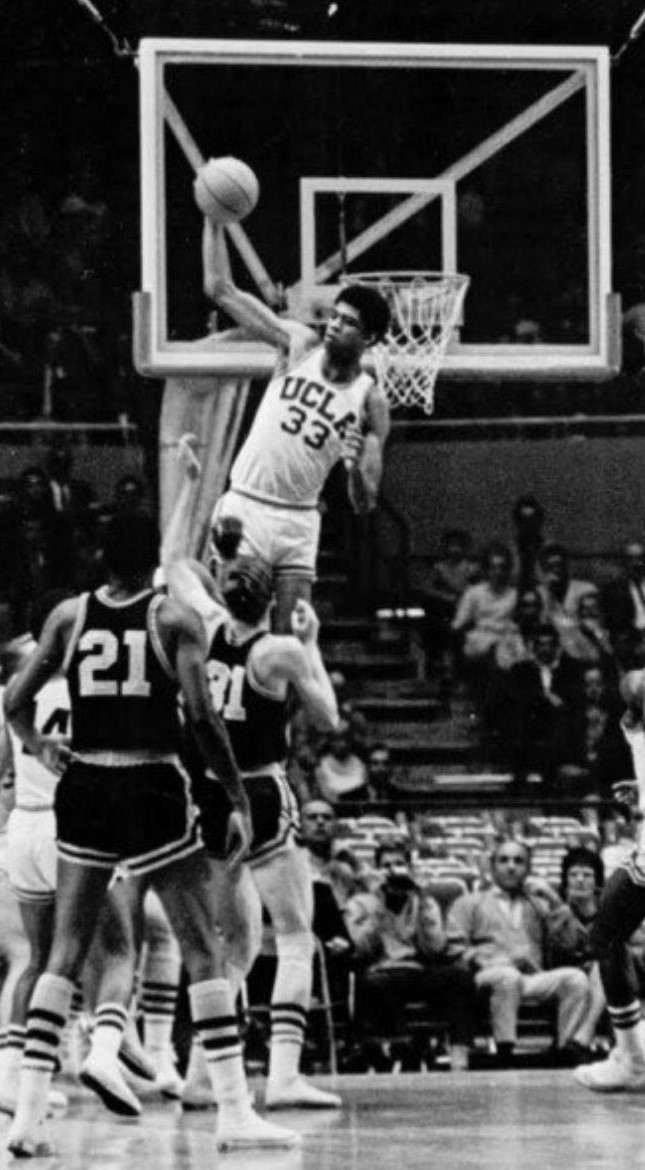 |
|
| (1966)* – Lew Alcindor (aka Kareem Abdul-Jabbar), named “Greatest College Player of All Time”. |
Historical Notes From 1967–69, Lew Alcindor played under coach John Wooden, contributing to the team's three-year record of 88 wins and only two losses: one to the University of Houston in which Alcindor had a not fully healed eye injury, and the other to crosstown rival USC who played a "stall game" (i.e., there was no shot clock in those days, so a team could hold the ball as long as it wanted before attempting to score). In his first college game, Lew set a UCLA single game record with 56 points. The 1965–66 UCLA Bruin team was the preseason #1. But on November 27, 1965, the freshman team led by Alcindor defeated the varsity team 75–60 in the first game in the new Pauley Pavilion. Alcindor scored 31 points and had 21 rebounds in that game. During his college career, Alcindor was twice named Player of the Year (1967, 1969); was a three-time First Team All-American (1967–69); played on three NCAA basketball champion teams (1967, 1968, 1969); was honored as the Most Outstanding Player in the NCAA Tournament (1967, 1968, 1969); and became the first-ever Naismith College Player of the Year in 1969.*^ |
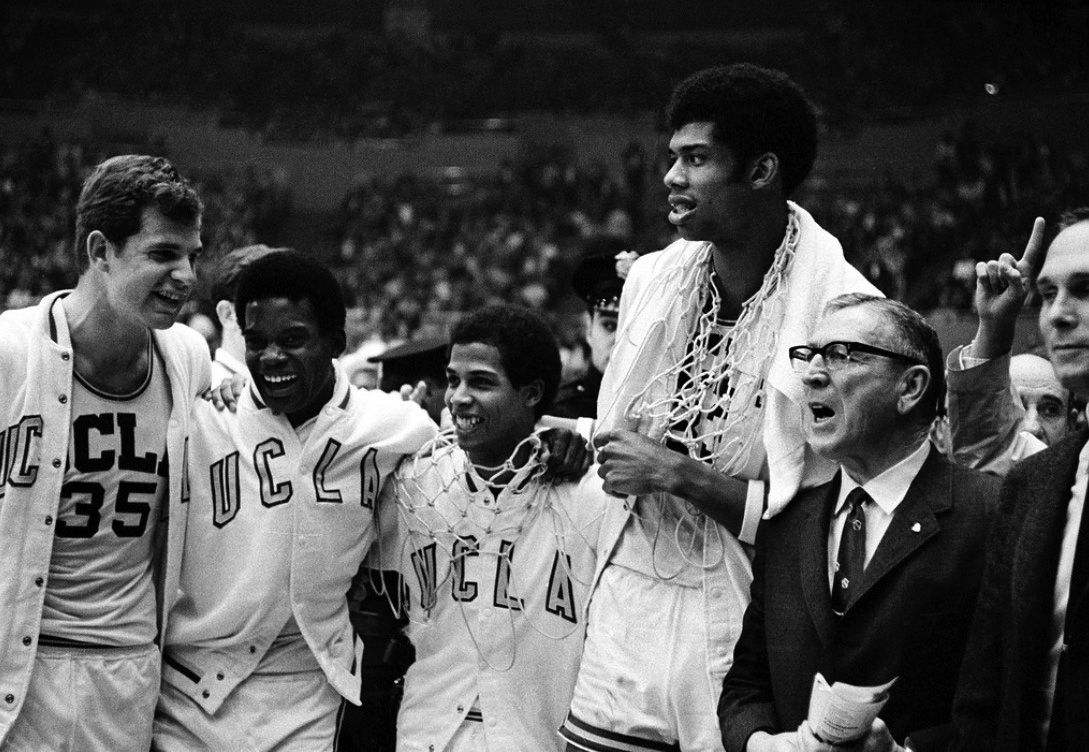 |
|
| (1968)* - UCLA coach John Wooden celebrates with his players, from left, Mike Lynn, Lucius Allen, Mike Warren and Lew Alcindor after the Bruins beat North Carolina, 78-55, to win the NCAA championship final at the Los Angeles Sports Arena, March 23, 1968. |
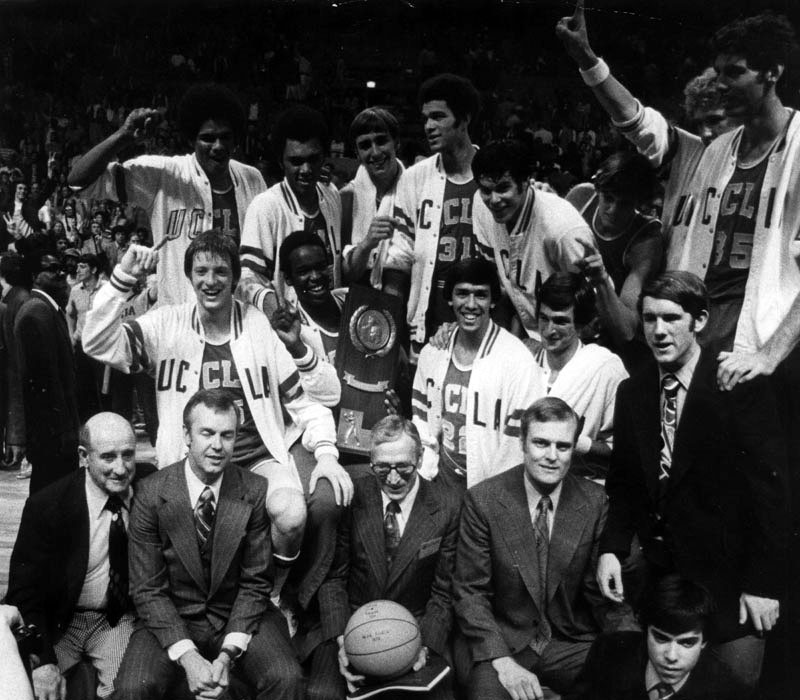 |
|
| (1975)* - This photo was taken after the final game that John Wooden coached--a 92-85 win over the Kentucky Wildcats, to give the Bruins their 10th NCAA title under Wooden. |
Historical Notes Ihe UCLA Bruins have won 125 national championships, including 108 NCAA team championships as of December 2011, more than any other university. UCLA student-athletes have won 214 Olympic medals – 106 gold, 54 silver and 54 bronze. The Bruins have had at least one competitor in every Olympics since 1920 with one exception (1924), and UCLA has won a gold medal in every Olympics since 1932 with the exception of 1980 (boycott).* |
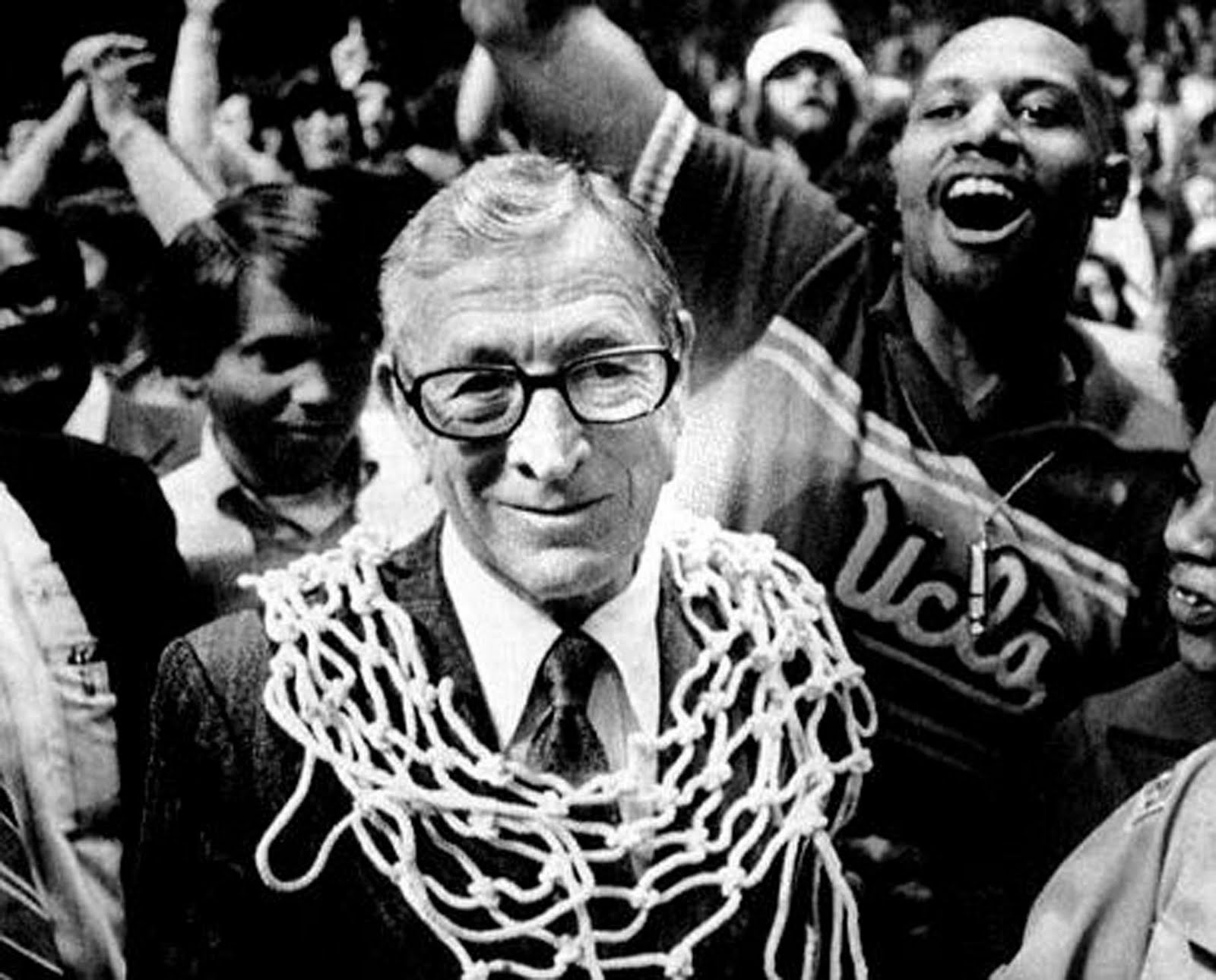 |
|
| (1975)**^ - John Wooden the 'Legend'. “You haven’t taught until they have learned.” With this simple phrase and his dedication to constant improvement, John Wooden sparked a revolution in coaching strategies. |
Historical Notes In some cases, the word "legend" is an understatement. That was the case with former UCLA coach John Wooden, winner of 10 national titles in a 12-year stretch. He'd announced his retirement before the 1975 national title game against Kentucky. The 1974 -75 squad was not Wooden's best -- he didn't have Lew Alcindor or Bill Walton -- but the Bruins' 92-85 win in the national title game that year guaranteed a proper sendoff for Wooden. He left the game on top. Few coaches in any sport can match that.* |
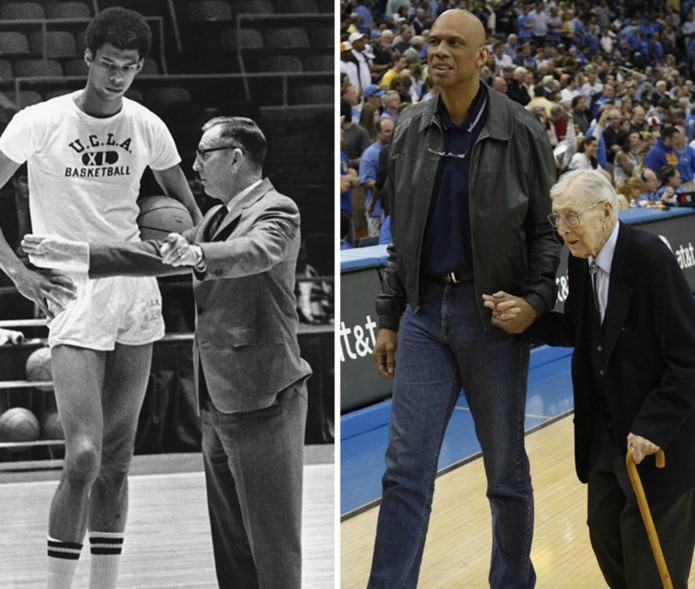 |
|
| (1967 vs. 2010)* - “The effectiveness of a leader is best judged by the actions of the ones he guided.” Priceless pic of love and respect! |
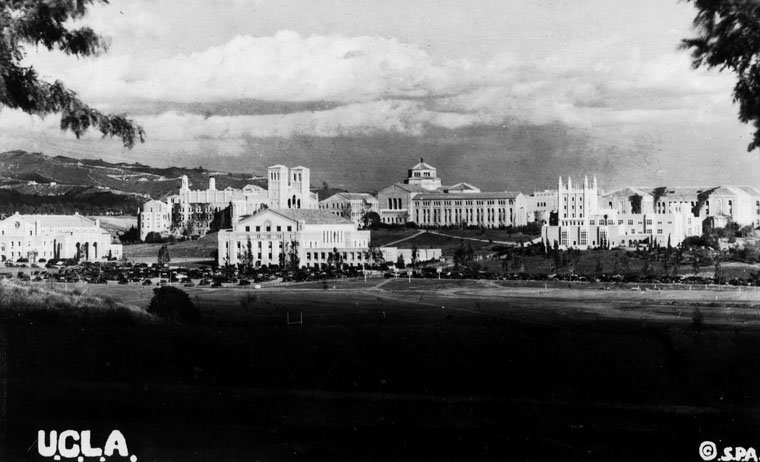 |
|
| (ca. 1930s)* - Postcard view of UCLA's campus buildings, as seen from the southwest. |
Historical Notes After World War II, the architects changed to a less costly and more modern style buildings which still featured red brick. The 1950s and early 1960s saw a building boom that produced more than 60 permanent structures on campus.** |
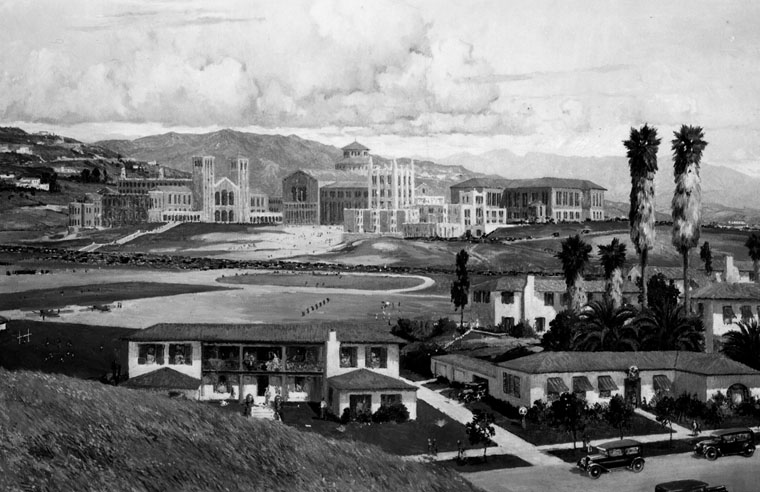 |
|
| (ca. 1930)* - Panoramic view of the UCLA Westwood campus. This is a photograph of a Chris Siemer painting created for a display by the L.A. Chamber of Commerce. |
Westwood Village
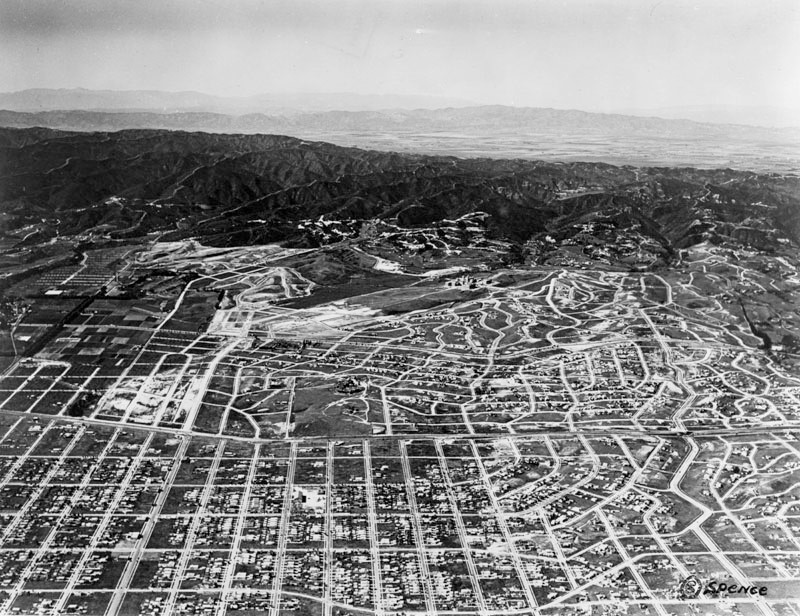 |
|
| (1929)* - Aerial view of Westwood north of Pico Boulevard. The first group of buildings of UCLA are in place, and the streets and blocks of the village are laid out. |
Historical Notes Westwood and UCLA were developed on the lands of the historic 'Wolfskill Ranch', a 3,000-acre parcel that was purchased by Arthur Letts, the successful founder of the Broadway, and Bullock's department stores, in 1919.*^ |
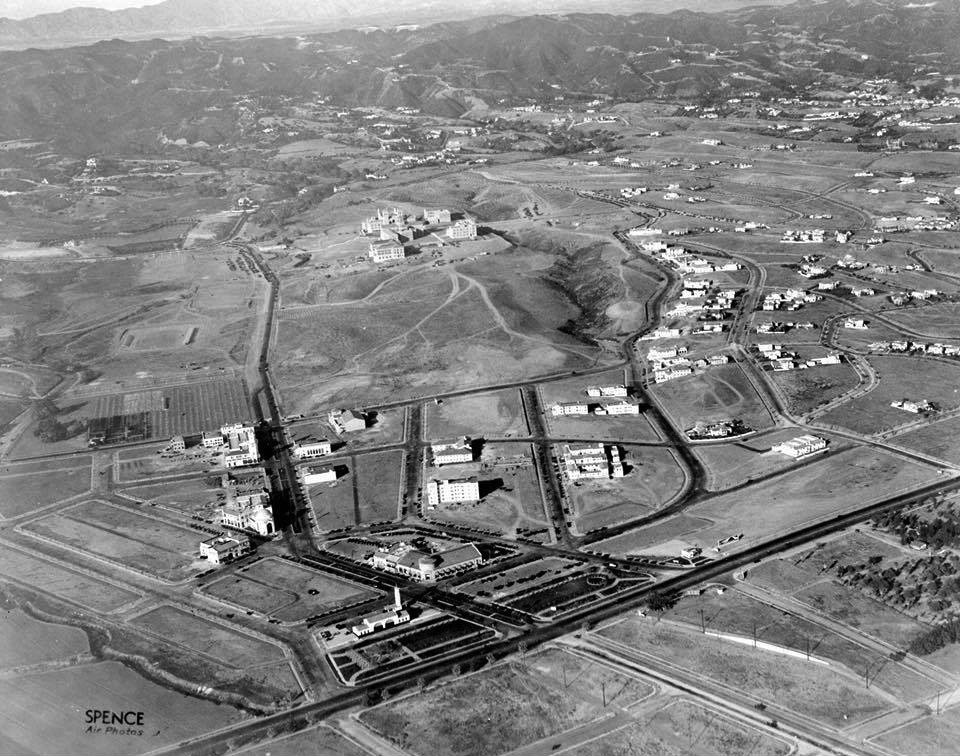 |
|
| (1929)^.^ – Aerial view showing the newly built Westwood Village with the original UCLA buildings seen in the background. |
Historical Notes Westwood Village would contain a unique blend of pedestrian and automobile-oriented development. Wide sidewalks and landscaping were priorities. Corner buildings would be accessible from both streets and interior courtyards. |
 |
|
| (1929)^v^ – Aerial view looking east showing the newly constructed Westwood Village with street names annotated. Wilshire runs away from the camera at far right. |
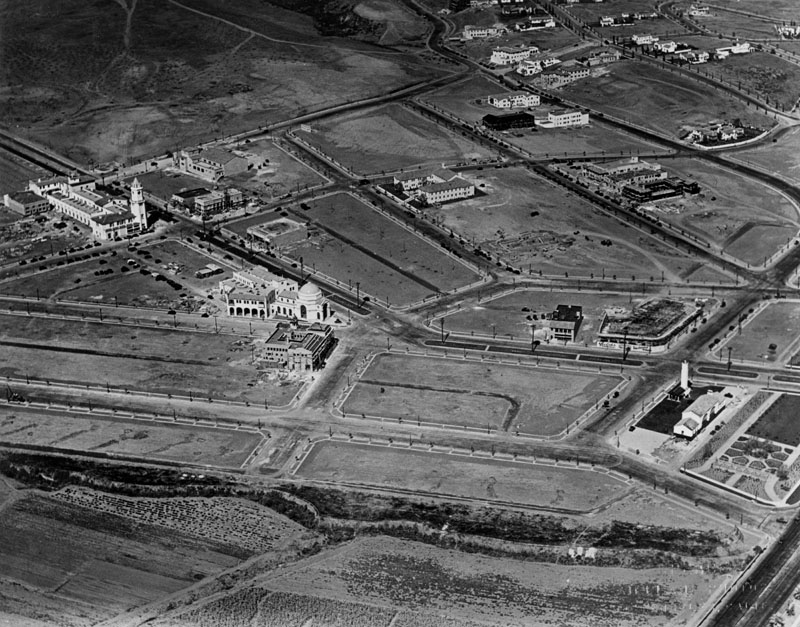 |
|
| (1929)* - Aerial close-up view of Westwood Village, showing the beginning of development but a great deal of open space still. Janss Dome can be seen at center-left. Wilshire is at lower-right. |
Historical Notes Westwood Village was created by the Janss Investment Company, run by Harold and Edwin Janss and their father, Peter, in the late 1920s as an autonomous shopping district and headquarters of the Janss Company. Its boom was complemented by the boom of UCLA (which selected the Westwood Hills as its new home in 1926), developed as a shopping district not just for the residents of Westwood but also for the university.*^ |
.jpg) |
|
| (1929)#^ - View showing Westwood Village under construction. The Janss Dome seen above was the first building to be constructed. When completed in 1930 it would house the headquarters of the Janss Investment Company |
Historical Notes In 1911 Harold Janss married Arthur Letts' daughter Gladys. In 1923 after Arthur Letts, Sr. died, leaving control of the 3,300-acre William Wolfskill ranch on Rancho San Jose de Buenos Ayres to Harold and Gladys Janss. Through a three-way deal with the State of California and the cities of Los Angeles, Santa Monica, and Beverly Hills, the UCLA campus was built. Janss Investment Company went to work in parallel developing the Westwood Village commercial area and surrounding residential neighborhoods.*^^ |
 |
|
| (1929)#* - A panoramic view of Westwood. The area in the foreground is mostly open fields, but beyond that Westwood Village is under construction. There are several tree-lined streets laid out, but only a few large buildings are under construction. There are numerous houses in the distance beyond that, and the beginnings of the University of California, Los Angeles, campus in the distance on the left. |
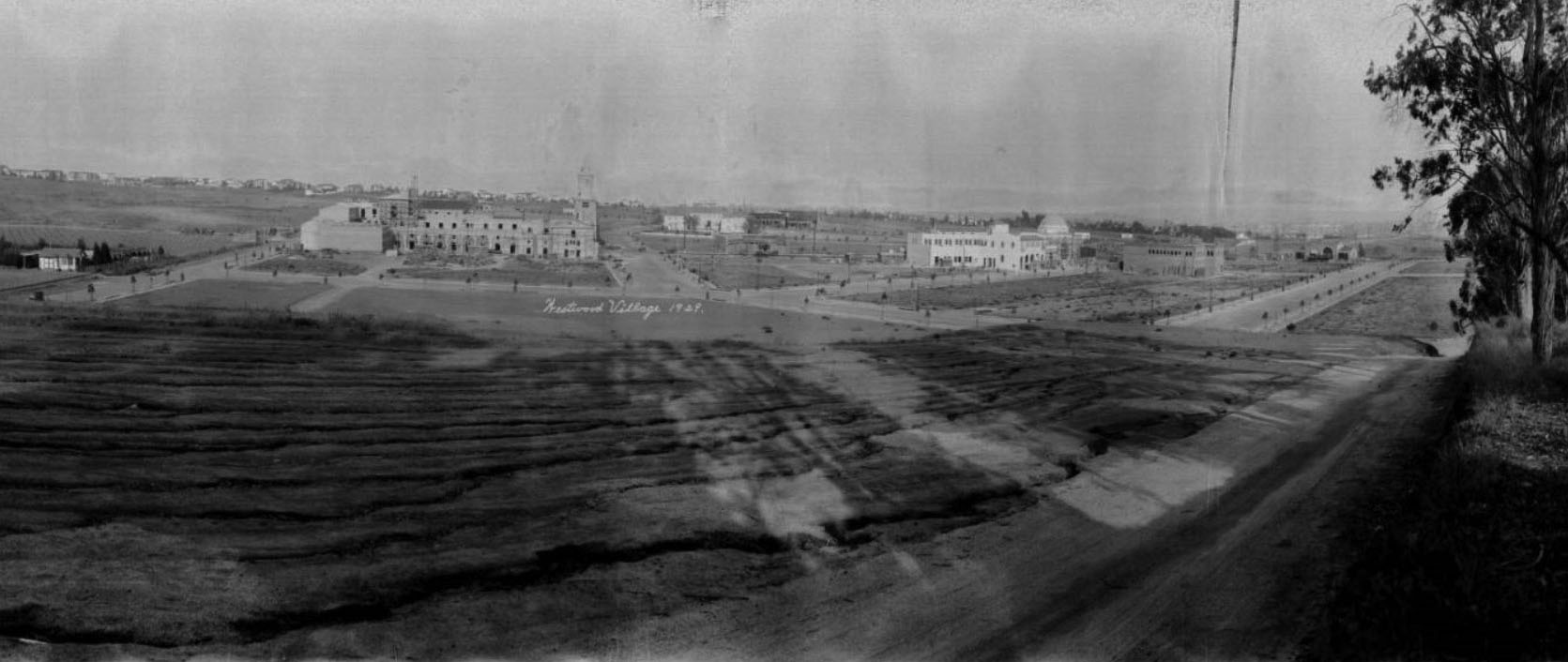 |
|
| (1929)#* - Panoramic view showing Westwood Village under construction. Note the open fields surrounding the development. |
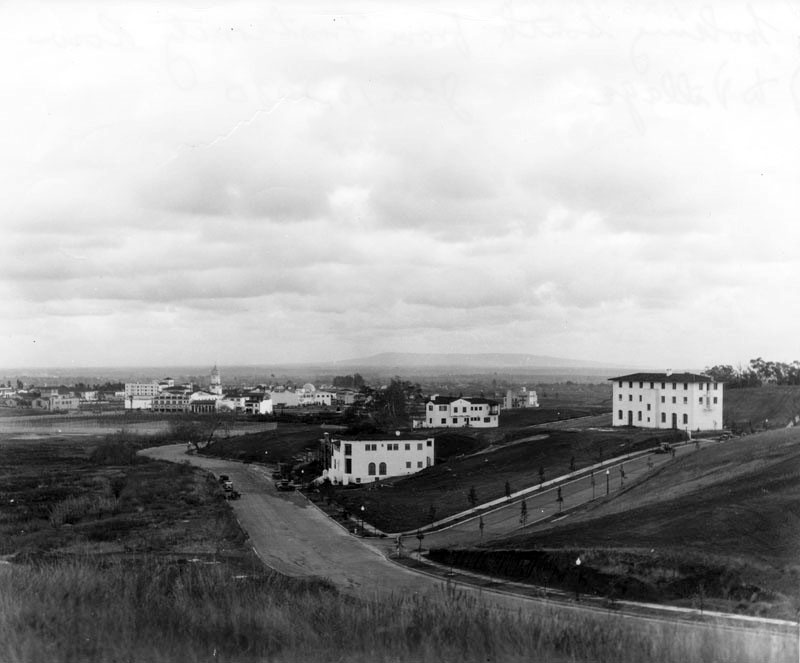 |
|
| (1930)* - View of Westwood Village on January 10, 1930, looking south from UCLA's Fraternity Row. |
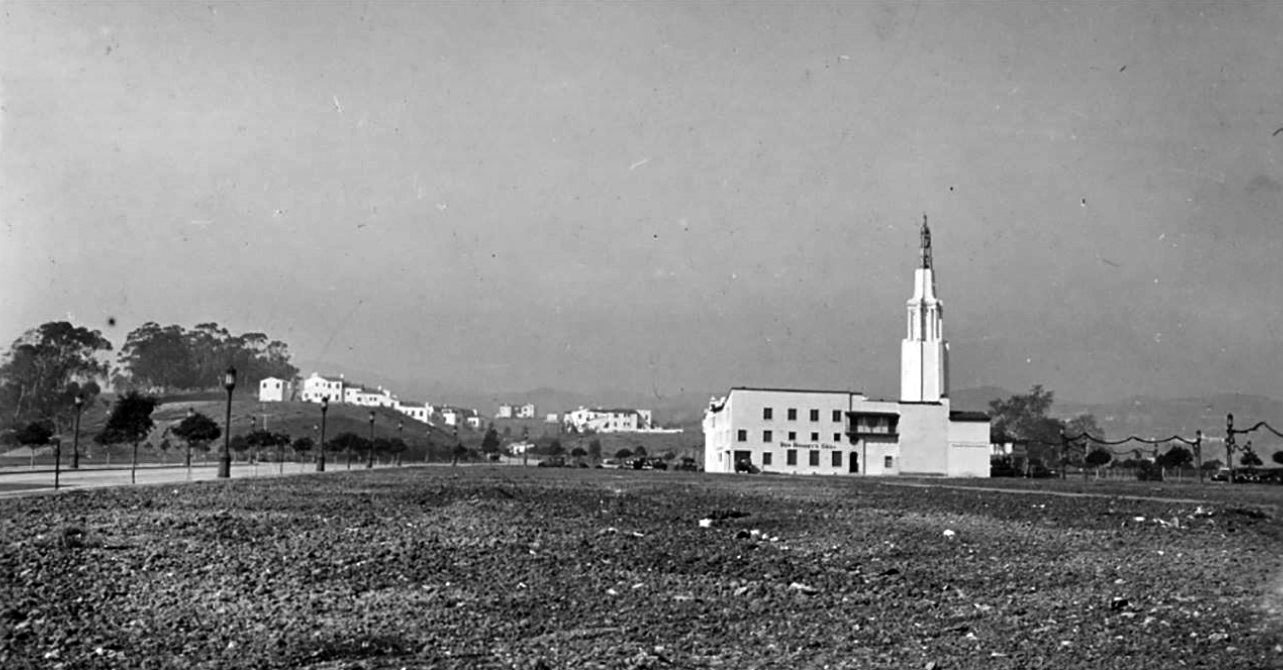 |
|
| (1932)^x^ – Panoramic view looking north toward the Westwood Fox Theatre (built in 1931) with UCLA’s Fraternity Row on the hill in the background. Gayley Avenue is seen at left. Note the amount of undeveloped land in the foreground. |
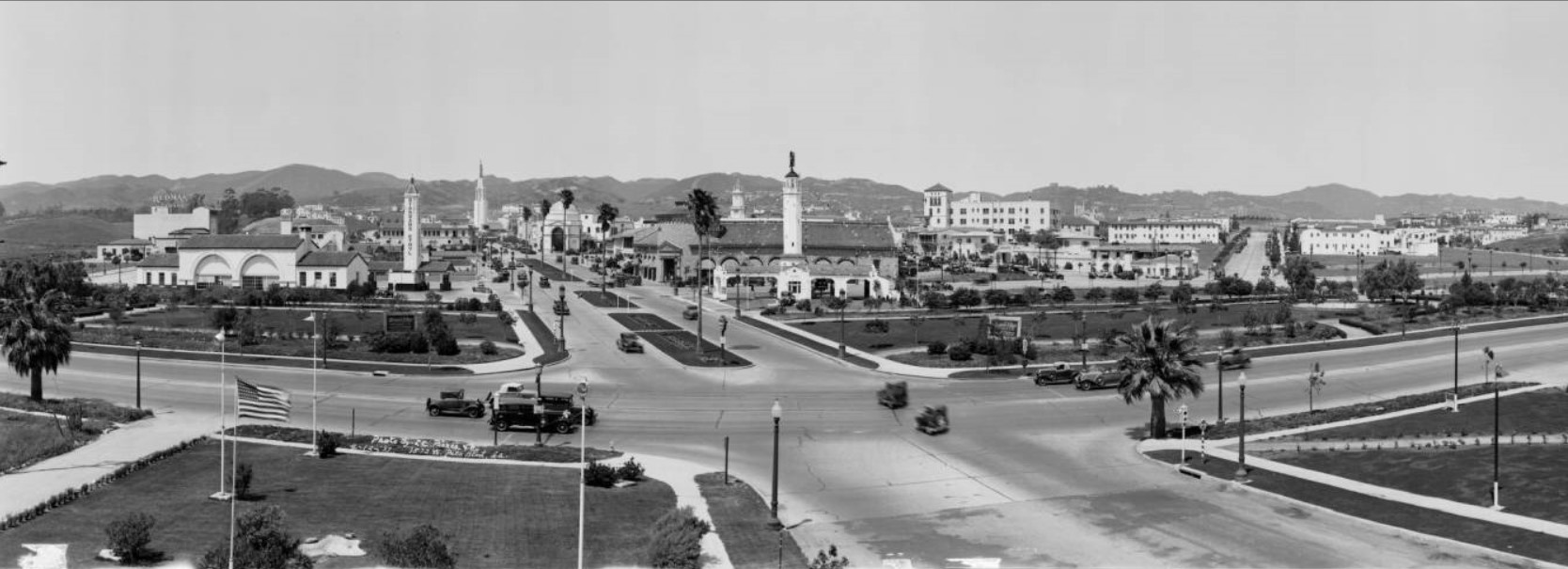 |
|
| (1932)#* - Panoramic view of Westwood facing north at the intersection of Wilshire and Westwood. Wilshire runs the width of the image, in the foreground. Westwood, with palm trees planted in the dividers, goes into the distance, past a variety of stores, including a Ralphs, gas stations, and Janss Dome. |
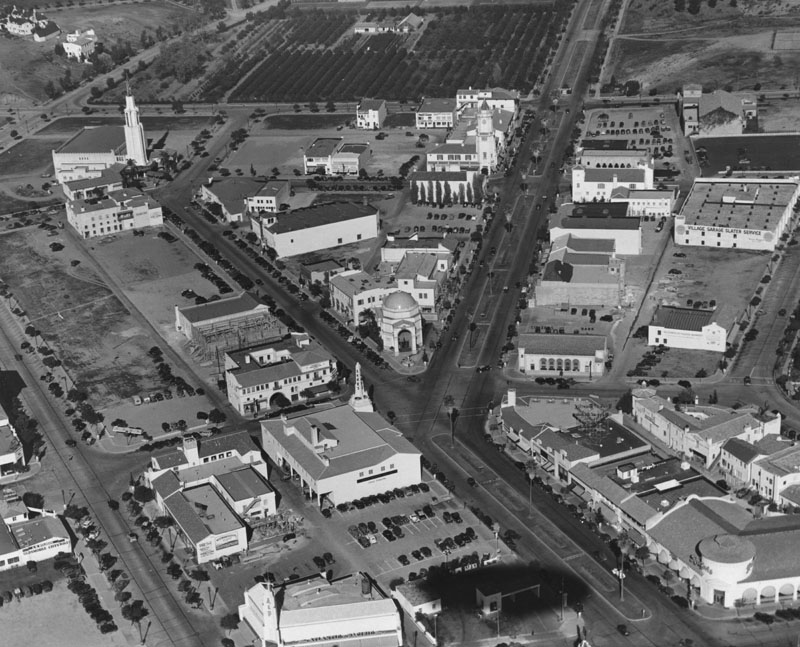 |
|
| (1936)* - Aerial view of Westwood Village from a blimp. The Fox Theater is on the upper left, Ralphs lower right. At upper center is the Holmby Building with its clock tower. At center of photo, where Westwood Boulevard intersects Broxton Avenue, sits the Janss Dome Building, built in 1929. |
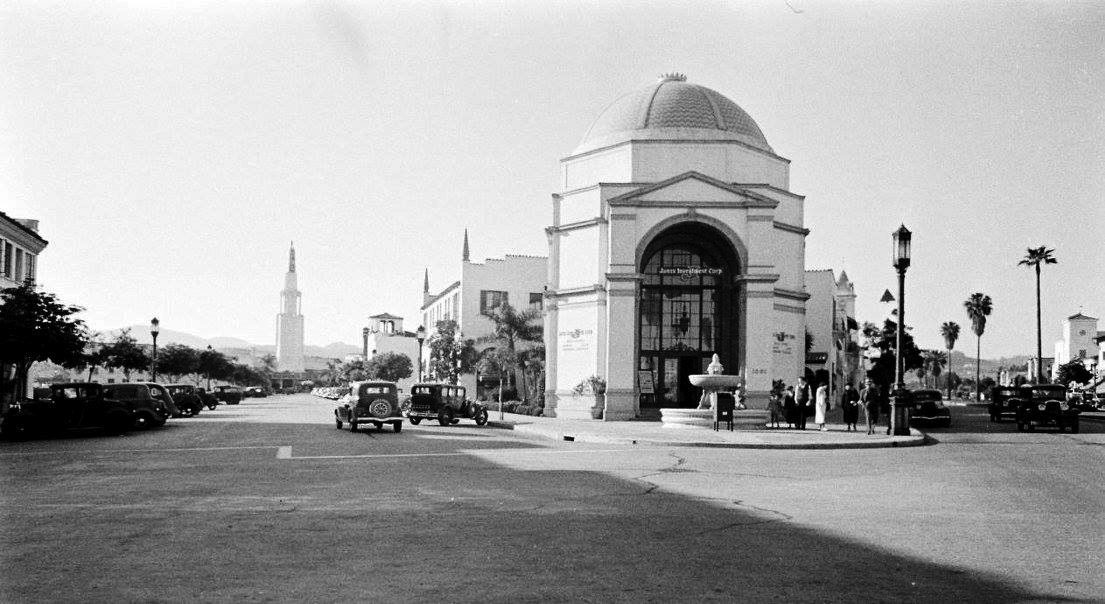 |
|
| (1930s)**# – Panoramic view looking north showing the beautiful Bank of America Building (aka Janss Dome) at the intersection of Broxton Ave (left) and Westwood Boulevard (right). The iconic tower of the Fox Theatre can be seen at the end of Broxton Ave. |
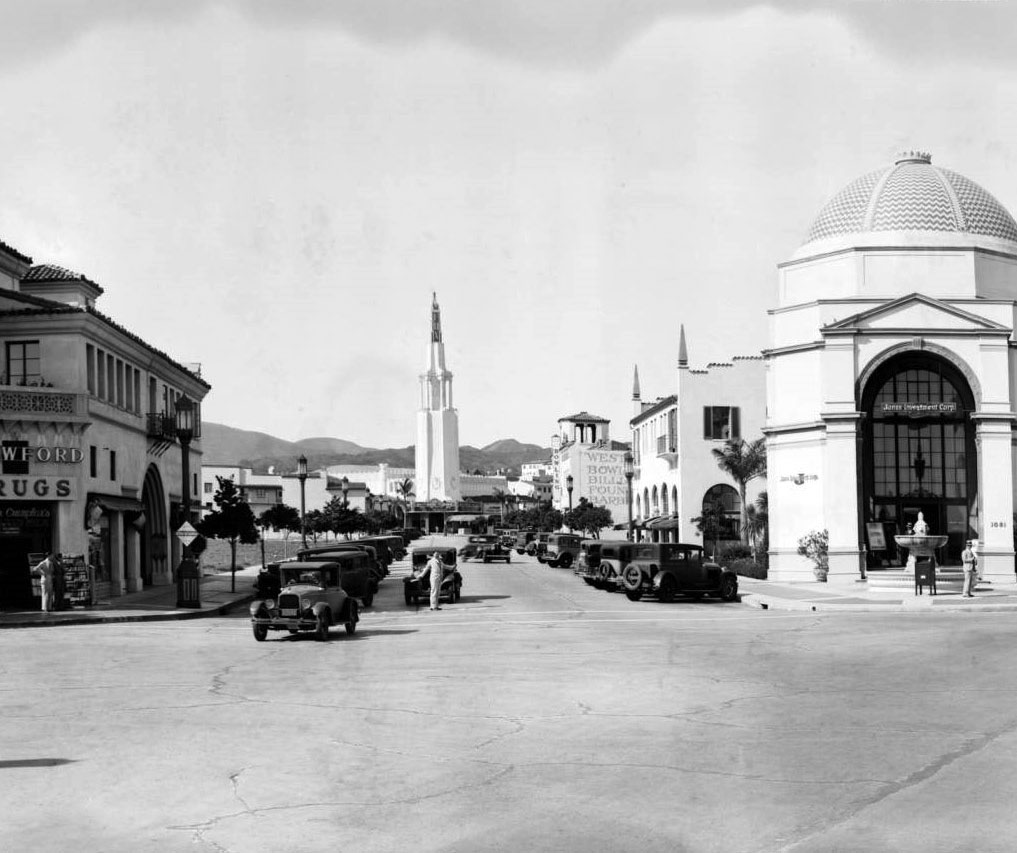 |
|
| (1932)#* - View looking north on Broxton Avenue with the tower of the Fox Theatre in the distance and the Janss Dome on the right. |
Historical Notes The Janss Dome ranks alongside the white Spanish Revival/Moderne tower of the Fox Theater as an iconic landmark of Westwood Village. |
 |
|
| (1932)#* - A panoramic view of Westwood Village in Westwood, Los Angeles. The domed building in the center is the Janss Investment Corp., and the road to the right of it is Westwood. Left of that is the University Professional Building, with Crawford Drugs at the corner on the ground level. The spire down the street between Janss and the Professional building is the Fox Theatre. Across Westwood from Janss is the Citizens National Trust & Savings Bank. On the west side of Westwood in the background is the tower of the Holmby Building. The cross street is now Kinross Avenue, while the street leading to the theater is Broxton. |
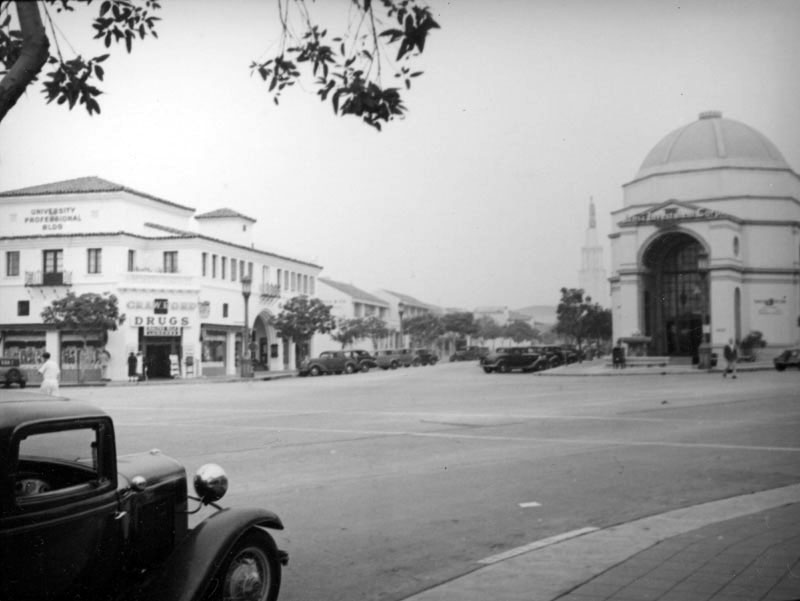 |
|
| (ca. 1940)*- View of Westwood Boulevard, Westwood Village, showing Crawford Drugs and the Janss Dome housing Janss Investment Company--the developers of Westwood. |
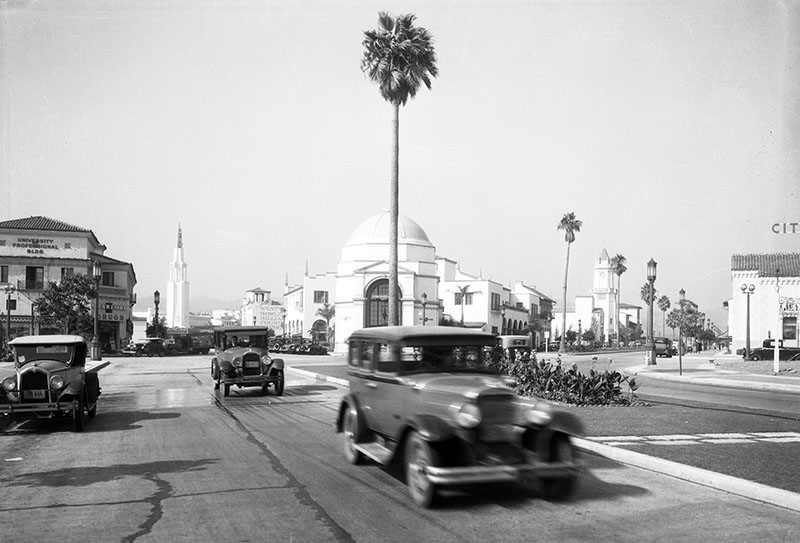 |
|
| (1932)* - View looking north up Westwood Boulevard from south of Kinross Avenue. |
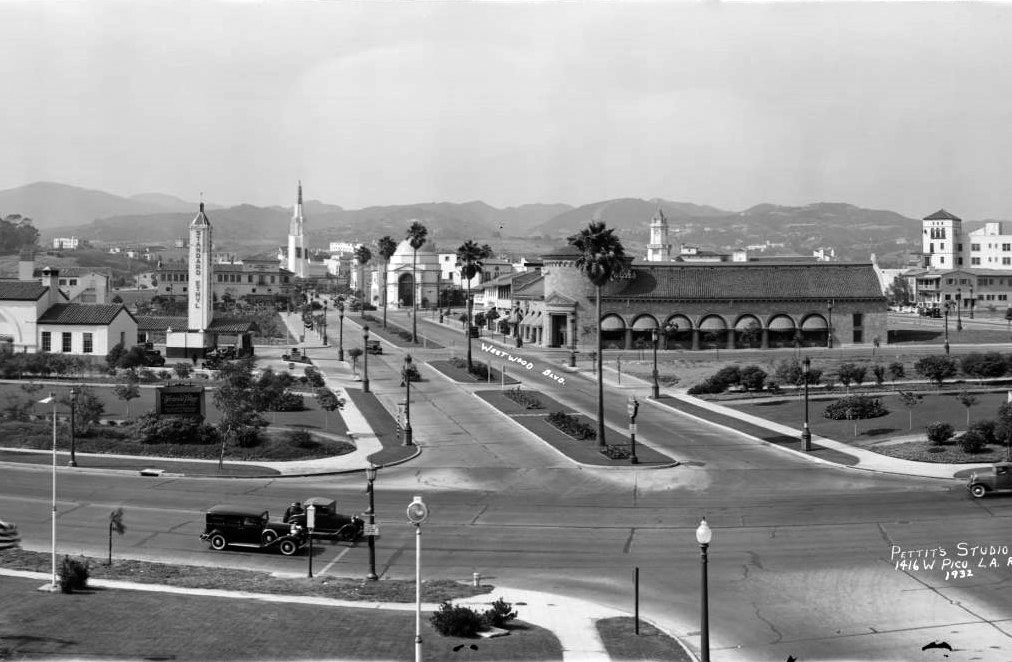 |
|
| (1932)#* – View looking north showing the intersection of Wilshire and Westwood boulevards. In the distance can be seen the four major landmarks of Westwood Village. The Fox Theatre, Janss Dome, Ralphs Market and the Holmby Building. |
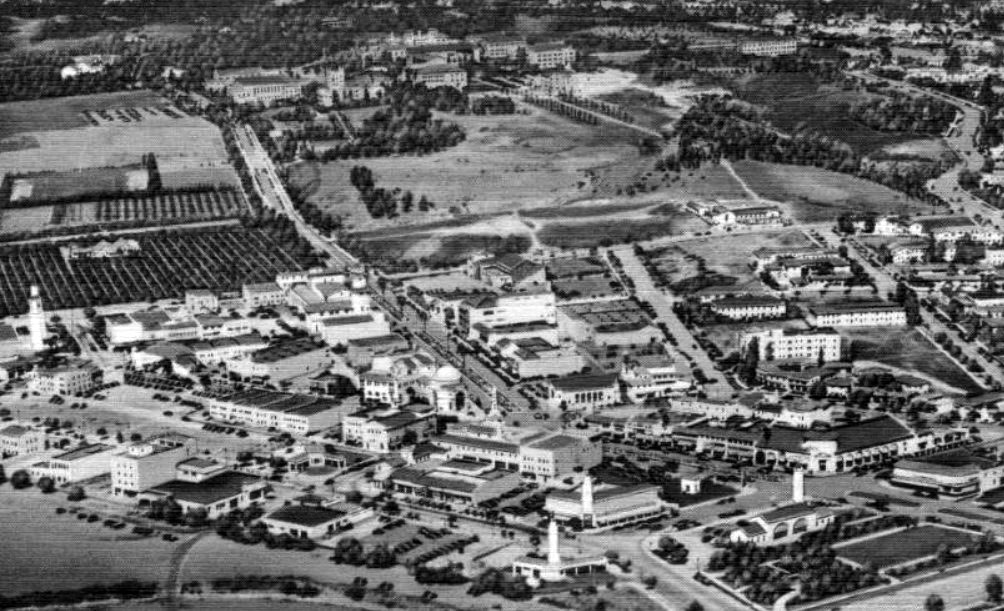 |
|
| (1939)## – Postcard view of Westwood Village showing the University of California (UCLA) in the background. |
Historical Notes Back of postcard reads: Westwood is a district 13 miles west of downtown Los Angeles, and includes the campus of the University of California, Los Angeles (UCLA), a residential neighborhood, and Westwood Village, a shopping district. Clustered around its central thoroughfare of Westwood Boulevard, the shopping district serves the affluent neighborhoods of Bel Air and Westwood to the north, as well as students from UCLA. ## |
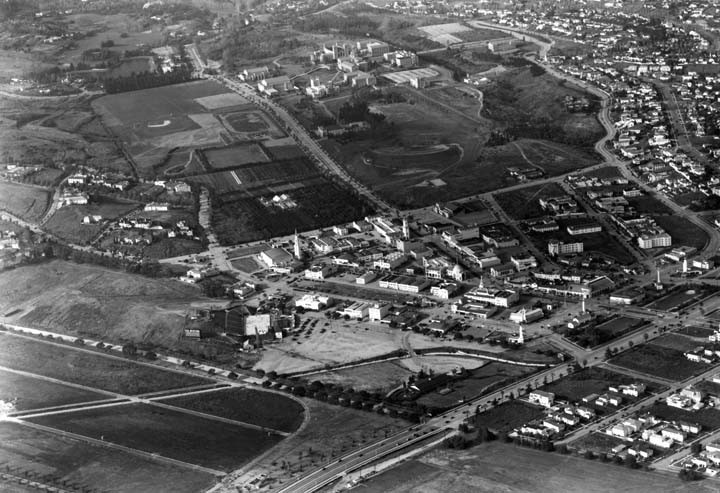 |
|
| (1940)#^ – Aerial view looking northeast showing a built-up Westwood Village. The UCLA campus can be seen in the distance. |
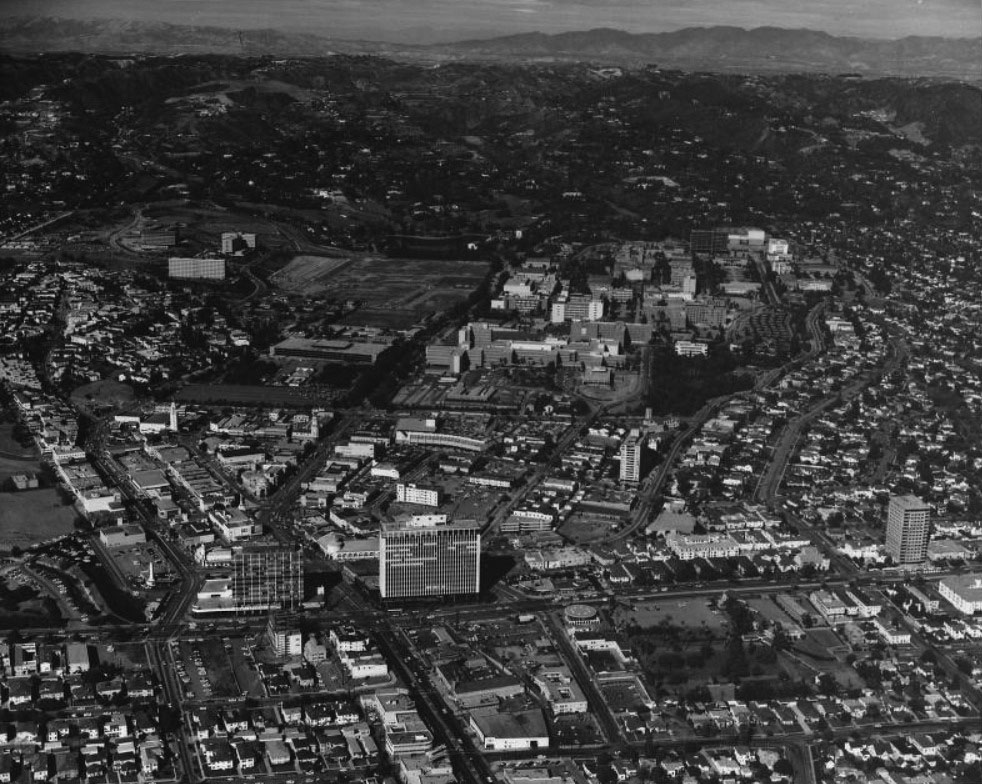 |
|
| (1966)^^ – Aerial view looking north showing the two new high-rises at the intersection of Wilshire and Westwood boulevards (lower center-left) with Westwood Village and the UCLA campus seen further back. |
Click HERE to see more Early Views of Westwood |
* * * * * |
Please Support Our CauseWater and Power Associates, Inc. is a non-profit, public service organization dedicated to preserving historical records and photos. Your generosity allows us to continue to disseminate knowledge of the rich and diverse multicultural history of the greater Los Angeles area; to serve as a resource of historical information; and to assist in the preservation of the city's historic records.
|
More Historical Early Views
Newest Additions
Early LA Buildings and City Views
History of Water and Electricity in Los Angeles
* * * * * |
References and Credits
* LA Public Library Image Archive
#*Huntington Digital Library Archive
#^California State Library Image Archive
^# Skyscraperpage - Noirish Los Angels: Rancho San Jose de Buenos Ayres; Westwood-Life Magazine; Janss Steps; Westwood Observation Tower
^*^Alumni.ucla.edu: UCLA History - A Bridge to the Future; UCLA History Timeline
**^The Sports IQ: John Wooden's Legacy
**#Facebook.com: Garden of Allah Novels, Martin Turnbull
***ESPN: NCAA Tournament - The Top 75 Moments
*^^Facebook.com - Vintage L.A.: Westwood Boulevard
^^*Facebook.com - Bizzare Los Angeles
^^#Facebook.com - Matrin Turnbull
^^^Flickr.com: Michael Ryerson
^x^Facebook.com
#^^Flickr.com
*#^Historylosangeles.blogspot.com: Ice Skating in Westwood
^#*Campus Destinations: UCLA Kerckhoff Hall
^#^Oldhomesoflosangeles.blogspot.com: Arthur Letts Holmby House
*^*Facebook.com - City of Angels: Westwood Village, ca.1937
*#*Facebook.com - Classic Hollywood/Los Angeles/SFV: Lew Alcindor; UCLA vs. Huston; Le Conte and Westwood
*^ Wikipedia: Janss Investment Company; Westwood; Westwood Village; UCLA; History of UCLA; Kenny Washington Holmby Hall; FOX Theatre, Westwood Village; Janss Investment Company Building; William G. Kerckhoff; Glorya Kaufman; Janss Dome; Marymount High School; Martin Luther King, Jr.; Kareem Abdul-Jabbar; Westwood Ralphs Market
< Back
Menu
- Home
- Mission
- Museum
- Major Efforts
- Recent Newsletters
- Historical Op Ed Pieces
- Board Officers and Directors
- Mulholland/McCarthy Service Awards
- Positions on Owens Valley and the City of Los Angeles Issues
- Legislative Positions on
Water Issues
- Legislative Positions on
Energy Issues
- Membership
- Contact Us
- Search Index